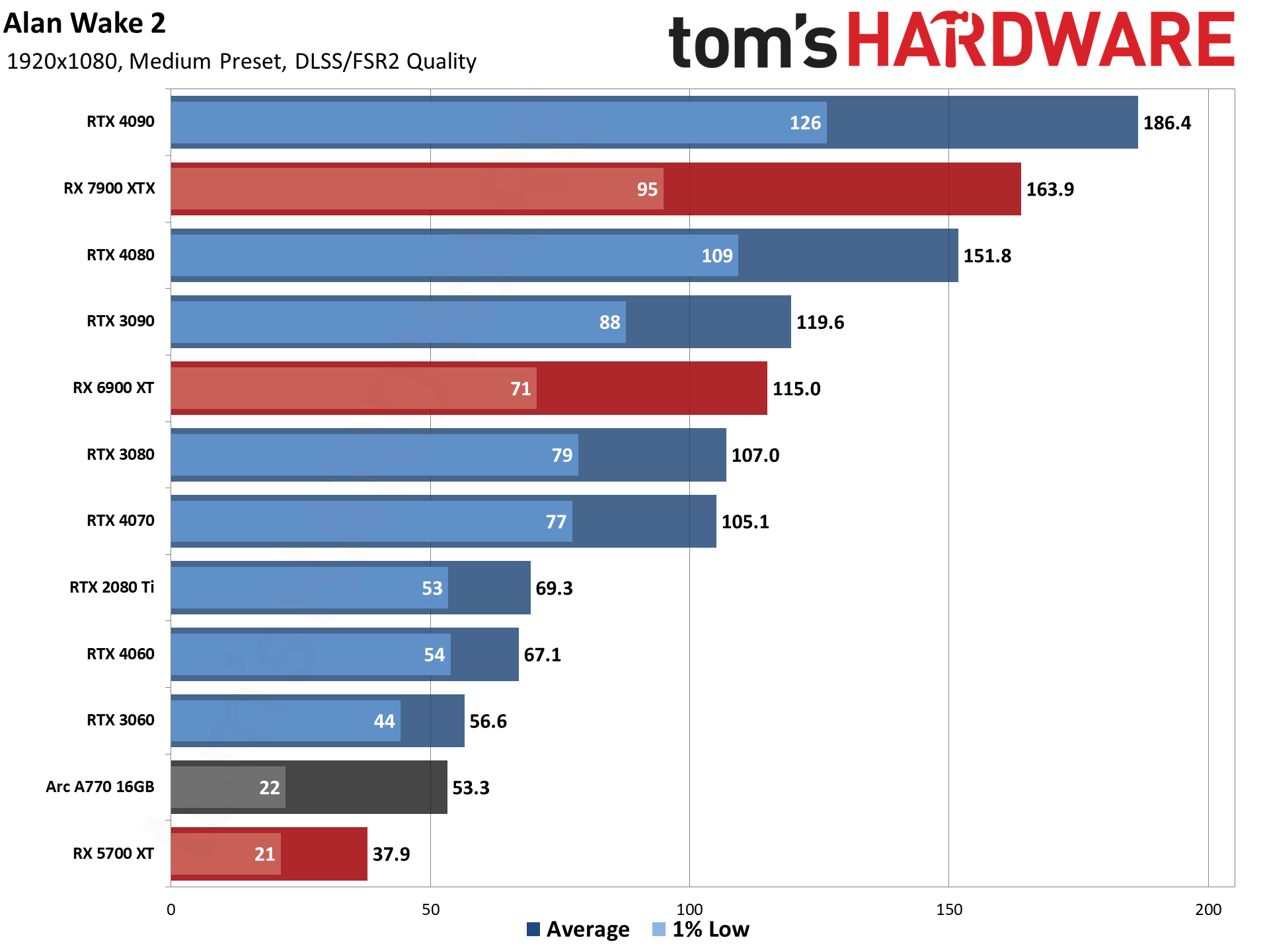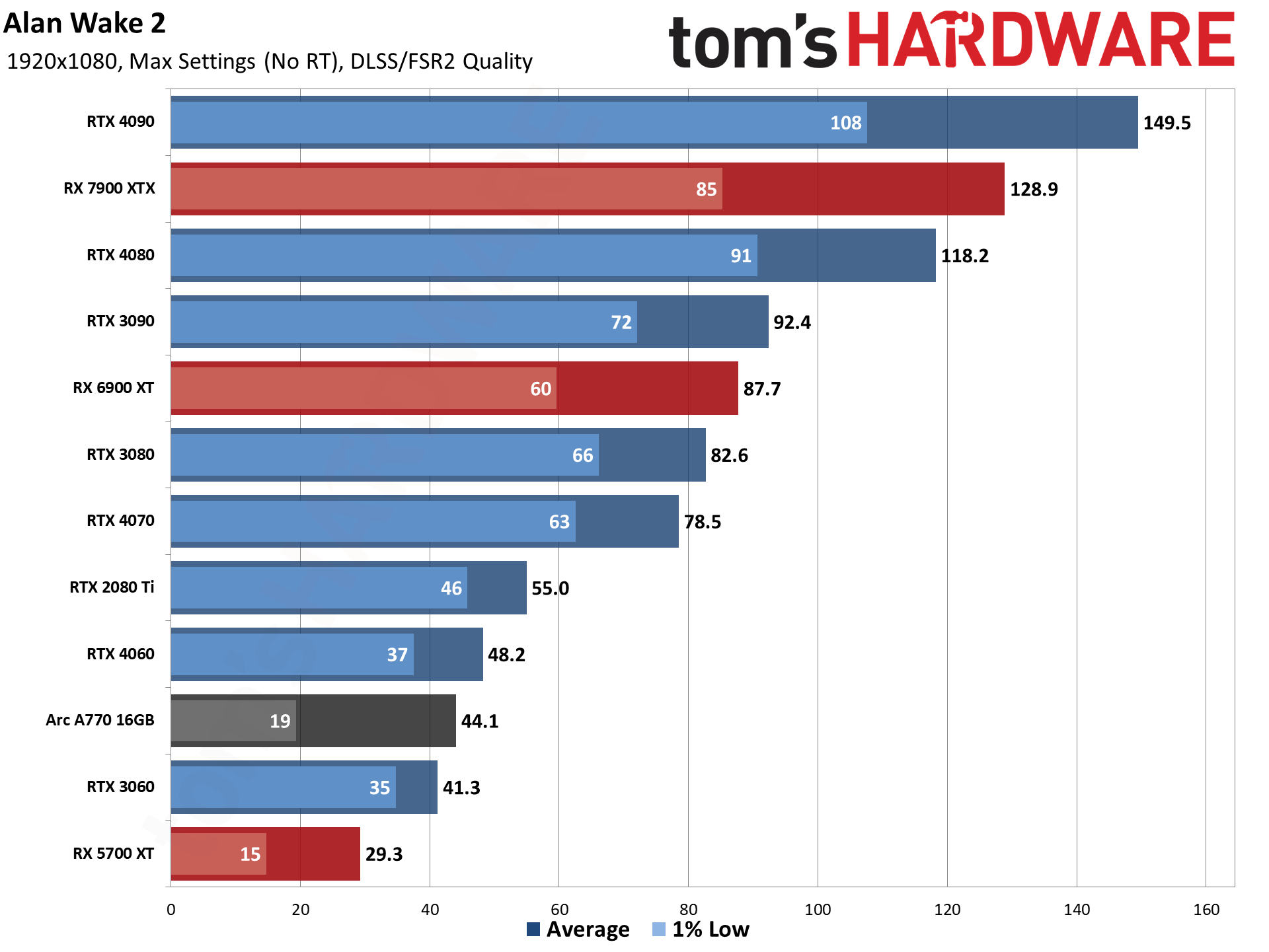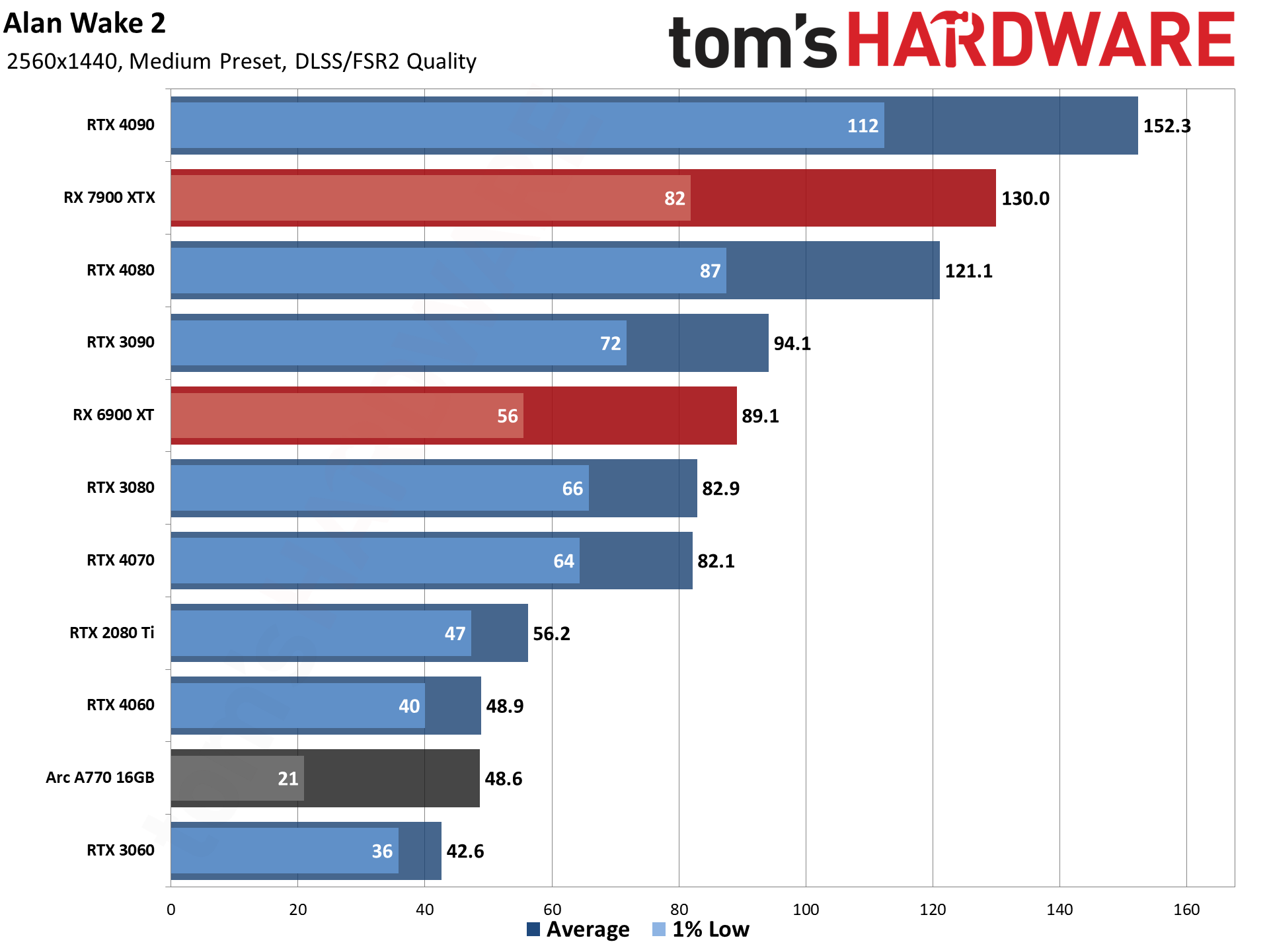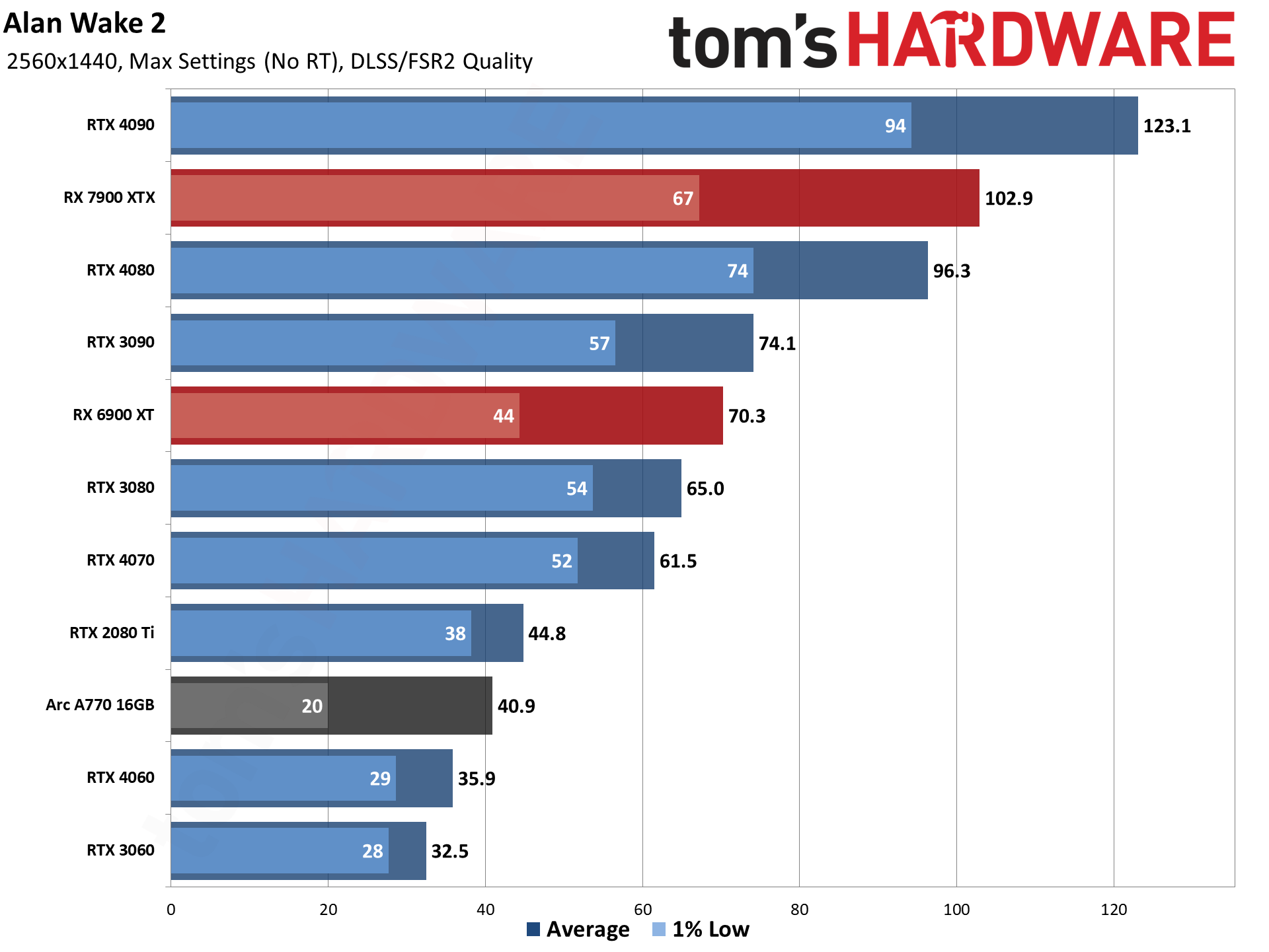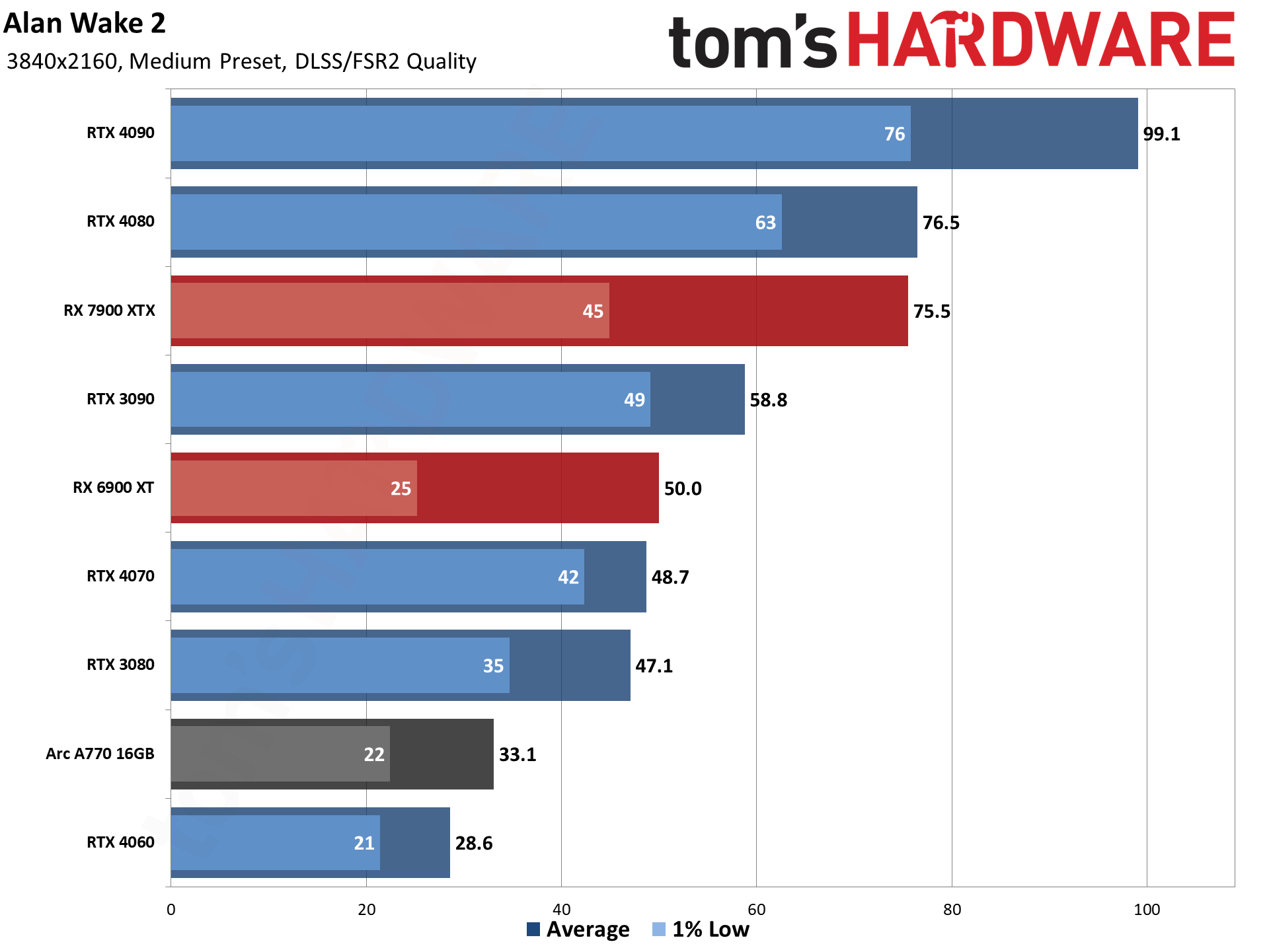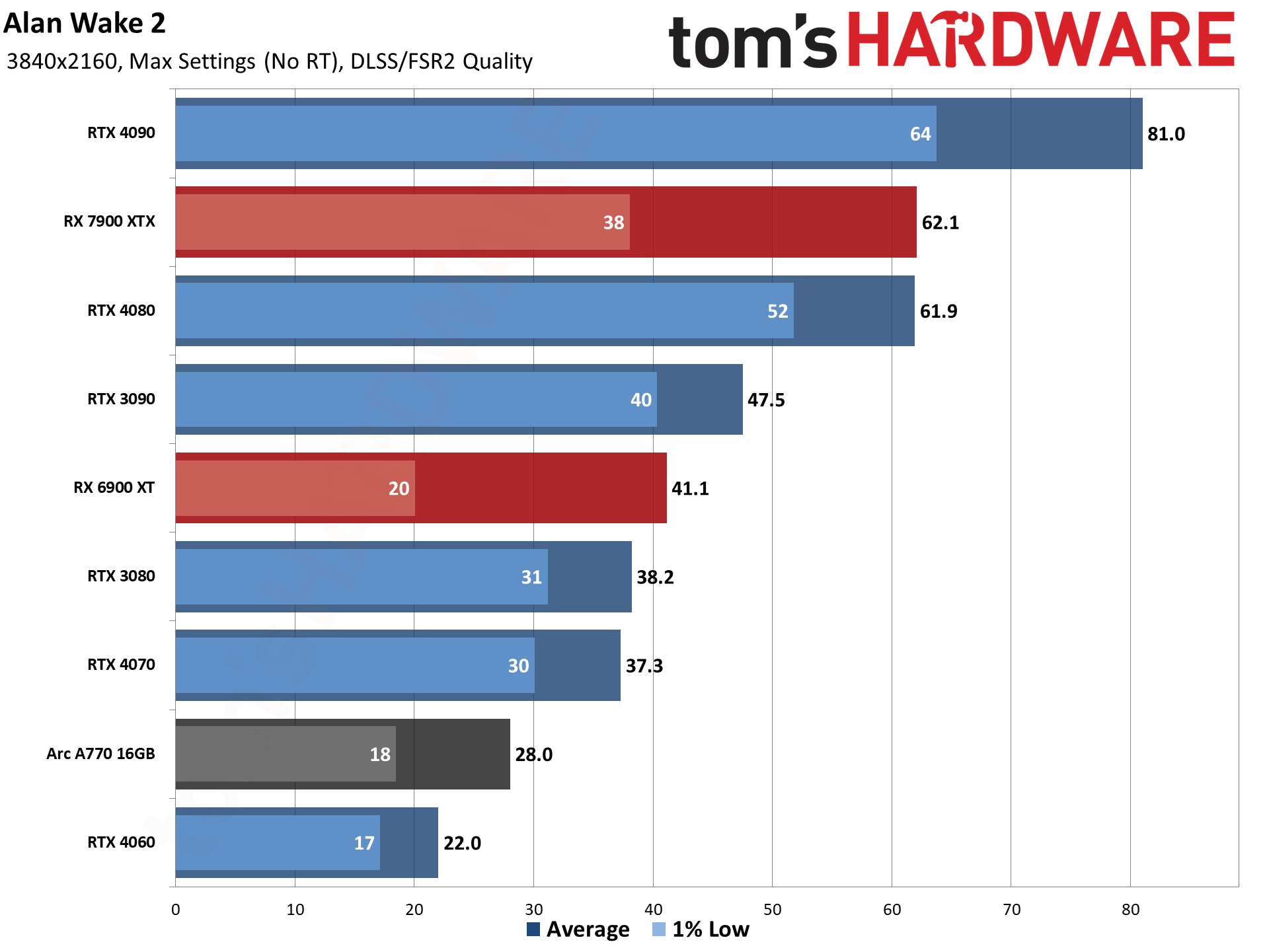Testing Alan Wake 2: Full Path Tracing and Ray Reconstruction Will Punish Your GPU
The first game to launch with full ray tracing support.
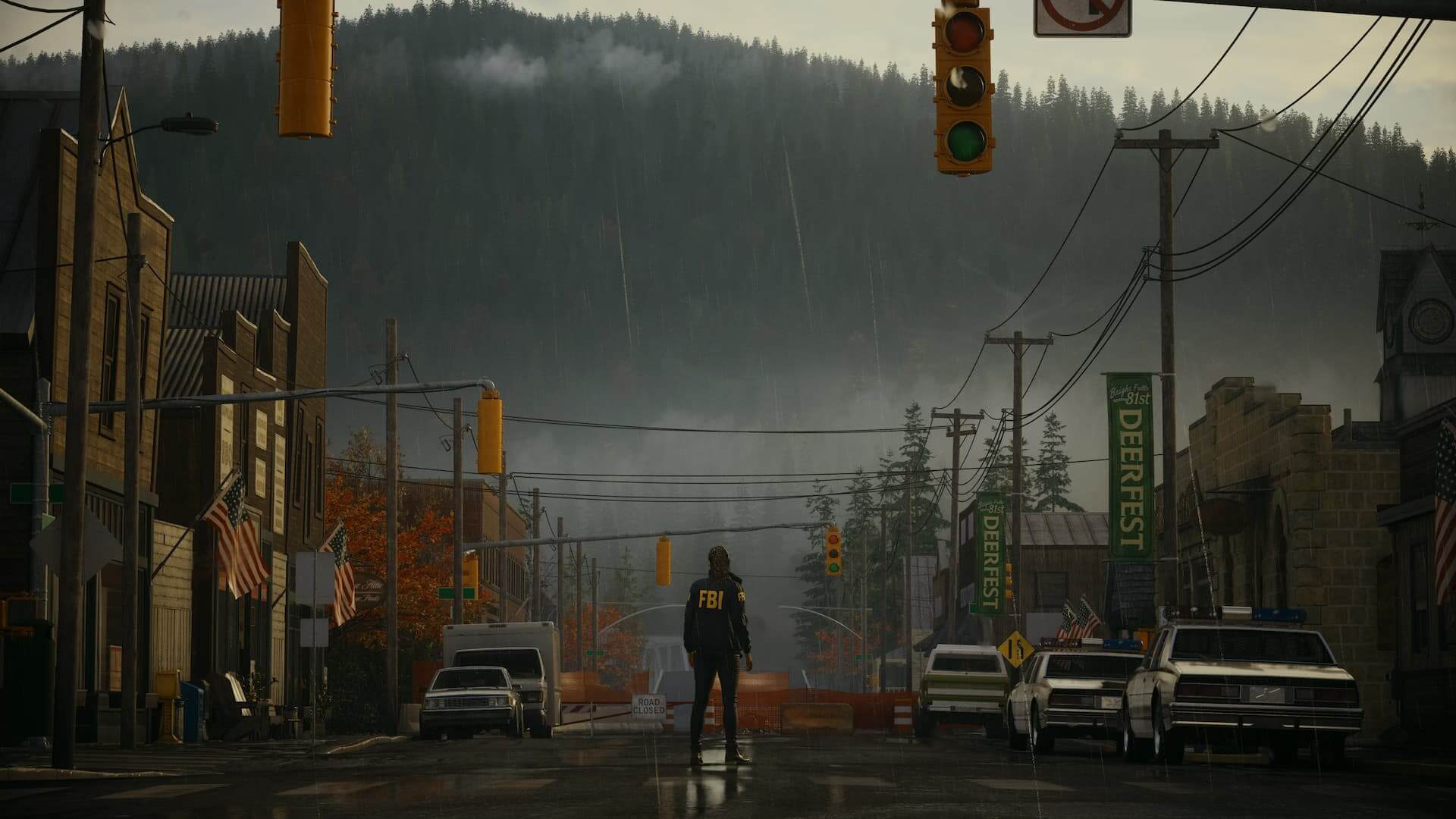
Alan Wake 2 Overview
Last month, Nvidia launched DLSS 3.5 Ray Reconstruction with Cyberpunk 2077 Phantom Liberty (and the 2.0 update). Today, Alan Wake 2 arrives as the first full game to ship with so-called "path tracing" — full ray tracing for all the lighting, reflections, and more. It also includes DLSS 3.5 support, and the system requirements and base settings are high enough to raise a few red flags.
Alan Wake 2 requires DirectX 12 mesh shaders, sort of — the first game to do so. It potentially makes for a hard cutoff in terms of the minimum GPU necessary to run the game at all. Nvidia has had mesh shader support since the Turing architecture (RTX 20-series and GTX 16-series), while AMD only added that with RDNA 2 and later (RX 6000-series). Intel Arc GPUs also support the feature. What that means is you'll need, at a minimum, an Nvidia RTX GPU or and AMD RX 6000-series GPU, or Intel Arc. Officially, anyway, but we were able to run the game on an RX 5700 XT after skipping past the "no mesh shader" warning.
As you might expect given the above features and requirements, Alan Wake 2 represents a graphical tour de force that will punish even the burliest of GPUs. Upscaling is recommended at all settings, for example, though you can also opt for DLAA or FSR2 Native if you want — there's no way to turn off DLSS or FSR2 otherwise. But let's go ahead and jump to our initial benchmarks before we dig into the various settings and image fidelity.
10/31/2023 Update: Added RTX 3080 results per reader request.
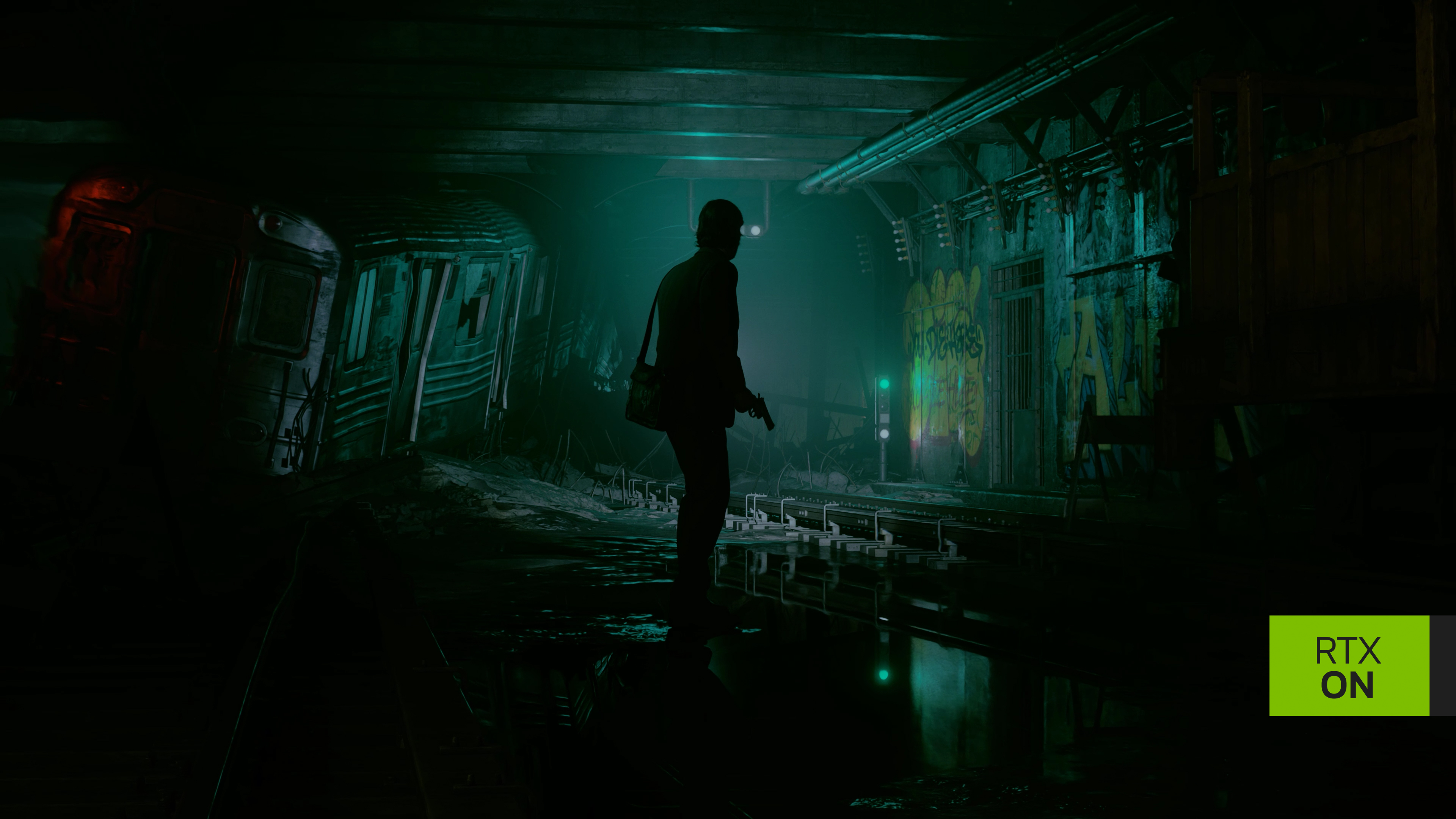
Alan Wake 2 Test Setup
TOM'S HARDWARE TEST PC
Intel Core i9-13900K
MSI MEG Z790 Ace DDR5
G.Skill Trident Z5 2x16GB DDR5-6600 CL34
Sabrent Rocket 4 Plus-G 4TB
be quiet! 1500W Dark Power Pro 12
Cooler Master PL360 Flux
Windows 11 Pro 64-bit
Samsung Neo G8 32
GRAPHICS CARDS
Nvidia RTX 4090
Nvidia RTX 4080
Nvidia RTX 4070
Nvidia RTX 4060
Nvidia RTX 3090
Nvidia RTX 3080
Nvidia RTX 3060
Nvidia RTX 2080 Ti
AMD RX 7900 XTX
AMD RX 6900 XT
AMD RX 5700 XT
Intel Arc A770 16GB
We received an early access code via Nvidia for Alan Wake 2. Our initial testing started on October 25, and an updated dropped after the first couple of cards (Nvidia RTX 40-series). A second update arrived on October 26, after our testing was finished, so we haven't tested it extensively yet. Early indications are that these are both bug fixes rather than performance enhancements, and shouldn't impact our performance results.
As with Phantom Liberty and other DLSS 3.5 enabled games, you'll need an Nvidia RTX GPU to enable Ray Reconstruction (RR), and a 40-series card for Frame Generation. Unlike with Phantom Liberty, you can still use Ray Reconstruction without the full-blown path tracing options. All three of the RT presets support RR on Nvidia RTX cards, which you can toggle off if you want. To quickly recap, RR is an AI-trained denoising algorithm. In Alan Wake 2, it potentially replaces two NRD (Nvidia Real-time Denoiser) algorithms that can be used on non-RTX cards.
We'll cover the settings in more detail below, but there are three ray tracing presets: Low is a limited form of ray tracing, like we've seen in plenty of other games. In the case of Alan Wake 2, you get direct lighting effects (reflections and shadows, mostly, plus some transparency effects). The RT Medium setting turns on partial path traced indirect lighting effects with a single bounce plus AO (Ambient Occlusion), while the RT High setting uses three bounces and full path tracing.
There's a lot of Nvidia technology at use, if you haven't noticed. While that could mean algorithms are potentially sub-optimal on non-Nvidia cards, we don't have any good method of proving or disproving such assertions. We can only run the tests and look at the image quality and see how the various GPUs stack up.
We're running the following settings for our benchmarks. First, we'll test using the Medium preset (without ray tracing) at 1080p, 1440p, and 4K. We'll also test with maxed out settings but still without RT at all three resolutions. Then we'll test with the RT Low and RT High presets as well, where it makes sense — cards that already fall below 30 fps at 1080p won't be tested at 1440p and 4K in most cases.
For Nvidia RTX cards, the two RT tests will be done both with and without RR enabled. As this is an Nvidia-promoted game with a lot of Nvidia tech, it tends to run best on Nvidia cards. That might change in the future, but even the fastest AMD and Intel GPUs currently available struggle with RT enabled. We're using Nvidia's latest 545.92 drivers that were just released today for testing (we had early access for a couple of days). For Intel, we're using the 4900 drivers that are listed as providing Alan Wake 2 support, and for AMD we're using the latest 23.10.2 drivers that do not specifically list support for Alan Wake 2.
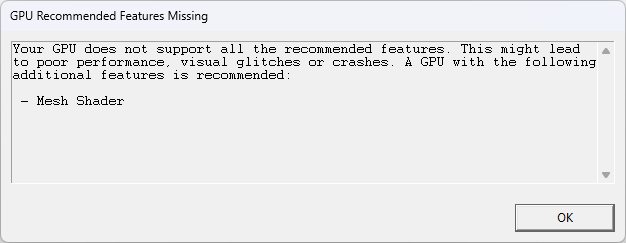
We're holding off testing additional AMD GPUs for now, limiting our initial tests to the fastest card currently available as well as the penultimate RX 6000-series part, the RX 6900 XT. However, we did want to test one other AMD GPU: The RX 5700 XT. While we previously reported that Alan Wake 2 requires mesh shader support, it turns out Remedy implemented a fallback path for older GPUs that seems to work okay. Performance isn't great, and one of the graphics options (post-processing quality) gets grayed out, which means certain computations aren't done.
We noted the game looked blurrier and perhaps grainier as well on the RX 5700 XT. But it was still technically playable, at 1080p with FSR2 Quality upscaling, if you want to give it a shot. Average fps was tolerable at medium settings, but 1% lows were quite poor and there was noticeable stuttering and hitching. Perhaps that's due to the drivers, or more likely just the workarounds for the lack of mesh shader hardware.
We can't promise it will fully work throughout the game, but it seemed fine in our limited testing of several areas. Also, there's a warning box you'll see when launching the game. Proceed at your own risk, in other words. But if you've been waiting for a sequel to Alan Wake since 2010 and you haven't upgraded your GPU since 2016, you may still be able to give it a shot. If you're on older hardware, minimum settings may still provide a playable experience, minus a lot of the moody atmosphere, but we wouldn't expect too much more than that.
Alan Wake 2 1080p GPU Performance
We'll start with the non-RT (non-ray tracing) tests, since those are more applicable to a wider audience — if you don't have an Nvidia RTX card, preferably a high-end 30-series or 40-series part, you'll probably want to skip enabling RT. Even at medium settings, with Quality mode upscaling, you'll still need a reasonably capable GPU. Now on to the rasterization tests.
The RTX 4060 and above manage to clear 60 fps, though minimums fall below that mark on some of the cards. Note also that the old RTX 2080 Ti only just squeaks past the 4060. This is almost certainly a case of a game leveraging newer graphics features that don't run as well on the older Turing architecture. Our GPU benchmarks hierarchy shows the RTX 2080 Ti outperforming the RTX 4060 by 16% on average at 1080p, whereas it's only 7% faster in Alan Wake 2.
AMD's GPUs generally land where we'd expect for rasterization performance, with the 7900 XTX falling between the RTX 4080 and RTX 4090. Minimum (1% Low) fps isn't as consistent, however, and the occasional hitching can be felt while playing on some of the AMD cards. That could be fixed with updated drivers, which is why we didn't spend time on further AMD benchmarks yet.
Intel's Arc A770 16GB does have drivers that are supposed to work with with Alan Wake 2, but they also need further work. Average fps looks decent, but the 1% lows are terrible. The issue right now is that it seems to load or swap data every 10 seconds or so — there were three clear stutters, in basically the same spots, every time we ran our benchmark sequence. Hopefully that issue gets ironed out sooner than later, and we didn't bother with testing lower tier Arc GPUs for the time being.
Turning up the quality settings doesn't massively improve the visuals, so keep that in mind. A few things look slightly better, and judicious tuning of the individual settings — there are 18 settings to tweak, not counting the ray tracing options — should help. Note that the high preset doesn't max out Volumetric Lighting, Volumetric Spotlight Quality, or Shadow Resolution, but we manually bumped those up a notch for our tests.
The relative positioning of nearly all the GPUs we tested remains nearly unchanged compared to the above medium tests, with one exception: The Arc A770 edges past the RTX 3060 now. It's not a clear victory, however, as the occasional stalling was still very much present with Intel's GPU.
As far as hitting 60 fps is concerned, at max non-RT settings, you'll need at least an RTX 4070 or RTX 3080. For AMD, the RX 6800 and RX 7700 XT should also clear 60 fps, but of the GPUs we tested only the RX 6900 XT and above were powerful enough. Now let's see what happens with some ray tracing...
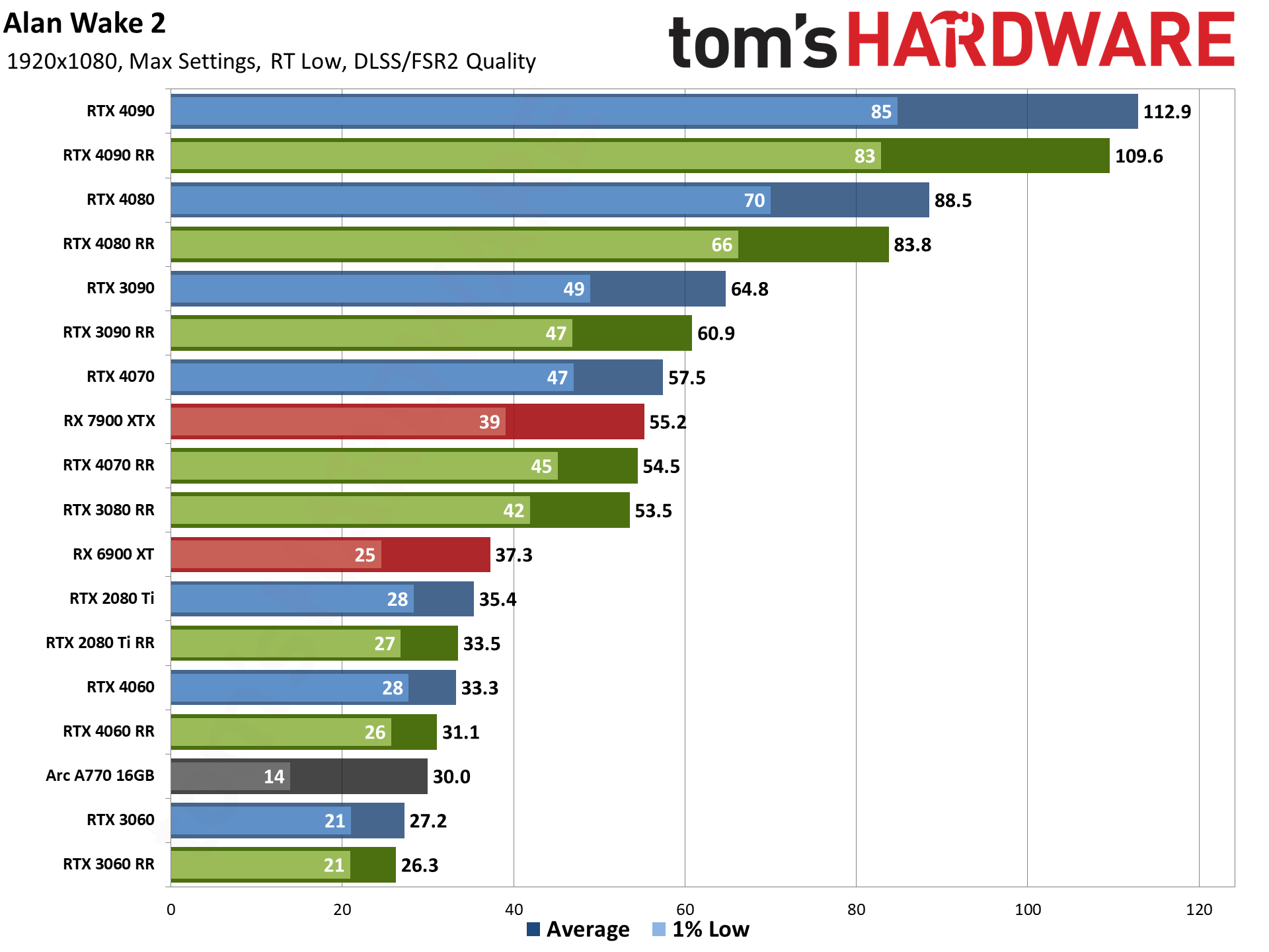
This chart can be a bit confusing at first glance, and note that the green "RR" scores (for DLSS 3.5 Ray Reconstruction) from the Nvidia GPUs aren't fully comparable to the other results. In this case, RR looks better, though the differences aren't always super obvious. Compared to the baseline NRD denoiser, RR actually drops performance a bit, but if you have an Nvidia GPU we would leave it enabled.
Performance obviously takes a massive hit on most of the GPUs. The RTX 4090 and 4080 only drop about 25%, while most of the other Nvidia GPUs lose about 30–35 percent — the 30-series and 20-series parts tend to be closer to 35%, while the 4070 and 4060 are around 30%. The Arc A770 also lost 32% of its performance.
But that's nothing compared to what happens on the two AMD GPUs we've tested. The RX 7900 XTX and RX 6900 XT performance drops by 57–58 percent, which is a massive hit. The 7900 XTX comes in a few fps shy of the 60 fps mark, but the 6900 XT only just manages to break 30 fps — and 1% lows aren't great on either GPU.
The RTX 4060 and RTX 2080 Ti are also nearly tied now, showing how the older Nvidia architectures aren't holding up quite as well under the most demanding ray tracing workloads. Theoretically, all the hardware tech existed back when the RTX 20-series launched, but even then, the fastest GPU would only manage to squeak past 30 fps with heavy ray tracing plus upscaling.
And we're not even doing the full path tracing yet!
Get Tom's Hardware's best news and in-depth reviews, straight to your inbox.

At maxed out settings with full path tracing, you'll need at least an RTX 4070 to get a decent experience. An RTX 3080 will also mostly suffice, though it can dip below 30 fps at times. Anything below that will have to use higher levels of upscaling to have a chance.
And even that might not be sufficient. We tested the RTX 3060 with DLSS Ultra Performance mode — 9X upscaling, or going from 640x360 to 1920x1080. And it averaged 30 fps with 25 fps on the 1% lows.
Note also how the RTX 3080 trails the 4070 when all the bells and whistles are enabled, whereas it was slightly faster in our above rasterization tests. Nvidia improved the RT cores in its latest Ada Lovelace architecture, supposedly up to doubling the potentially ray/triangle intersection rate. We don't normally see this make much of a difference, but with full path tracing that architectural change starts to show up more.
If you want 1080p with Quality mode upscaling and full ray tracing in Alan Wake 2, you currently have your choice of two GPUs: the RTX 4090 and RTX 4080. (We didn't test the 4070 Ti, but based on past testing it would split the difference between the 4080 and 4070 and land at around 55-ish fps.)
Of course, we're also not enabling Nvidia's Frame Generation, mostly because it's frame smoothing and doesn't actually improve the feel of the game in our experience. You really need a base framerate of at least 30 fps for Frame Generation to be viable, so only the RTX 4070 will really benefit at these settings, and even then it's not clearly a better feel. In other words, Frame Generation is very heavy on marketing, and the more time passes, the less enamored we become.
AMD's fastest GPU barely clears 30 fps, with plenty of stutters in the low 20s as indicated by the 1% lows. It's still faster than the RTX 4060, which now outperforms the RTX 2080 Ti with Ray Reconstruction enabled. AMD's previous generation RX 6900 XT only manages 21 fps, which isn't remotely playable at these settings, and neither is the Arc A770 at just 16 fps — basically tying the RTX 3060, if you're keeping score.
AMD's FSR3 Frame Generation isn't supported, but our initial experience with the two games that have it wasn't any better than with Nvidia's FG. In fact, it was decidedly worse, as minimum framerates dropped (i.e. more stuttering) and the games didn't feel or look better than running without FSR3 FG. You'll note that AMD's marketing charts don't show minimum fps, and there's a reason for that. But that's a topic for another time, and hopefully future FSR3 games will have an improved and more robust implementation.
Alan Wake 2 1440p GPU Performance
Alan Wake 2 remains playable on a lot of GPUs at 1440p medium, provided you use upscaling and don't enable ray tracing. The RTX 4070 and above all break 60 fps, with the older RTX 2080 Ti coming up just a bit short. The other GPUs that we tested are still above 30 fps, though, and could be used without too much trouble.
Cranking up the settings for a minor boost in image fidelity drops performance by about 25–30 percent on the slower cards, so the RTX 3060 and 4060 become a rather marginal experience, but they're not entirely unplayable. Otherwise, the relative positioning of the cards hasn't changed from the 1080p results.
We mentioned Frame Generation above, though, and we should at least point out what it provided on the RTX 4060. Using 1440p medium settings but with FG enabled, the 4060 managed 69 fps — 40% faster than the non-FG result. But we also have latency data, courtesy of Nvidia's FrameView utility, and the 1440p non-FG result was 57ms compared to 93ms with Frame Generation enabled. 1% lows also dropped slightly.
As we've reiterated on many occasions, Frame Generation — whether from Nvidia or AMD — just hasn't proven to be an overall win in our book. It's okay to have the option, but many people will prefer the lower latency that you get by turning FG off. It's an idea that sounds better on paper, and looks better in charts, than the actual results. It's why we're not testing it with most of the Nvidia 40-series GPUs, though the time requirement for the additional testing is another good reason.


Given what we already saw from enabling RT at 1080p, you can see why we've dropped several GPUs from the 1440p RT charts. The RX 7900 XTX remains just to show AMD's current best, which is again at the level of an RTX 4070 with the RT Low settings — and Ray Reconstruction still looks better.
The RTX 4080 and 4090 meanwhile continue to break 60 fps and can certainly handle the RT Low setting. Bumping the upscaling to Balanced mode would give them more headroom, and the resulting images aren't even that much worse than Quality mode if you want to go that route.
But if you want to do 1440p with the full path tracing, prepare for an even bigger hit to performance. Now the 3090 and 4070 with Ray Reconstruction land right at 30 fps, the RTX 4080 manages around 50 fps, and only the mighty RTX 4090 still clears 60 fps. The RTX 3080 meanwhile drops to just 24 fps, and AMD's fastest GPU sits at 22 fps. Oof.
We're not saying you need path tracing to enjoy Alan Wake 2, though. We'll look at image quality in a bit. It does generally look better, especially on the faster Nvidia GPUs with RR enabled, adding more atmosphere to the game's environments. But if you don't have a potent GPU, playing without RT enabled is totally acceptable.
Alan Wake 2 4K GPU Performance
4K using just rasterization meanwhile remains a decent alternative to maxed out RT settings at lower resolutions. The RTX 4090 still manages nearly 100 fps at 4K medium, slightly faster than the 1080p RT High results from above. RTX 4080 and RX 7900 XTX also easily clear 60 fps — though again, AMD's 1% lows are quite poor and some driver tuning will hopefully shore up that deficiency.
Probably the 3090 Ti, 4070 Ti, and 7900 XT will suffice as well for 4K medium and 60 fps, but everything else will come up short of that mark. The 3090 just misses 60 fps, but the 6900 XT and 4070 miss by 10 fps or more. They're still playable, and with a VRR (Variable Refresh Rate) monitor you should be fine, but if you have a fixed 60 Hz refresh rate display and you enable vsync, you'd definitely notice the difference.
Maxed out 4K settings without ray tracing drops performance by about 20% in most cases, slightly more on cards with 8GB like the RTX 4060. The 4080, 4090, and 7900 XTX still break 60 fps, barely in the case of the 4080 and 7900, which means nothing else will do that, at least without other features like Frame Generation to "help."
RTX 4070 and above do remain playable at least, and the RX 6800 and RX 7700 XT should probably suffice as well, in a pinch. But in general, 4K, even with upscaling, will require at least a $500 current generation GPU.
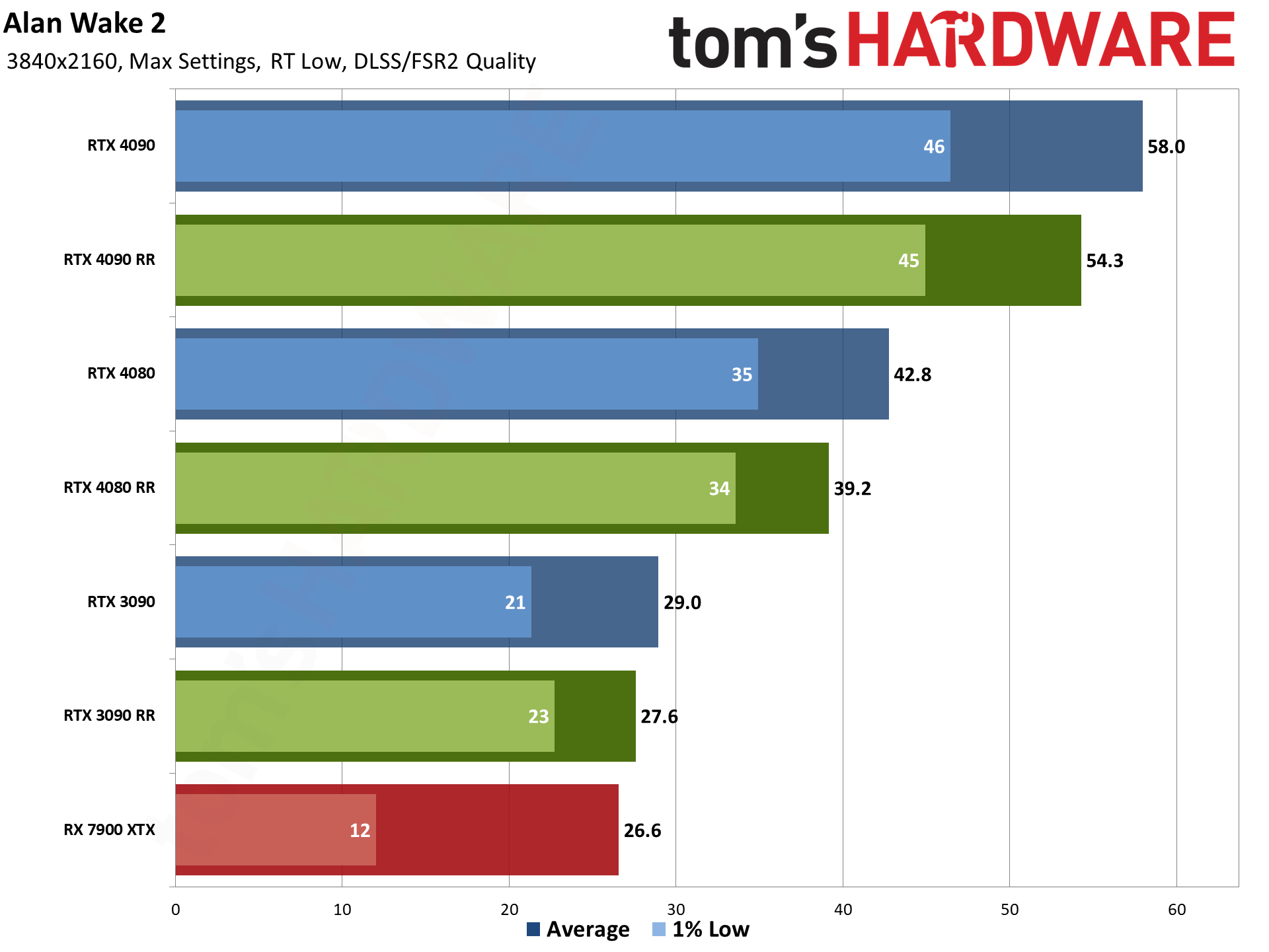
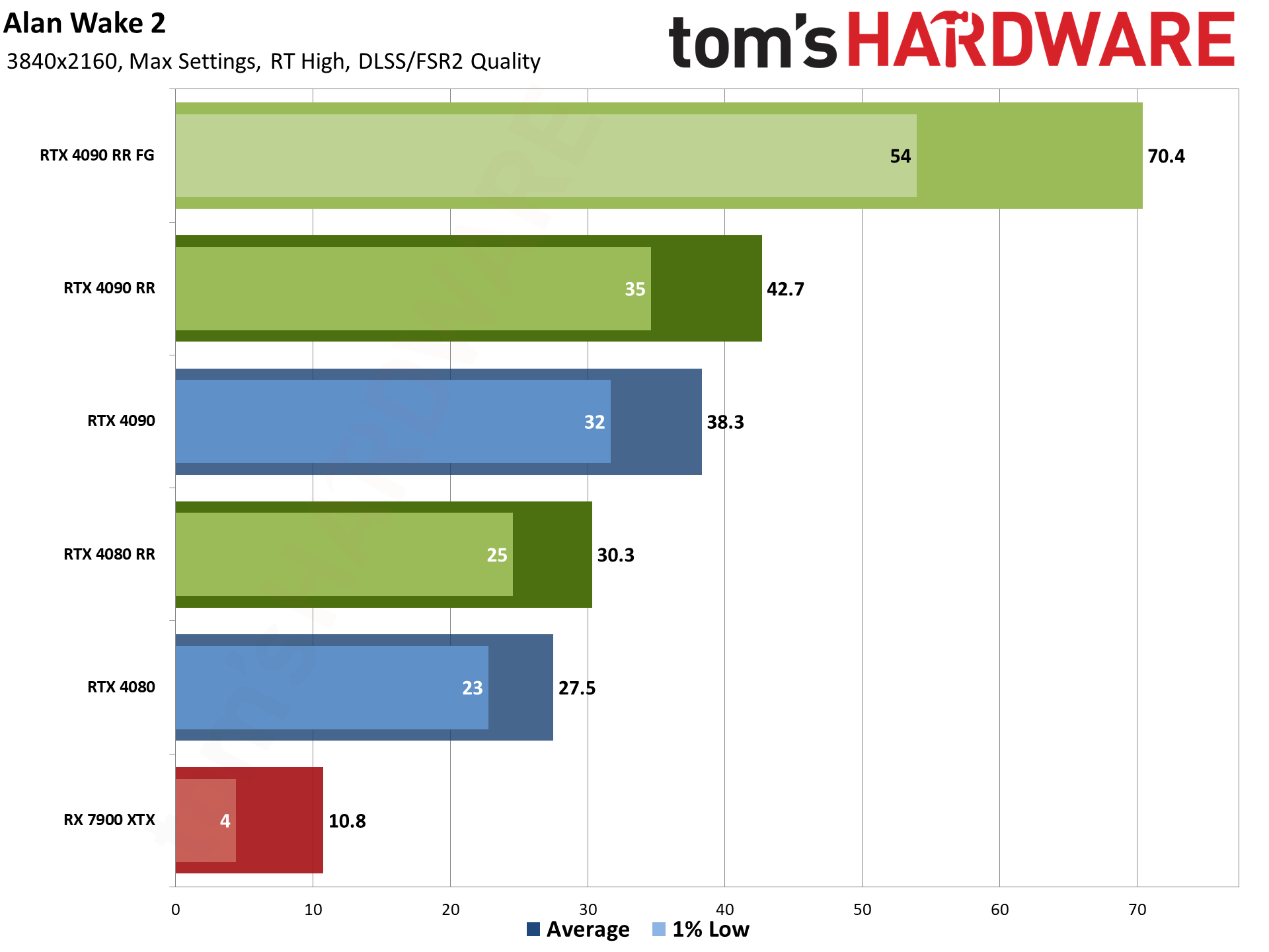
There's not a whole lot to say about 4K with RT enabled in Alan Wake 2. Nothing breaks 60 fps with our test settings at RT Low, and most GPUs fall below 30 fps with RT High path tracing enabled.
It's extremely demanding, to say the least. Nvidia's marketing will happily show you Performance mode upscaling with Frame Generation, to make things look better. And yes, as you can see, turning on Frame Generation pushes the RTX 4090 past the 60 fps mark.
Cutting the number of rendered pixels down will certainly improve things. But don't be fooled into thinking Nvidia's 4K + RR + FG + 4X upscaling looks or feels as good as 4K + RR + 2X upscaling. We could argue the point, and there's no 100% accurate way of ranking things, but pure "frames to monitor" (because Frame Generation isn't the same as fps) obfuscates things at best.
Ultimately, however, you'll need to buy into Nvidia's narrative about AI generated frames and content if you want Alan Wake 2 at 4K with path tracing at over 60 fps. And even then, you'll still need at least an RTX 4080. The RTX 4070 Ti can manage 60 fps with RT Low settings, but with full path tracing using the RT High preset, the RTX 4070 as an example only managed 40 fps in most areas — which means it feels like 20 fps, because that's how often your input gets sampled.

Alan Wake 2 Image Fidelity Comparisons
Alan Wake 2 is a very impressive looking game, particularly if you have the hardware to run it at maxed out settings. And I do mean maxed out, including path tracing and Ray Reconstruction. Without path tracing, there are some oddities that pop up on occasion. The game remains playable, but there are some immersion breaking graphical glitches at times.
One that you might not notice if you just start with the rasterized mode and stay there is how light flickers through tree branches in less believable ways without path tracing. There's also an element of fuzziness that's visible in many areas, which Ray Reconstruction helps to eliminate. RR also means less shimmering when in motion (compared to non-RR rendering on non-Nvidia GPUs), particularly on reflective puddles and other surfaces.
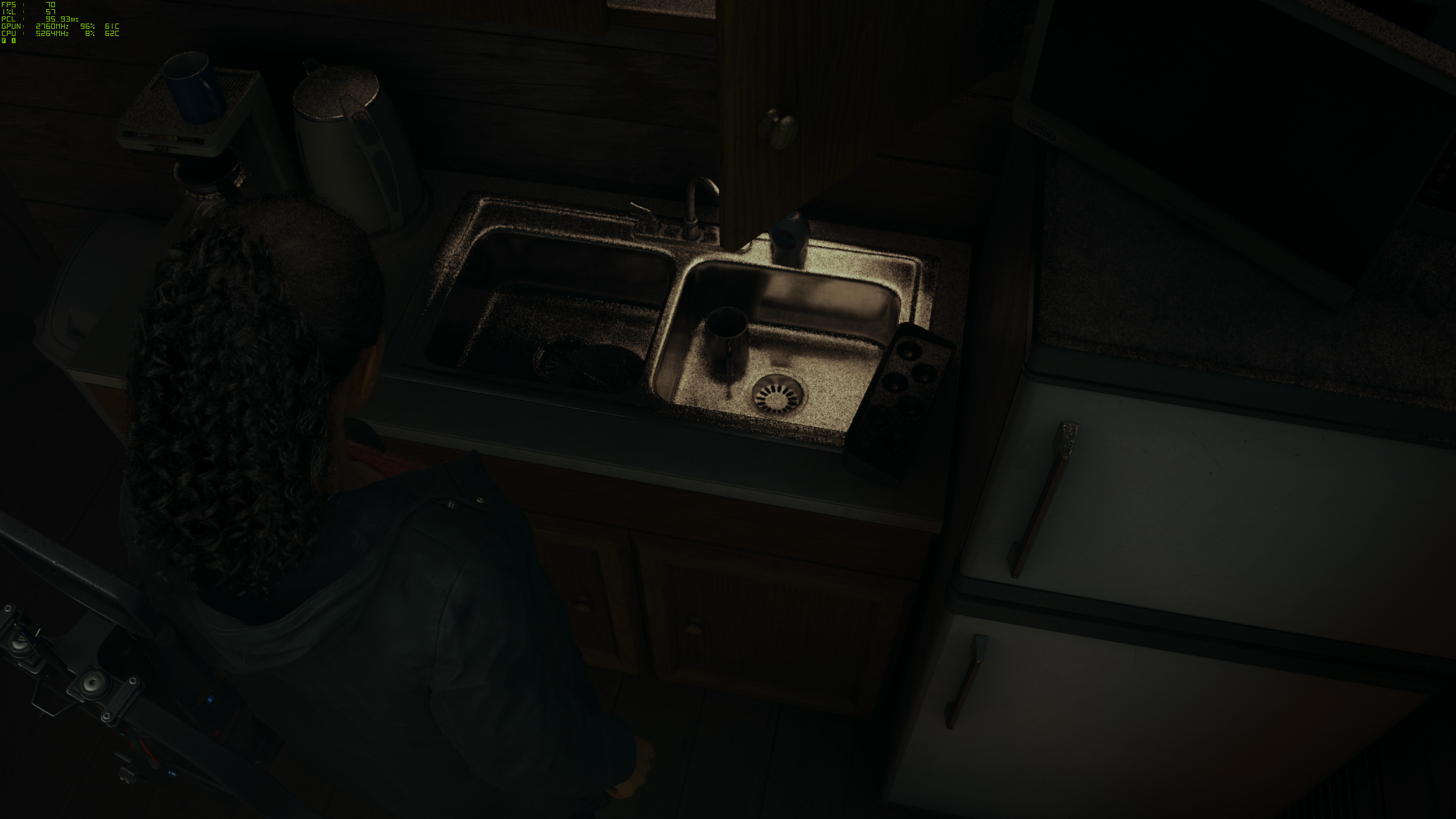

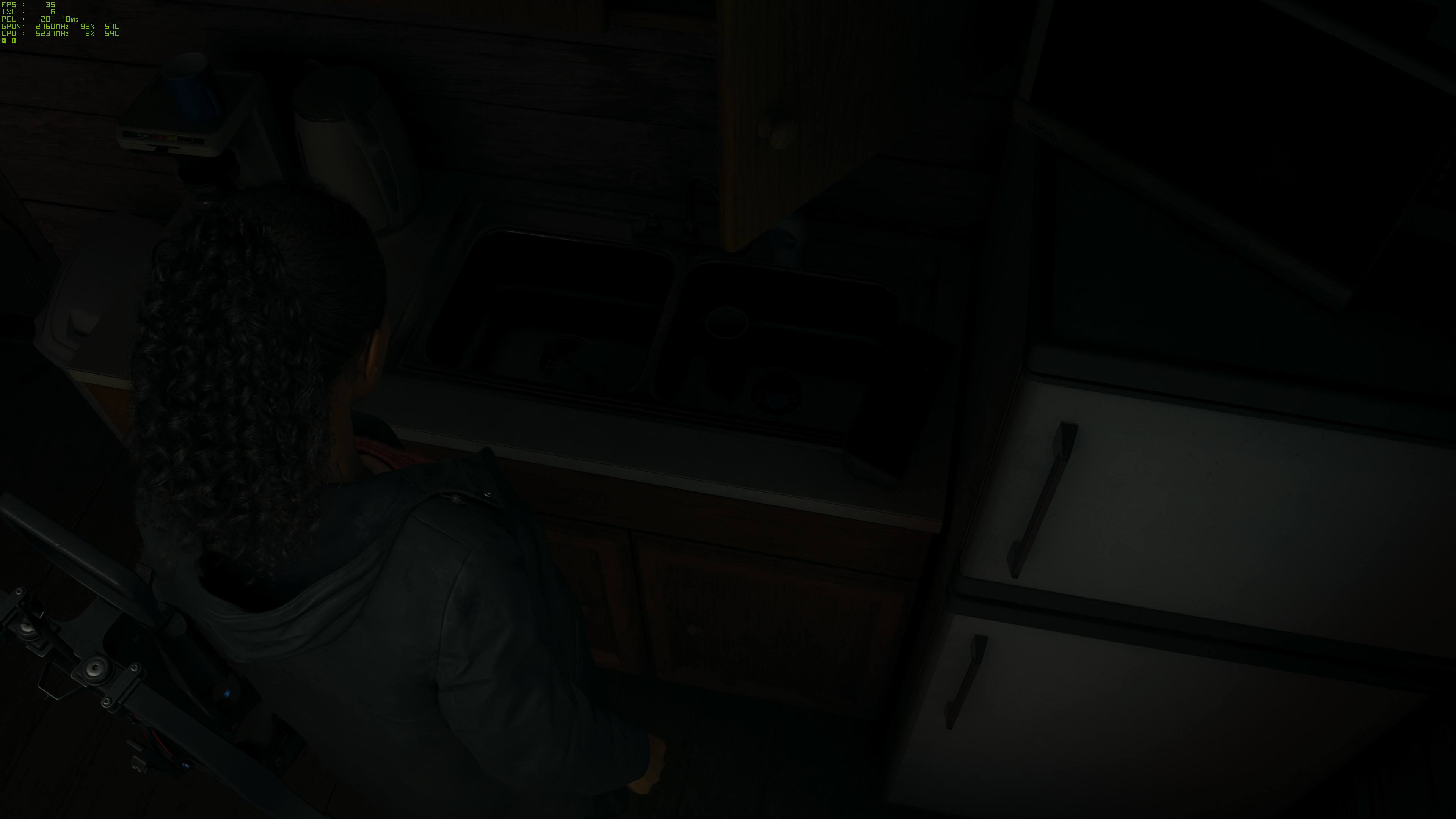
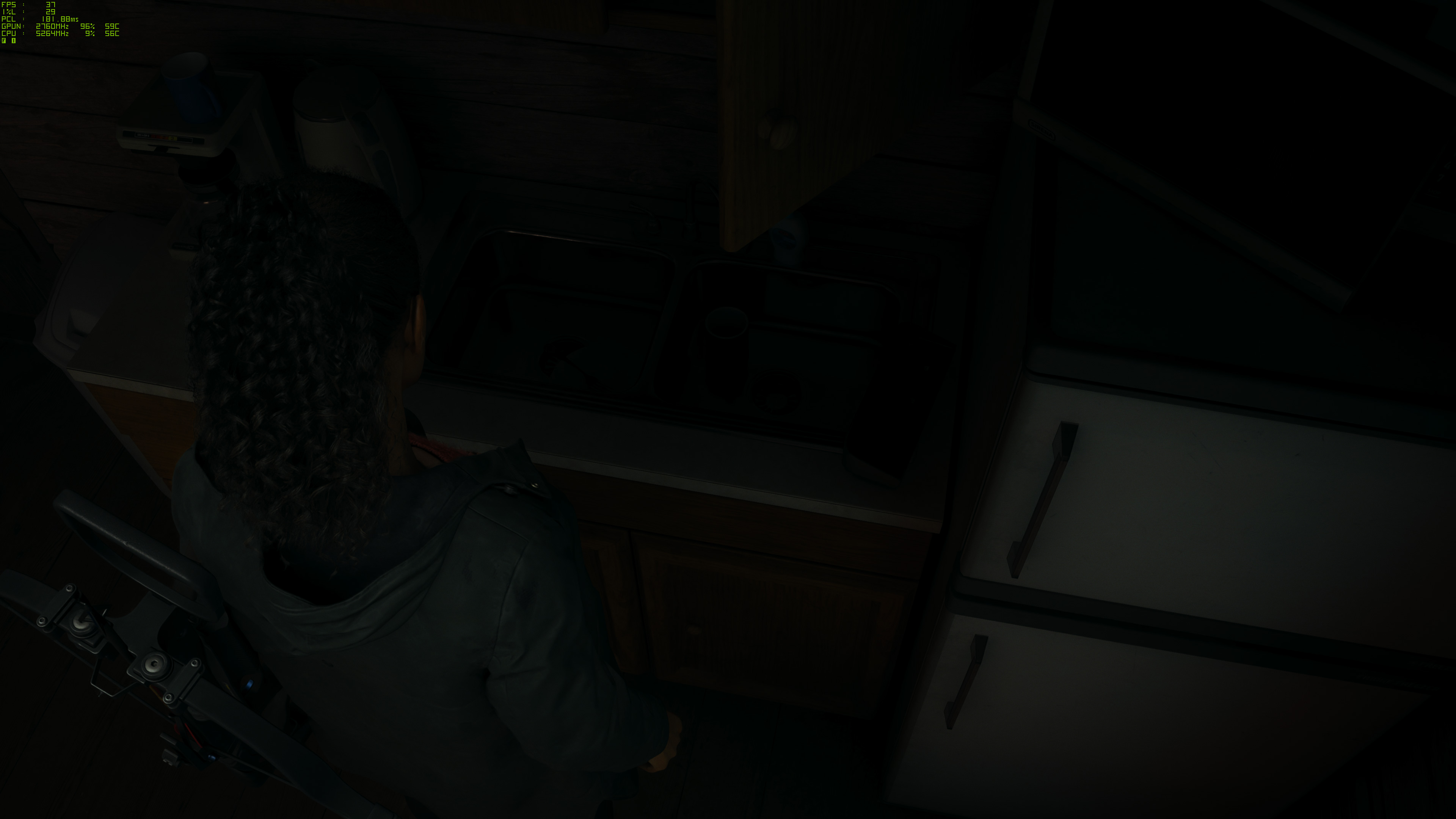
Here's a fun one, though. Some dark areas (and there are plenty of dark areas in the game!) can end up with incorrect lighting applied. Like this kitchen sink in a shack by the water. With path tracing, the kitchen is very dark and you can't see much of anything. With pure rasterization, or even rasterization plus RT direct lighting (the RT Low setting), the silver sink can end up shining rather brightly.
Is that just a level design bug? I'm not even sure, but it's definitely a rendering issue that you don't get with path tracing. This is where Nvidia's promise of the potential to having lighting, reflections, etc. "just work" actually rings true. Level designers can build a realistic level, and if there's no light, they don't need to fake it.
Anyway, we've captured a bunch of comparison images from Alan Wake 2 to look at image quality. There are three presets for standard settings (low, medium, high), but low doesn't minimize the settings and high doesn't maximize the settings, so we have two extras that we've added to the mix. "Min" means everything that can get turned down or off gets turned off, while "Max" means everything that can get turn up or on gets enabled. (Our above performance testing used "Max," in case that wasn't clear.)
Beyond those five "presets," we have the RT options: RT Low, RT Medium, and RT High. Except, Nvidia GPUs have the option to enable Ray Reconstruction on each of those. That gives 11 total image quality options we can compare for Nvidia RTX cards, which is what we used for our screenshots.
The AMD, Intel, and Nvidia GPUs should in theory render everything the same way (at least without RR enabled on the Nvidia cards). We did encounter one or two instances where that seemed to not be the case, but we couldn't consistently replicate them. It may just be drivers, or possibly the game getting into an indeterminate state when changing settings. But in general, the three vendors' GPUs seemed to render things correctly.
Image Fidelity Screenshots

Minimum Quality

Low Quality
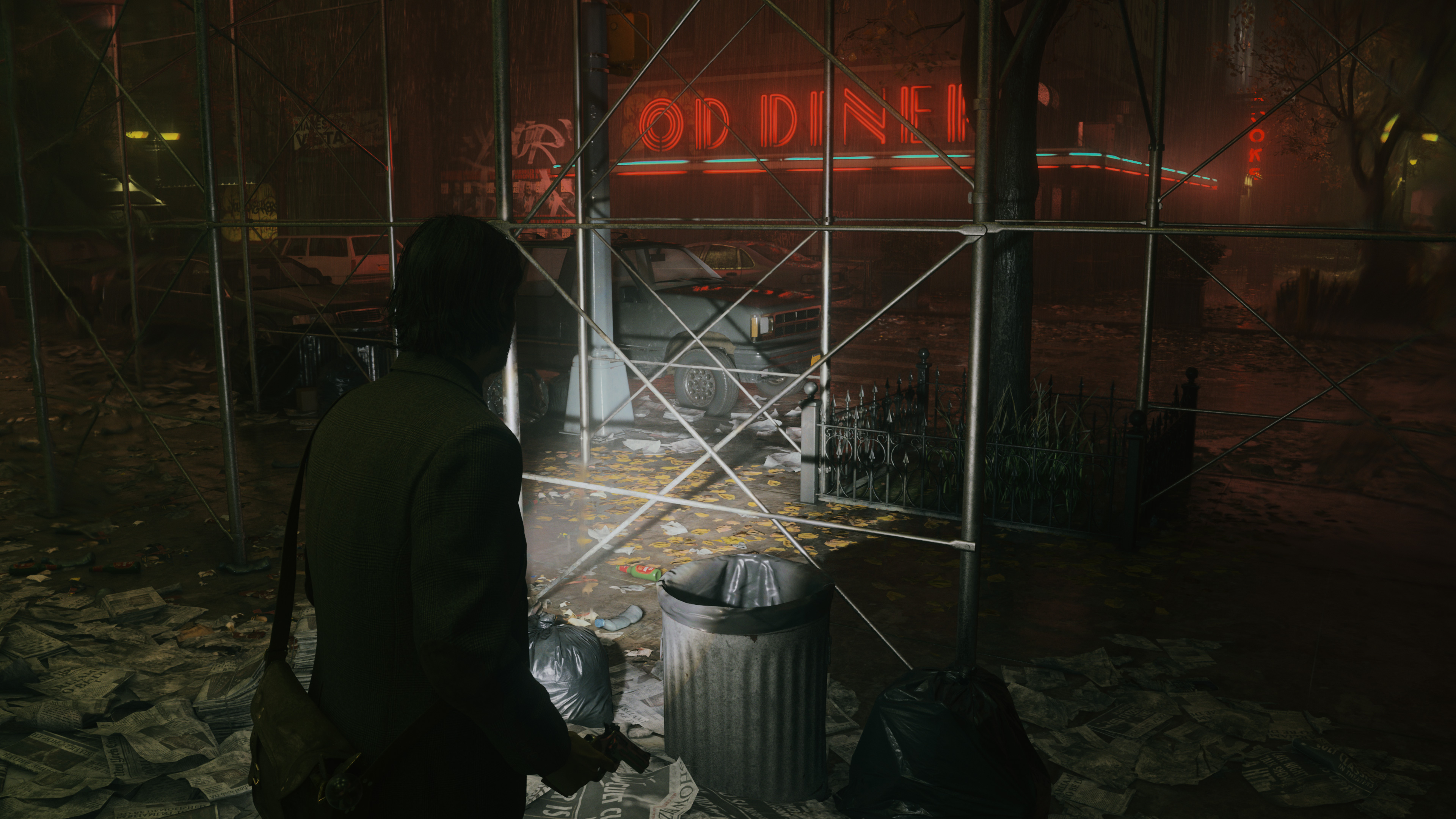
Medium Quality
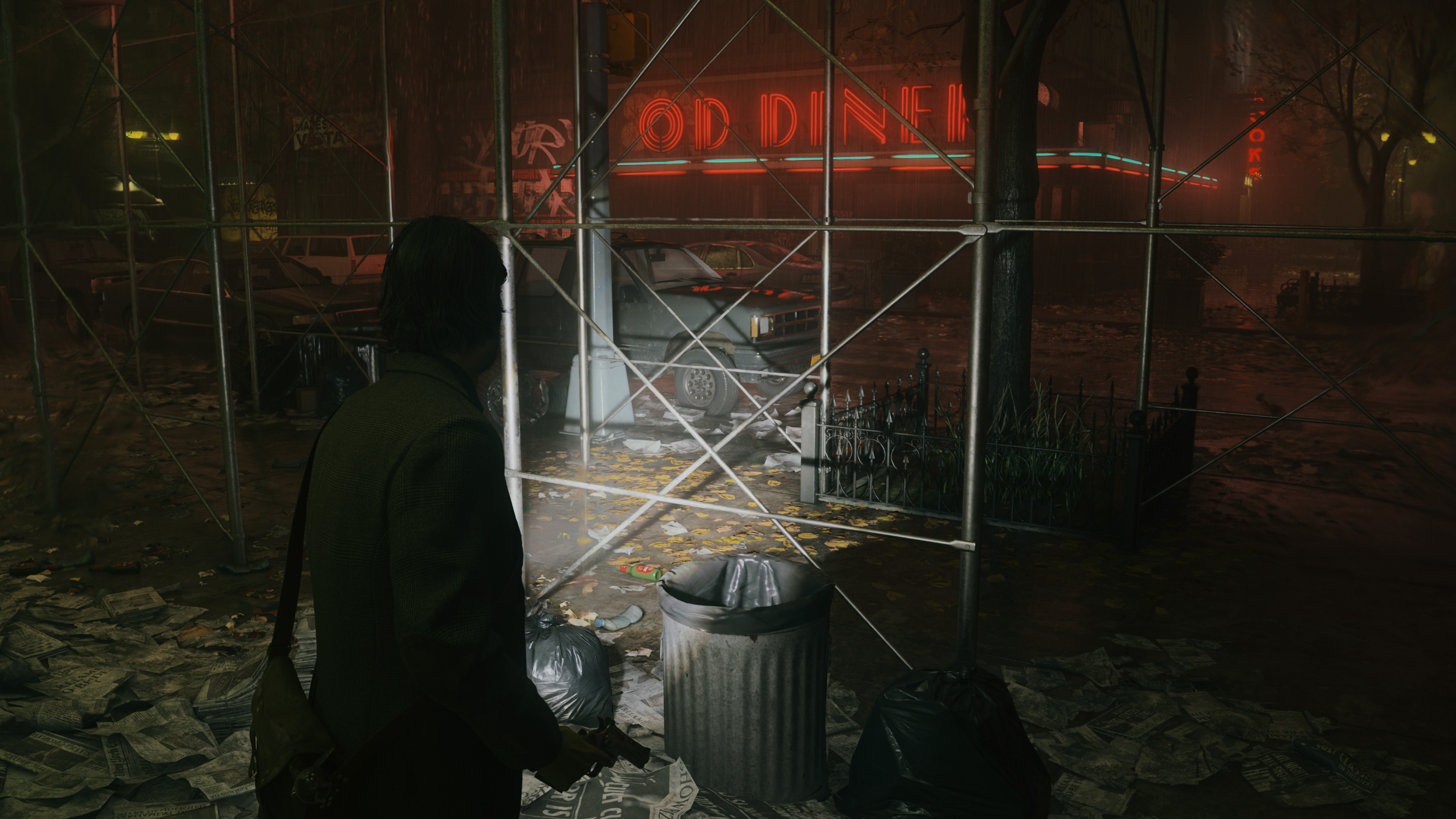
High Quality
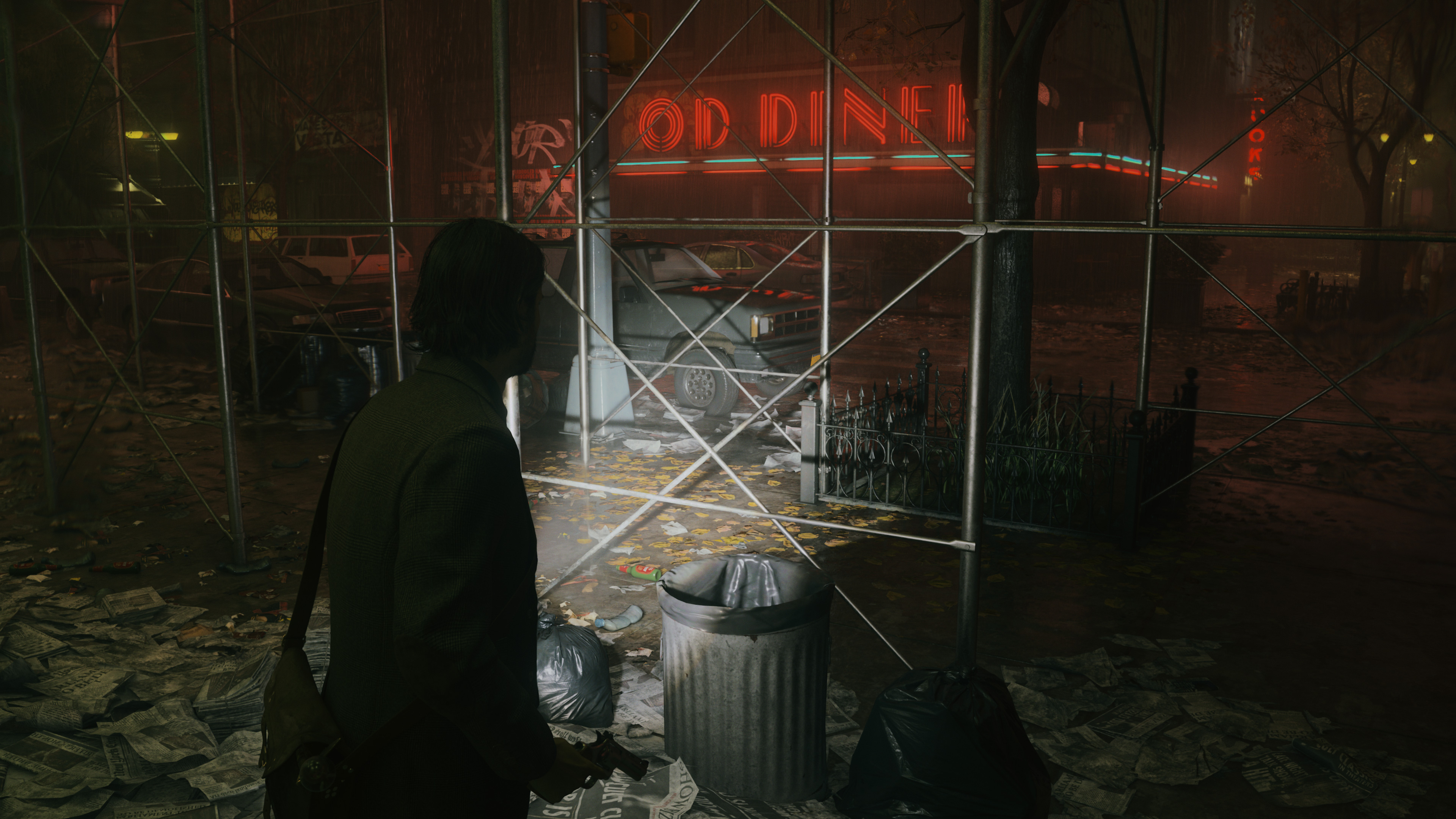
Max Quality (no RT)
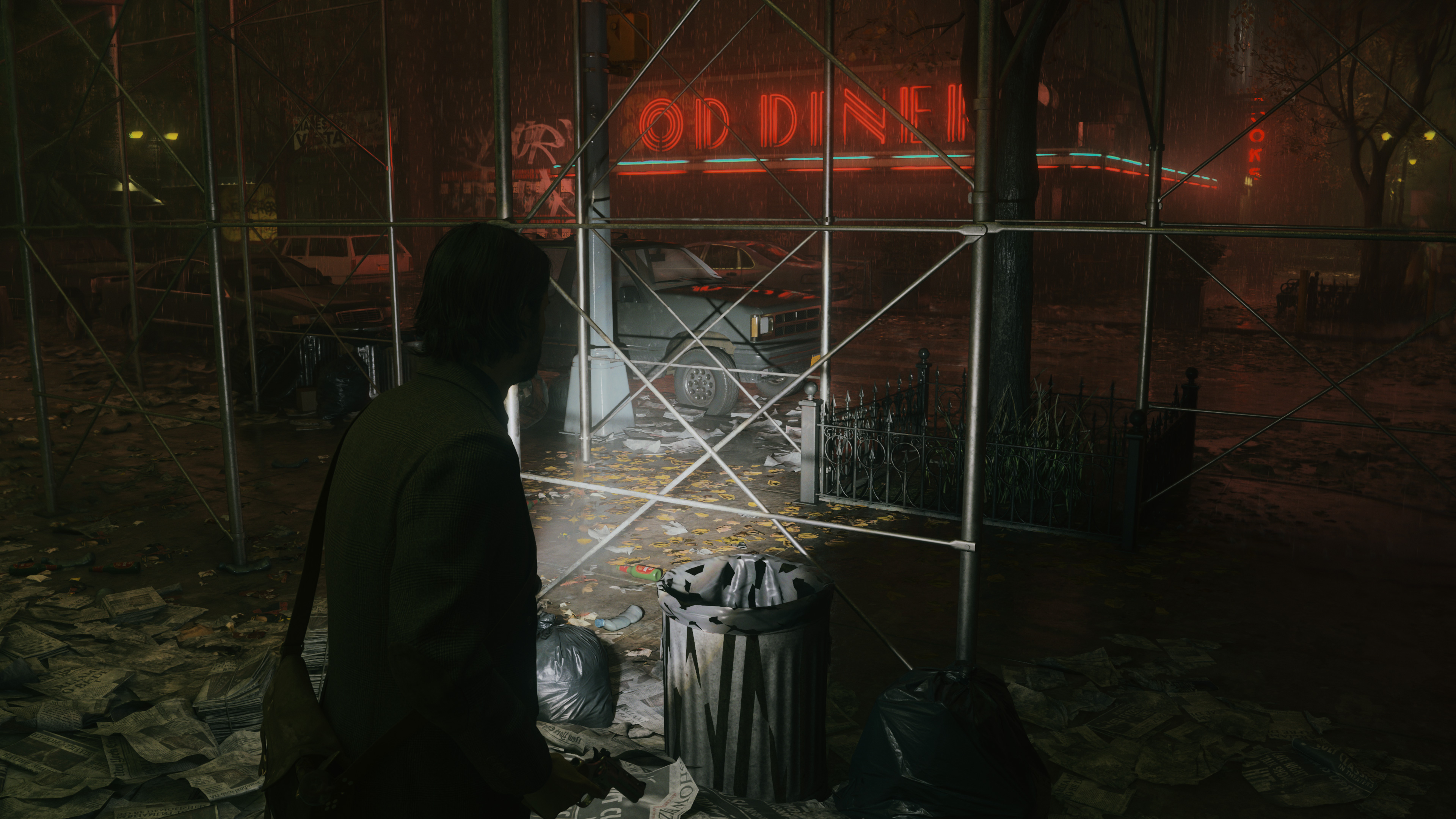
Max Quality plus RT Low and Ray Reconstruction

Max Quality plus RT Low
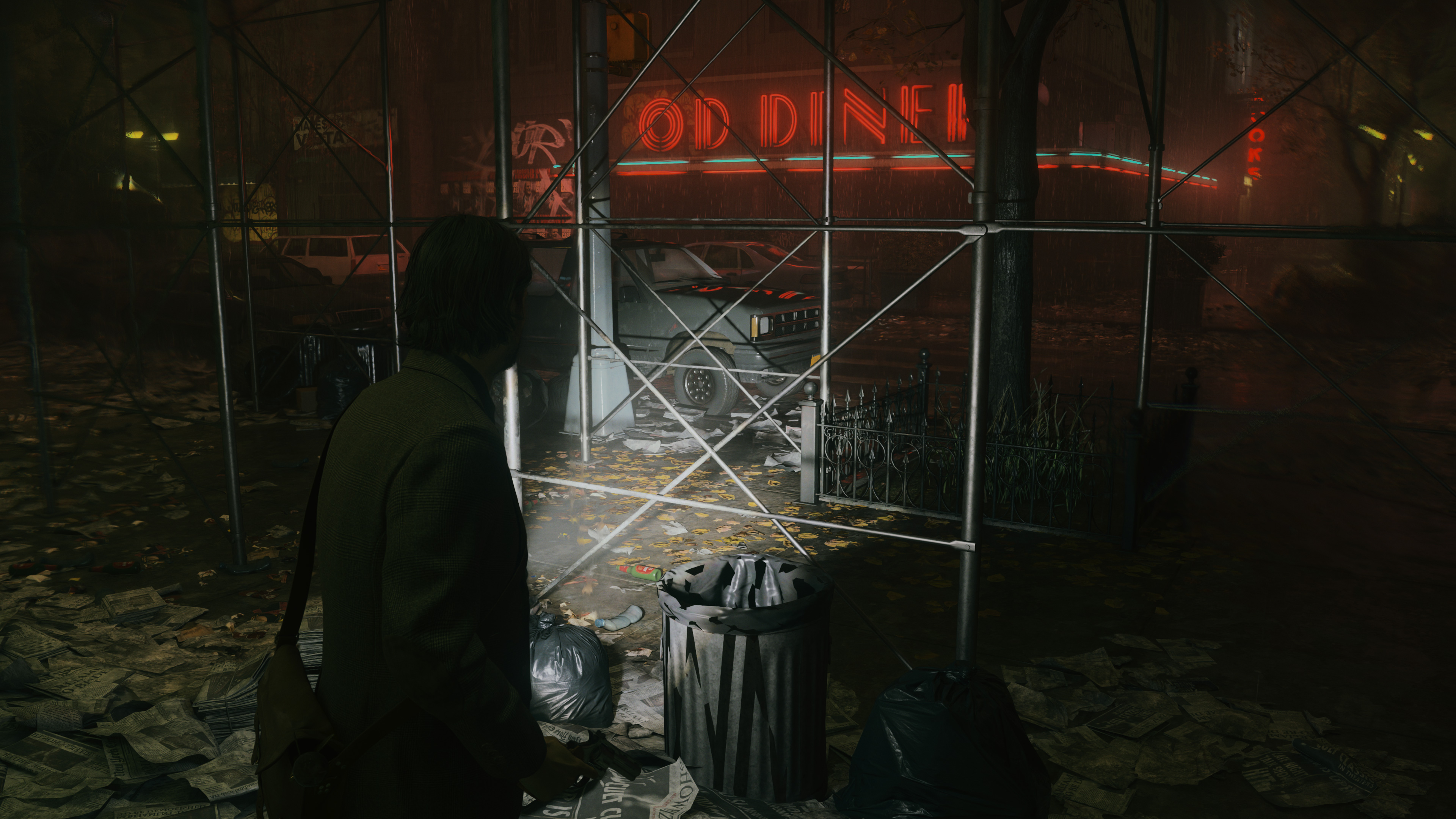
Max Quality plus RT Medium and Ray Reconstruction
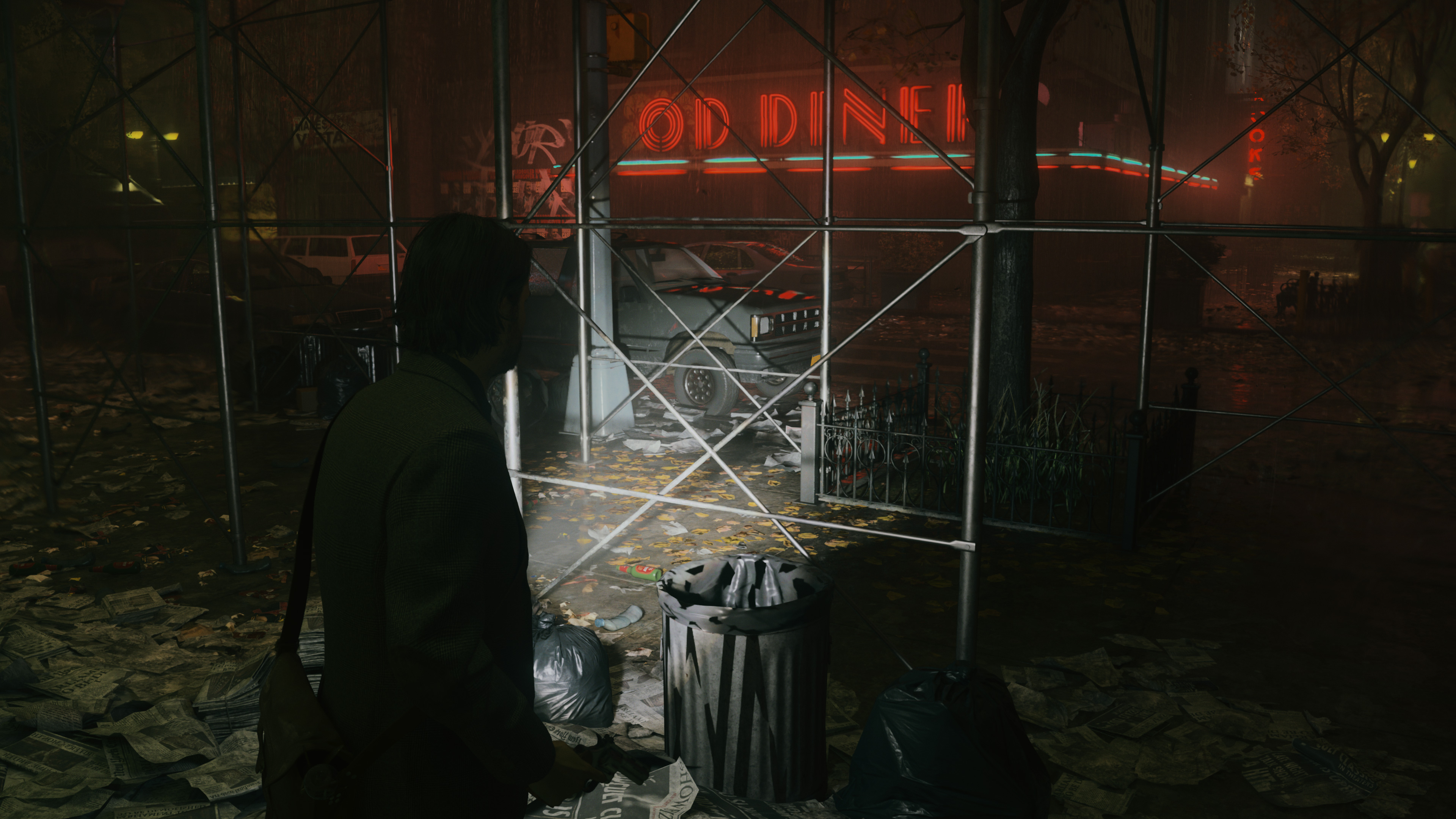
Max Quality plus RT Medium

Max Quality plus RT High and Ray Reconstruction
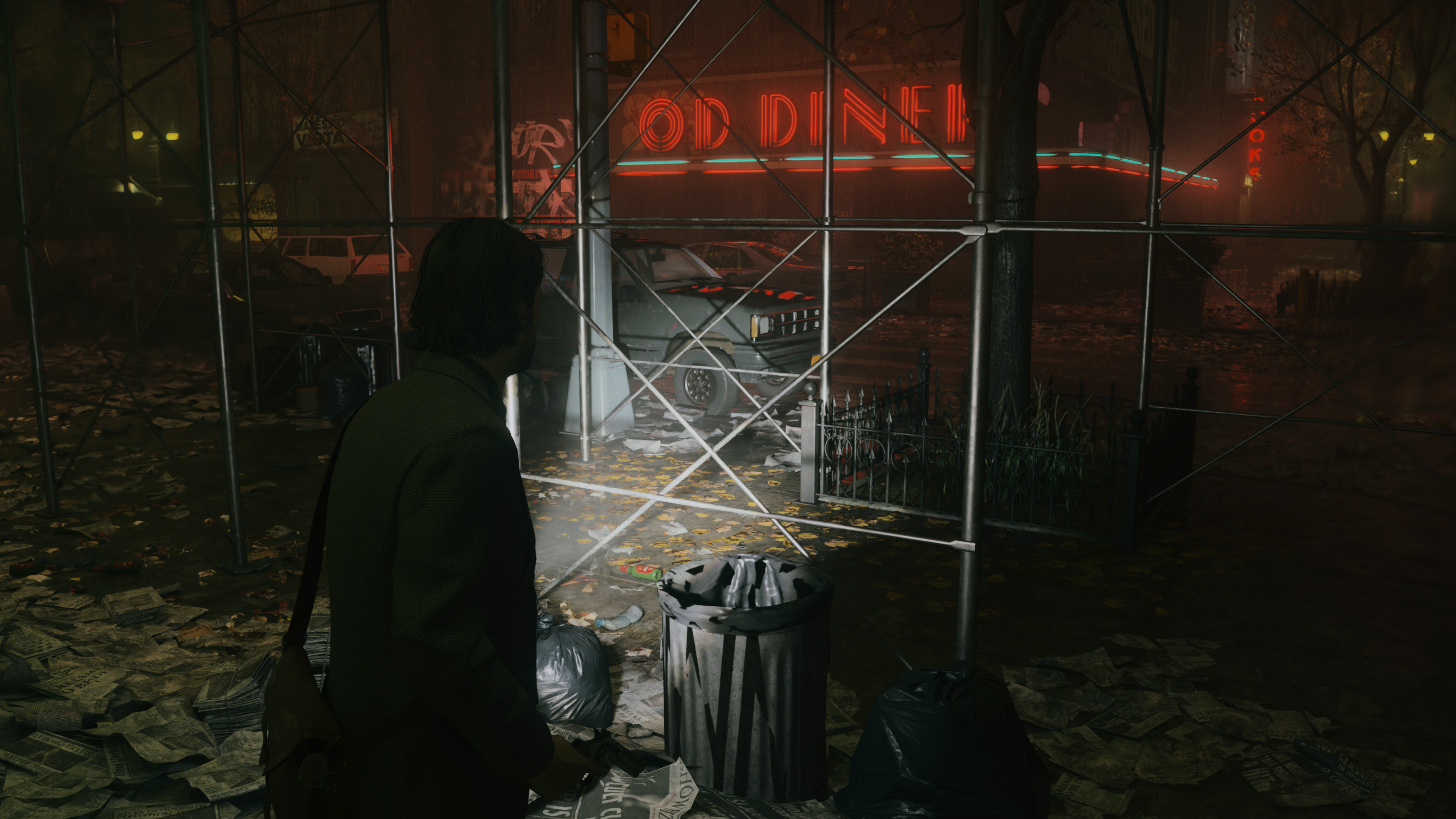
Max Quality plus RT High

Minimum Quality

Low Quality

Medium Quality
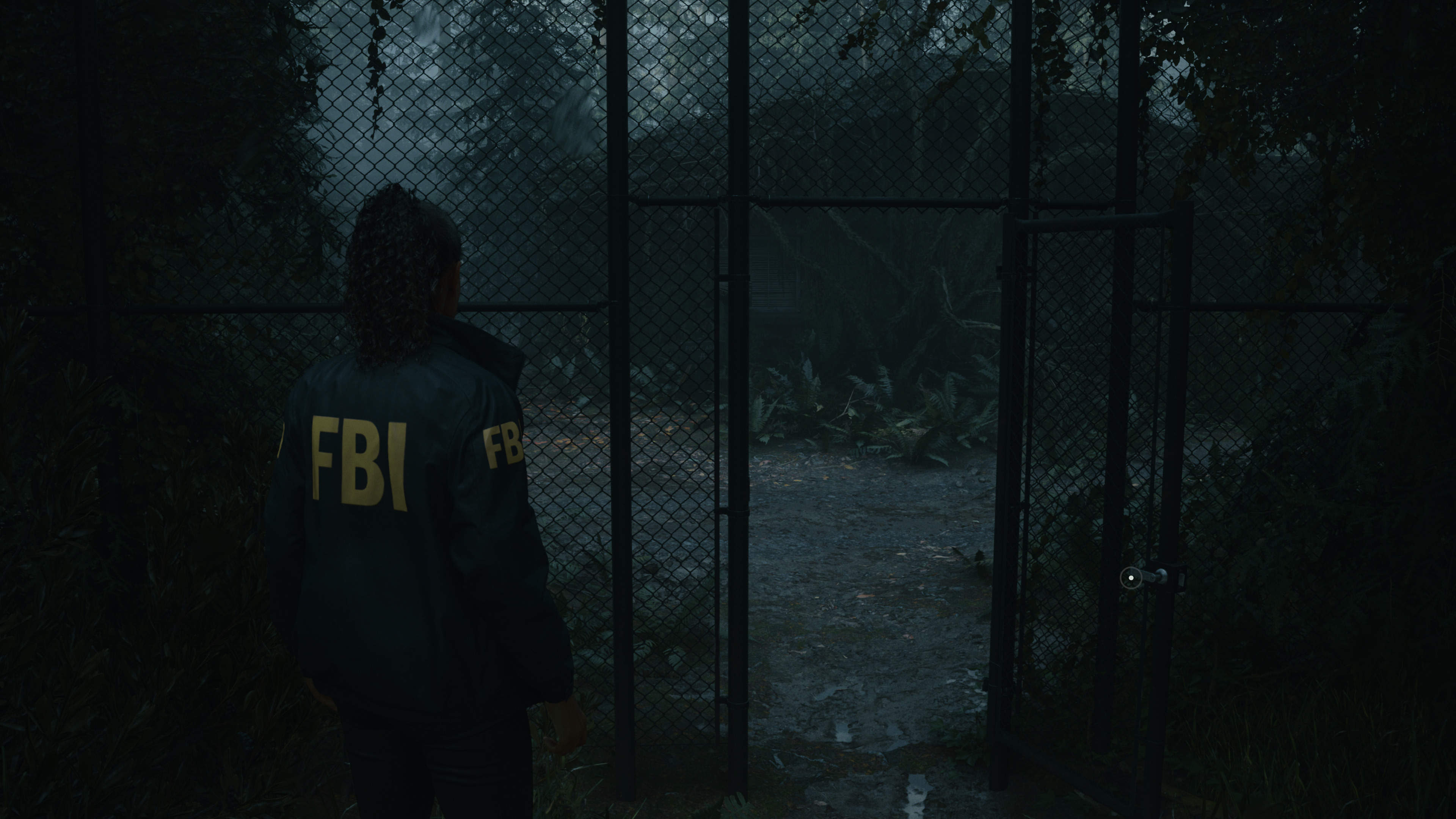
High Quality
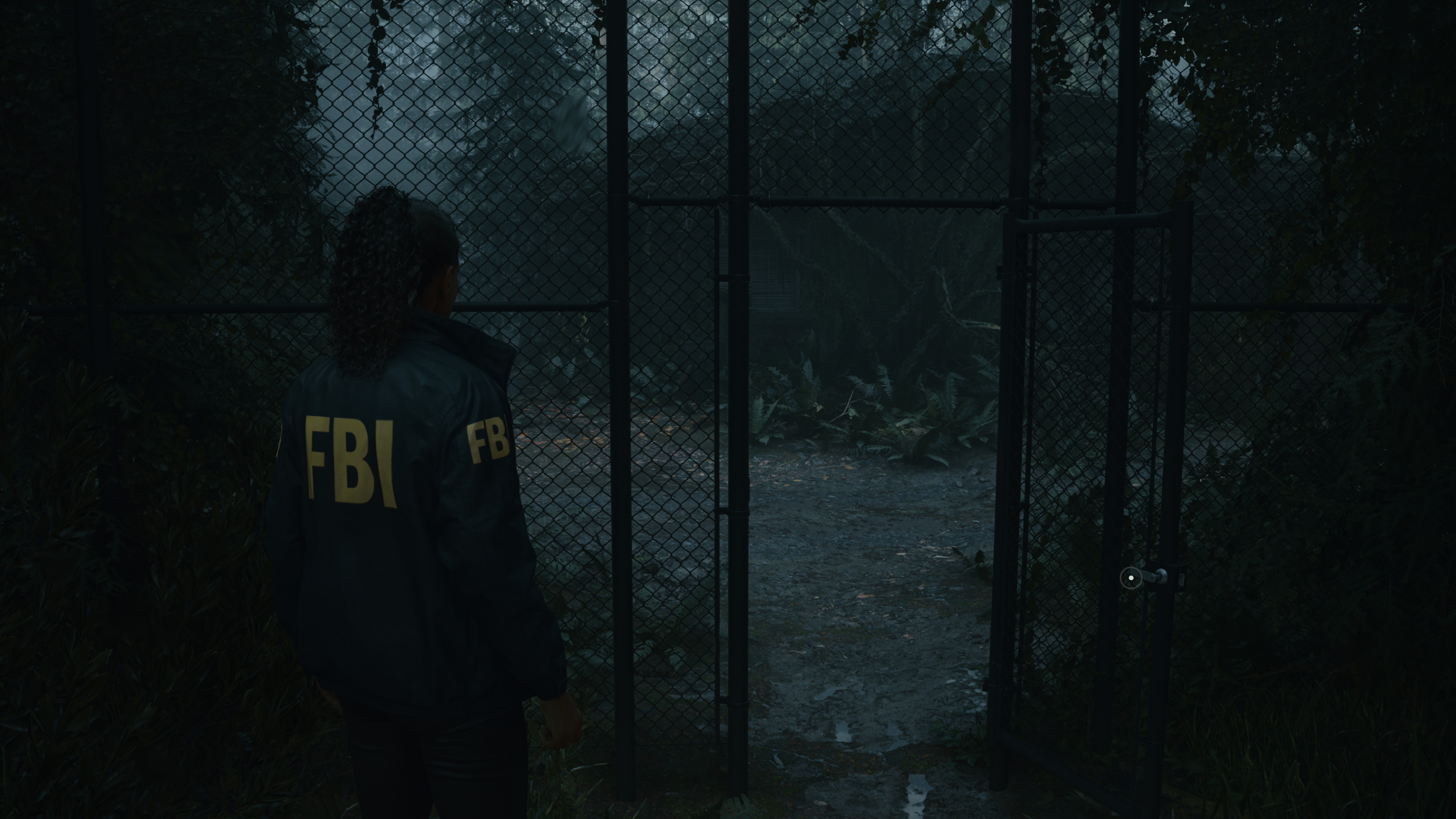
Max Quality (no RT)
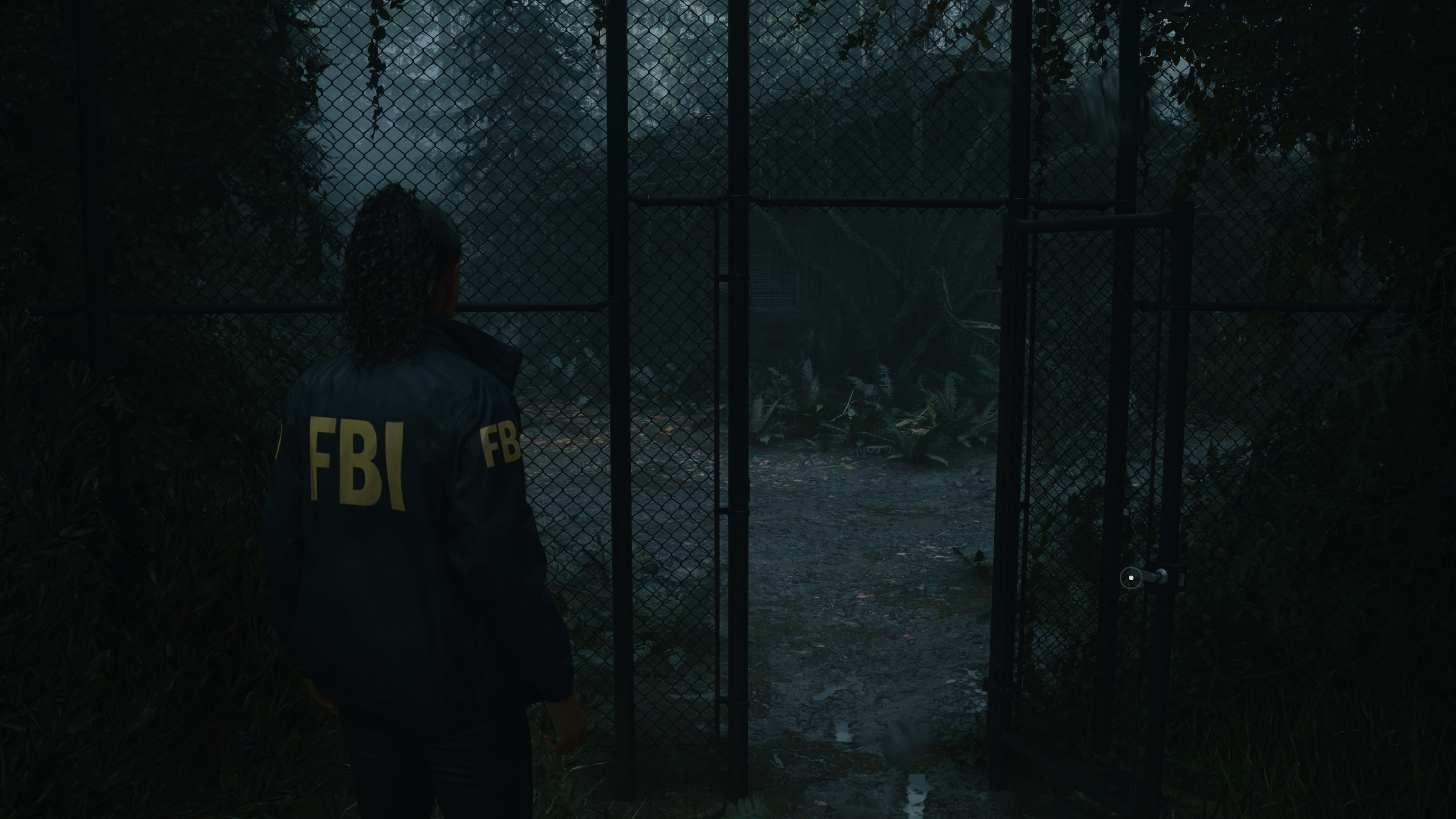
Max Quality plus RT Low and Ray Reconstruction
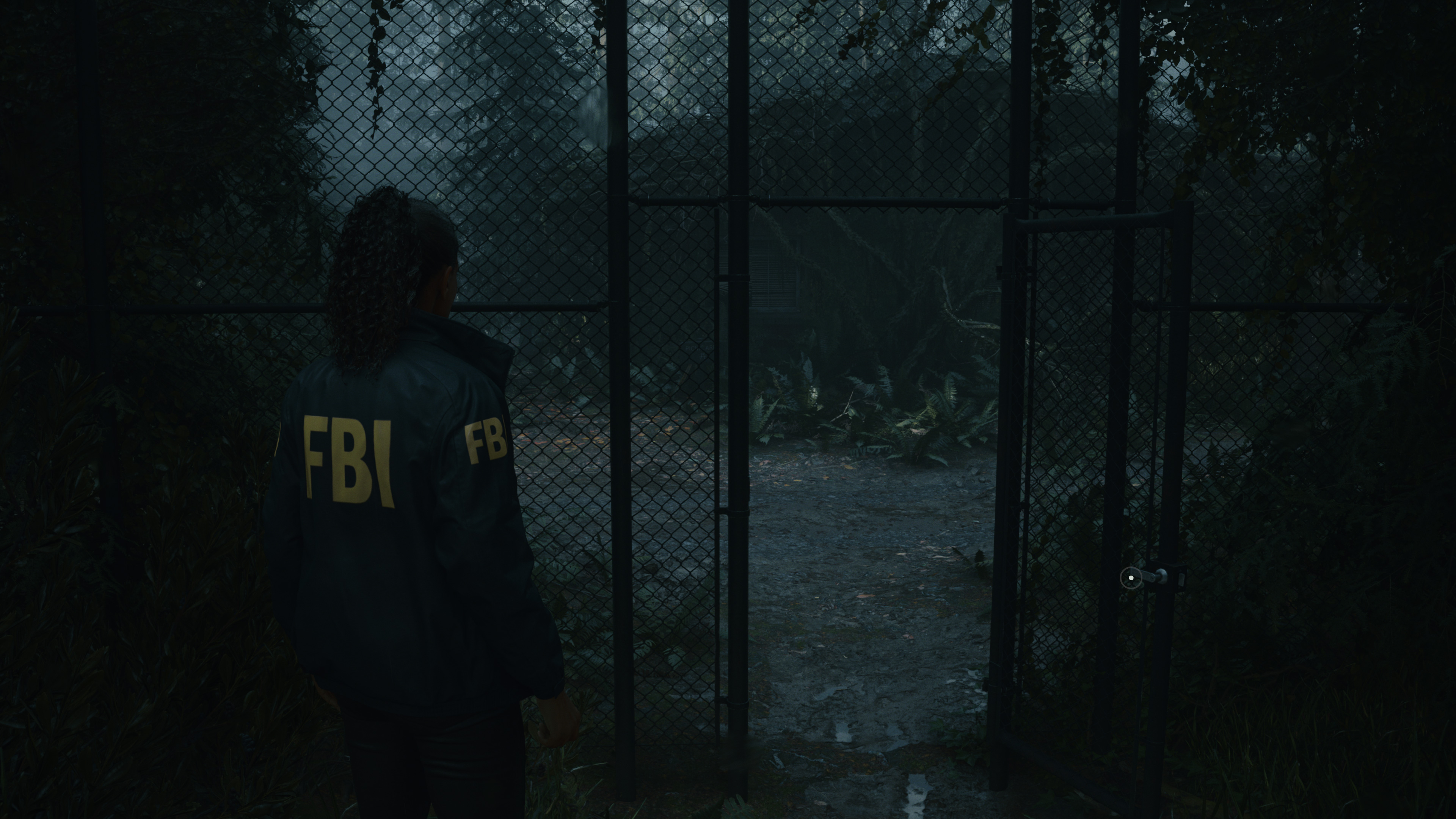
Max Quality plus RT Low
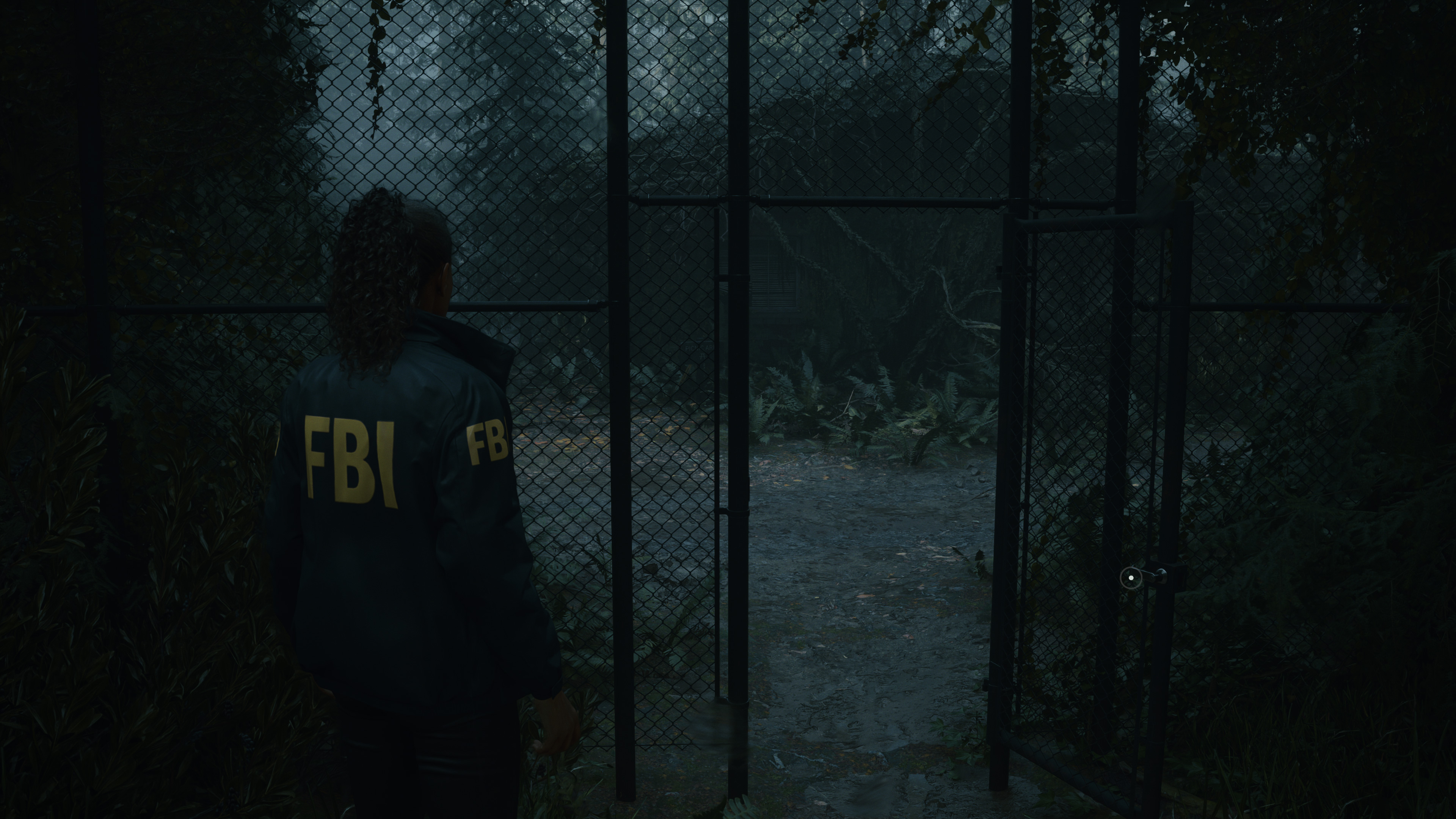
Max Quality plus RT Medium and Ray Reconstruction
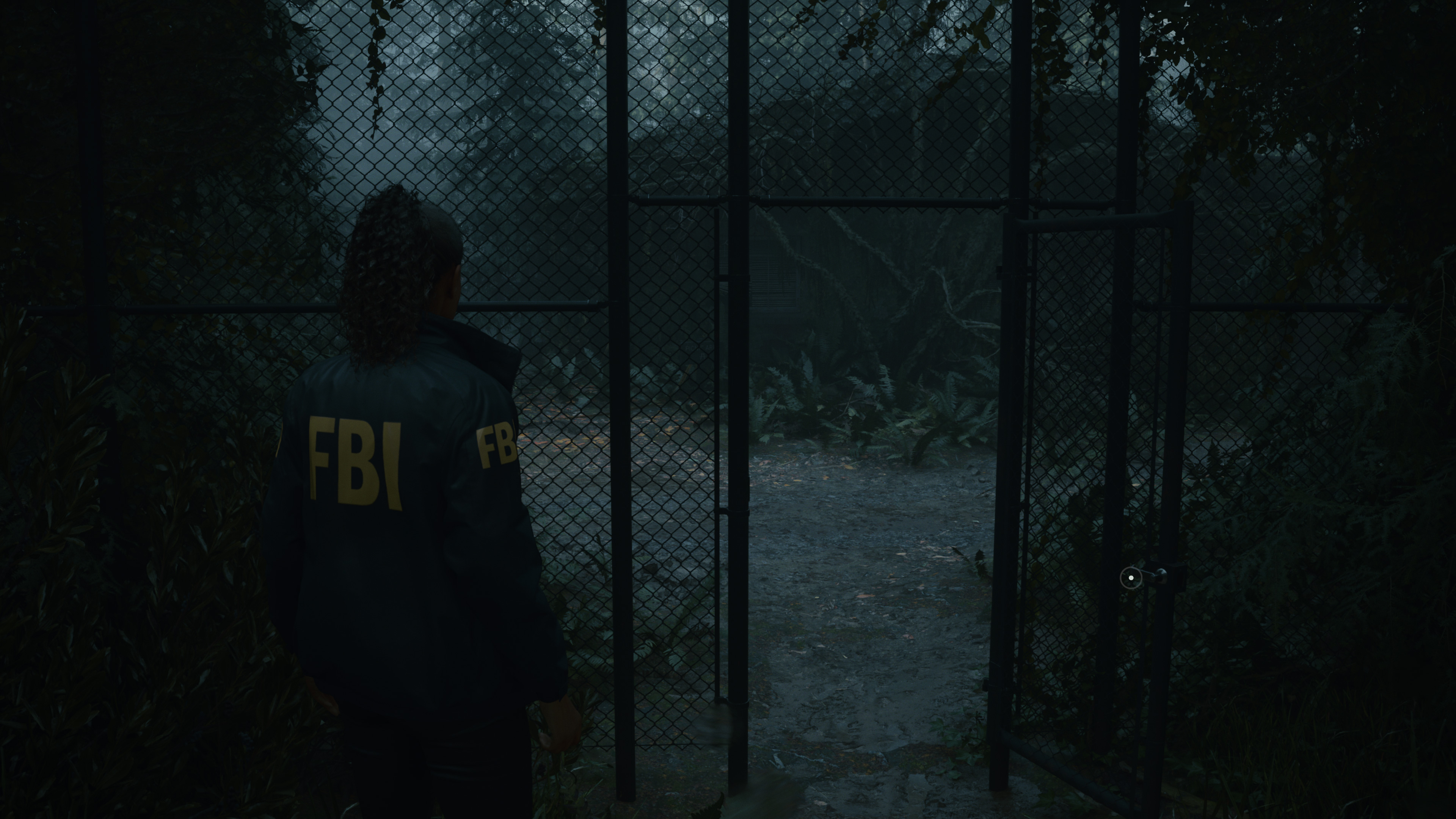
Max Quality plus RT Medium
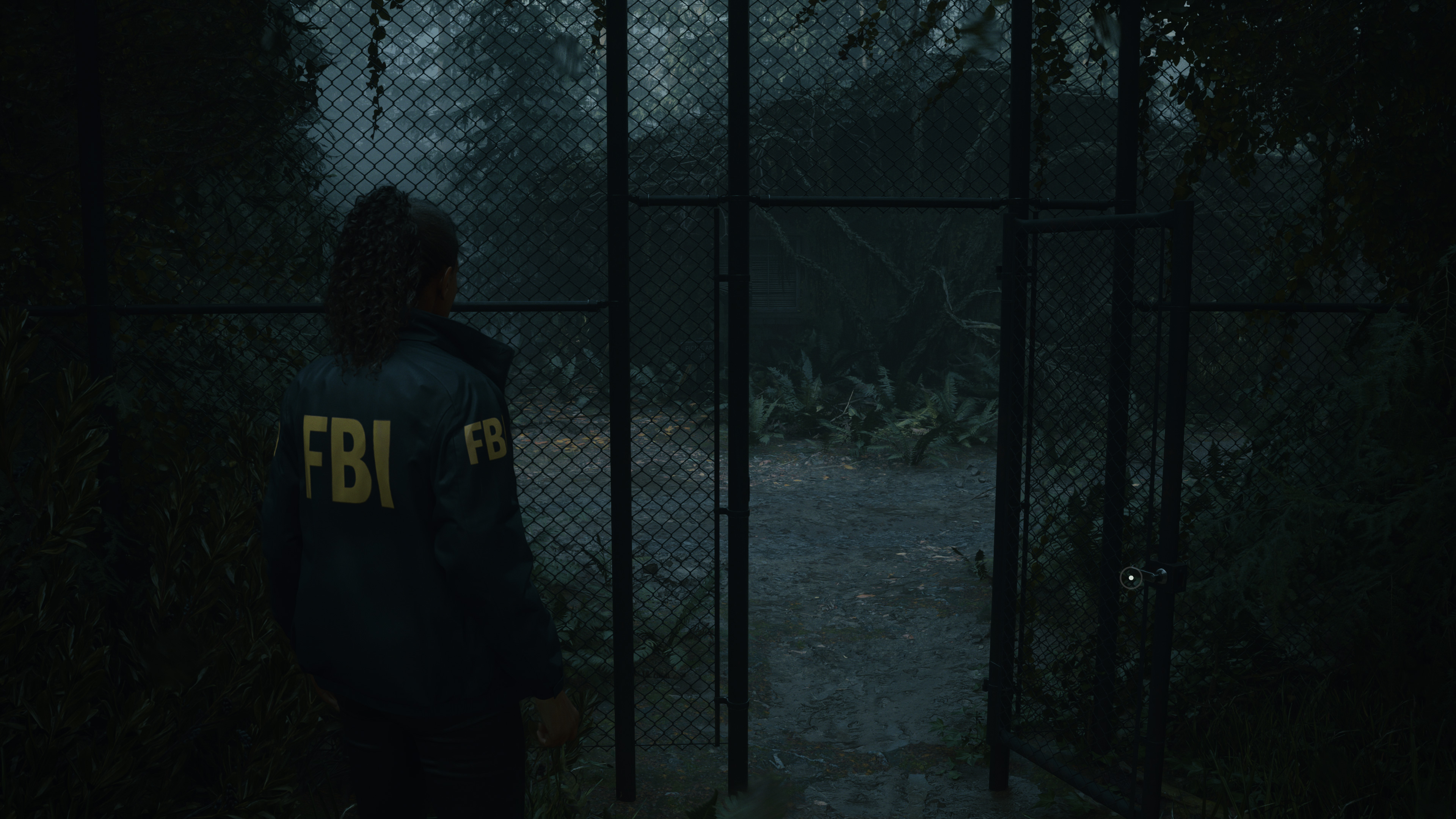
Max Quality plus RT High and Ray Reconstruction

Max Quality plus RT High

Minimum Quality
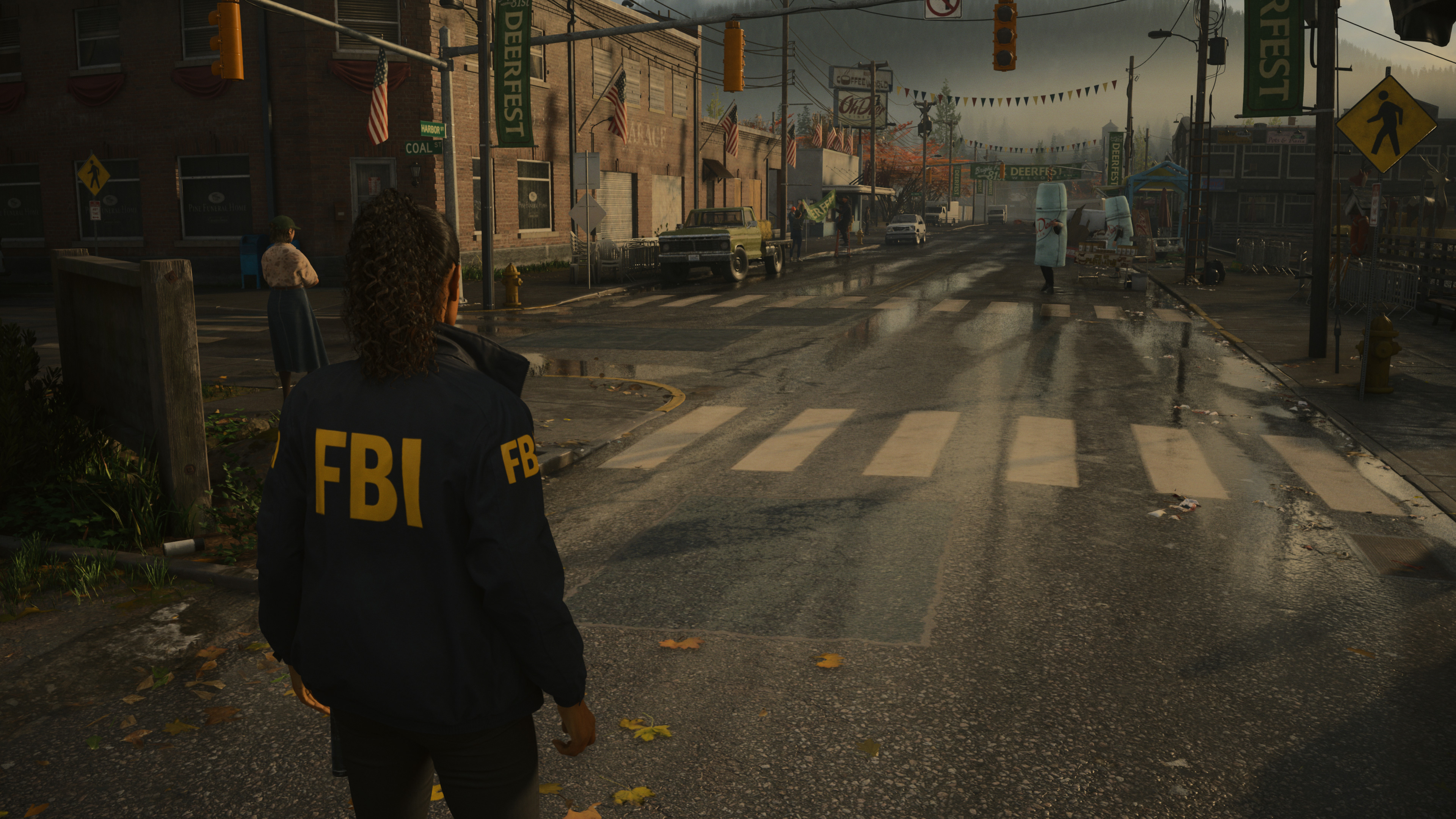
Low Quality
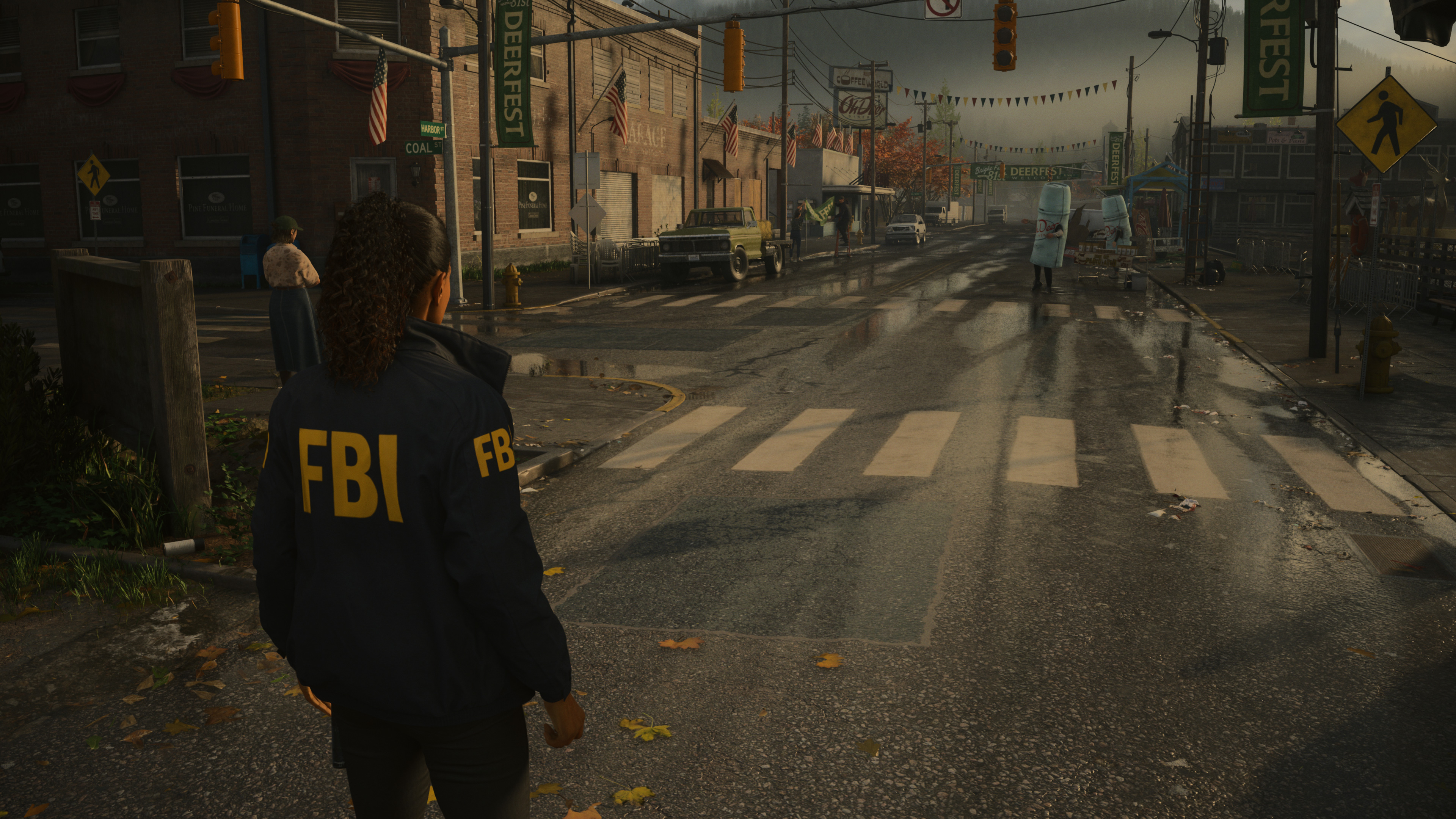
Medium Quality
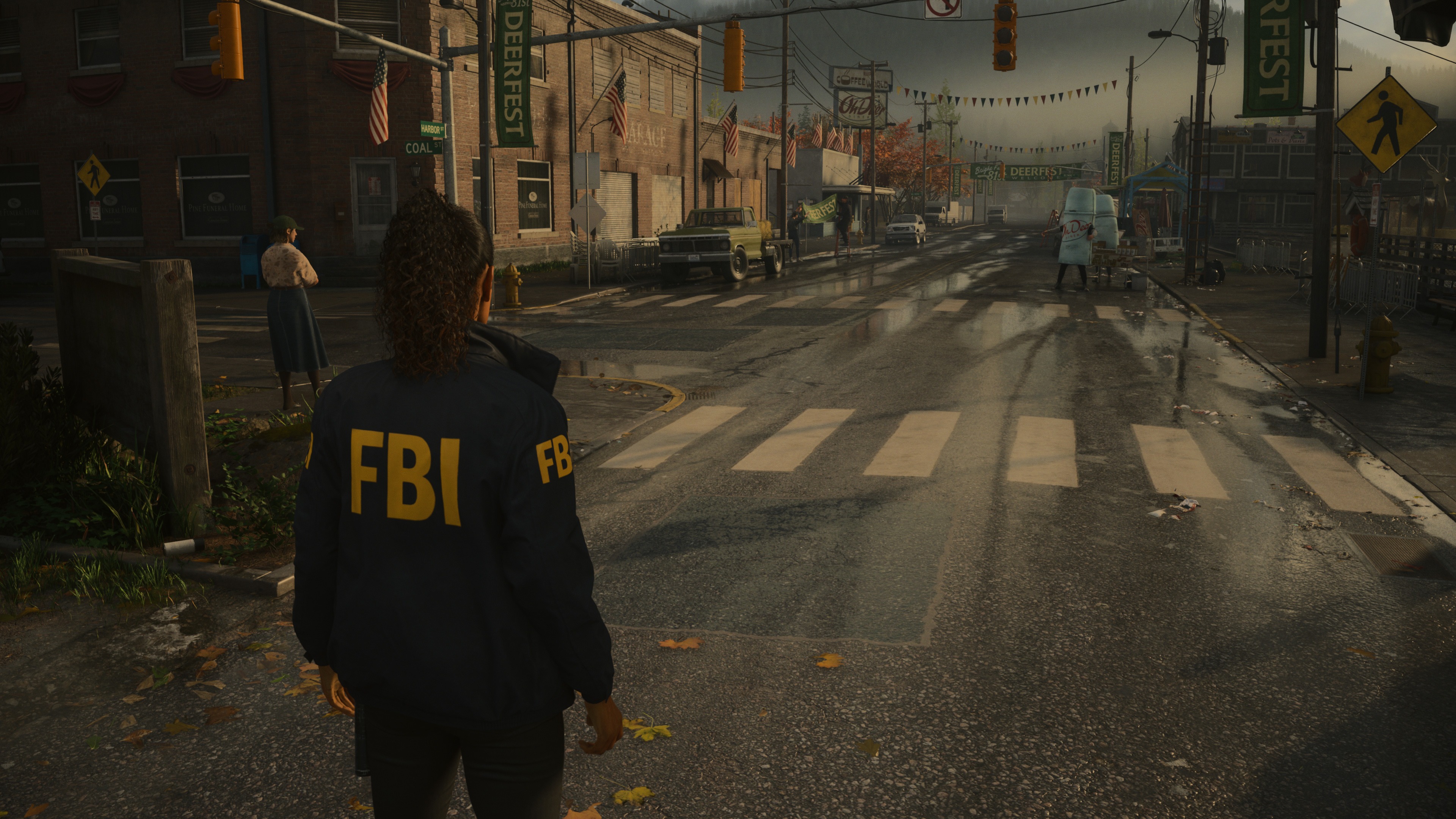
High Quality
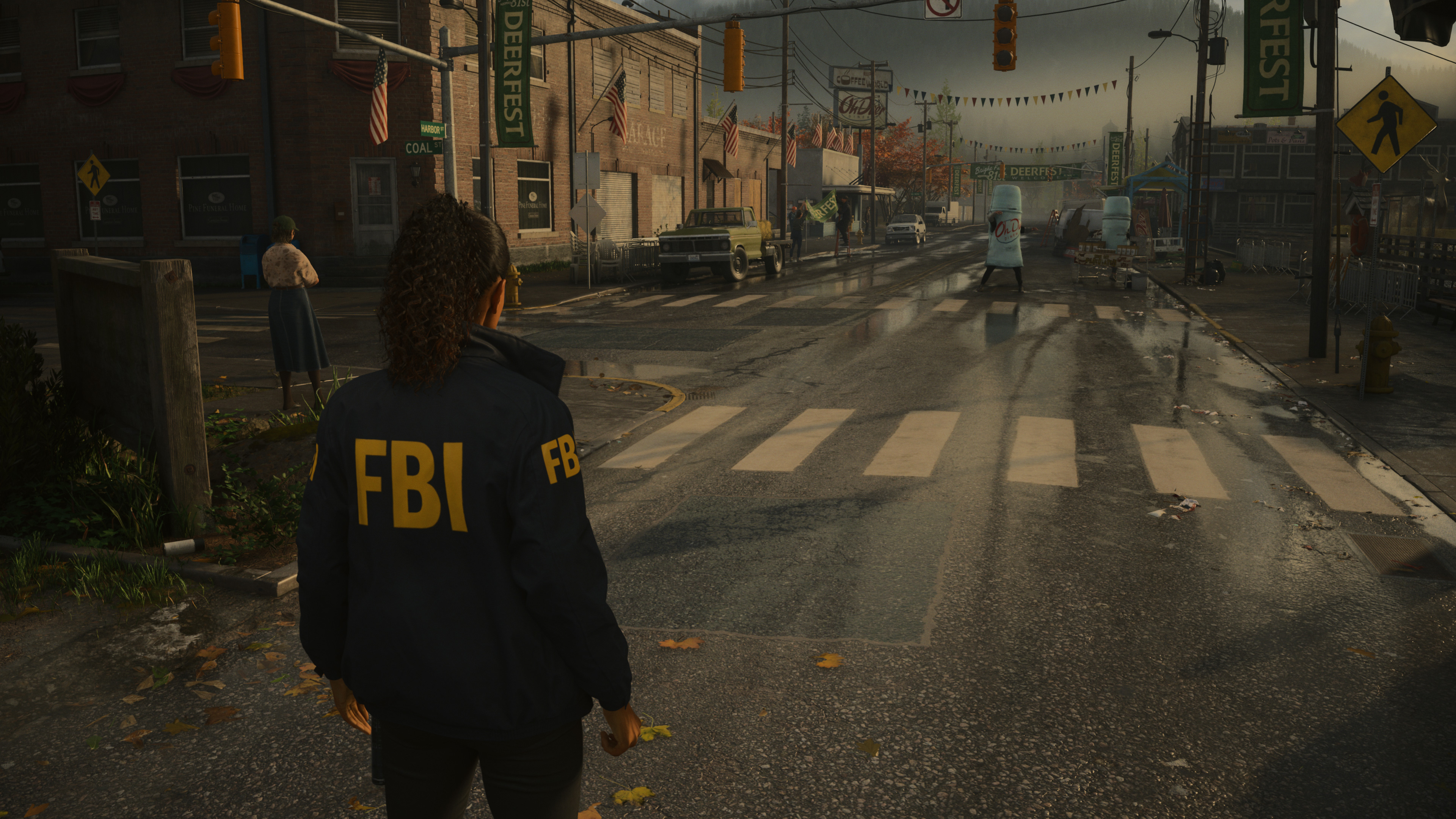
Max Quality (no RT)
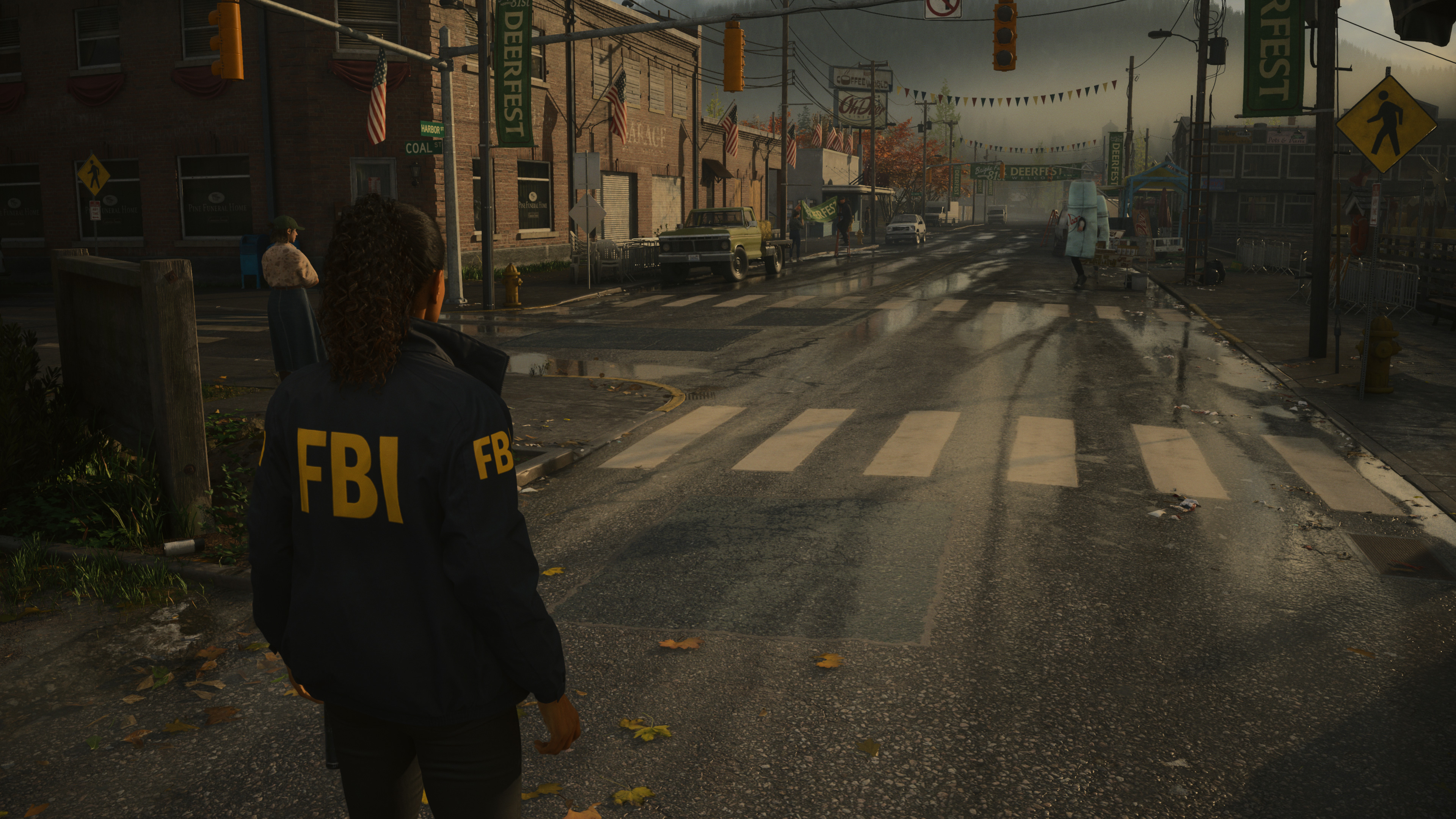
Max Quality plus RT Low and Ray Reconstruction

Max Quality plus RT Low
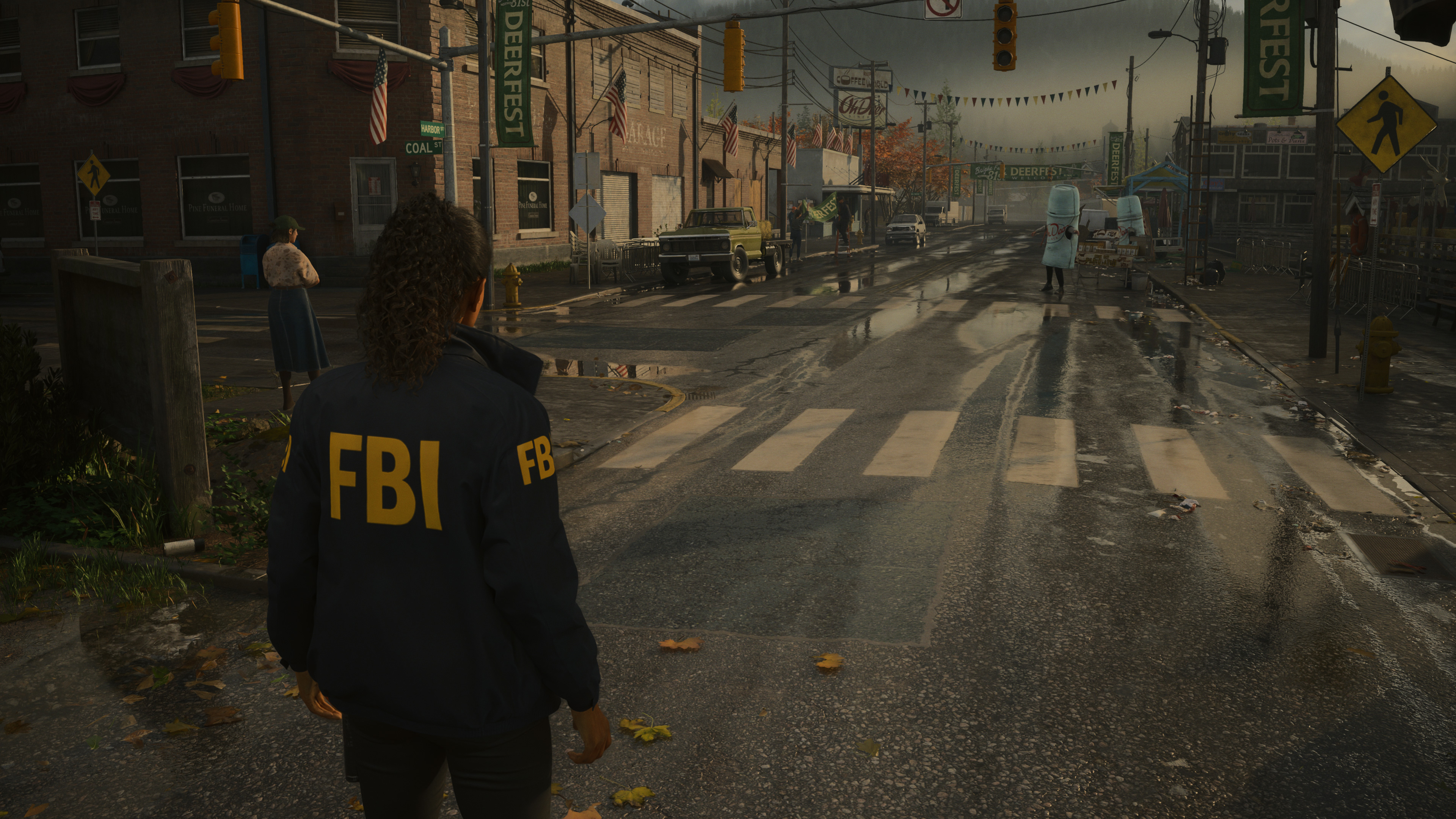
Max Quality plus RT Medium and Ray Reconstruction

Max Quality plus RT Medium
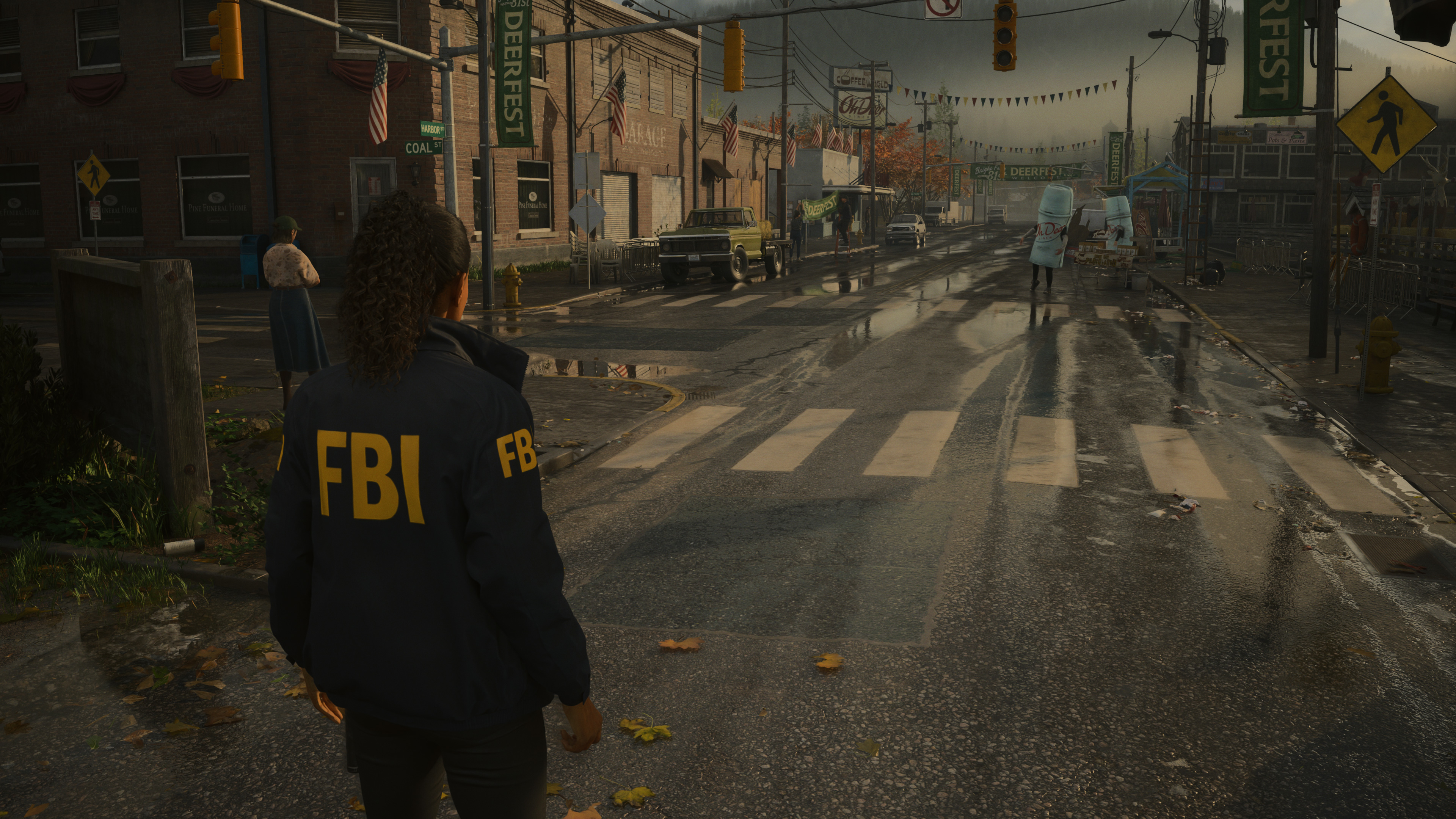
Max Quality plus RT High and Ray Reconstruction

Max Quality plus RT High

Minimum Quality

Low Quality

Medium Quality
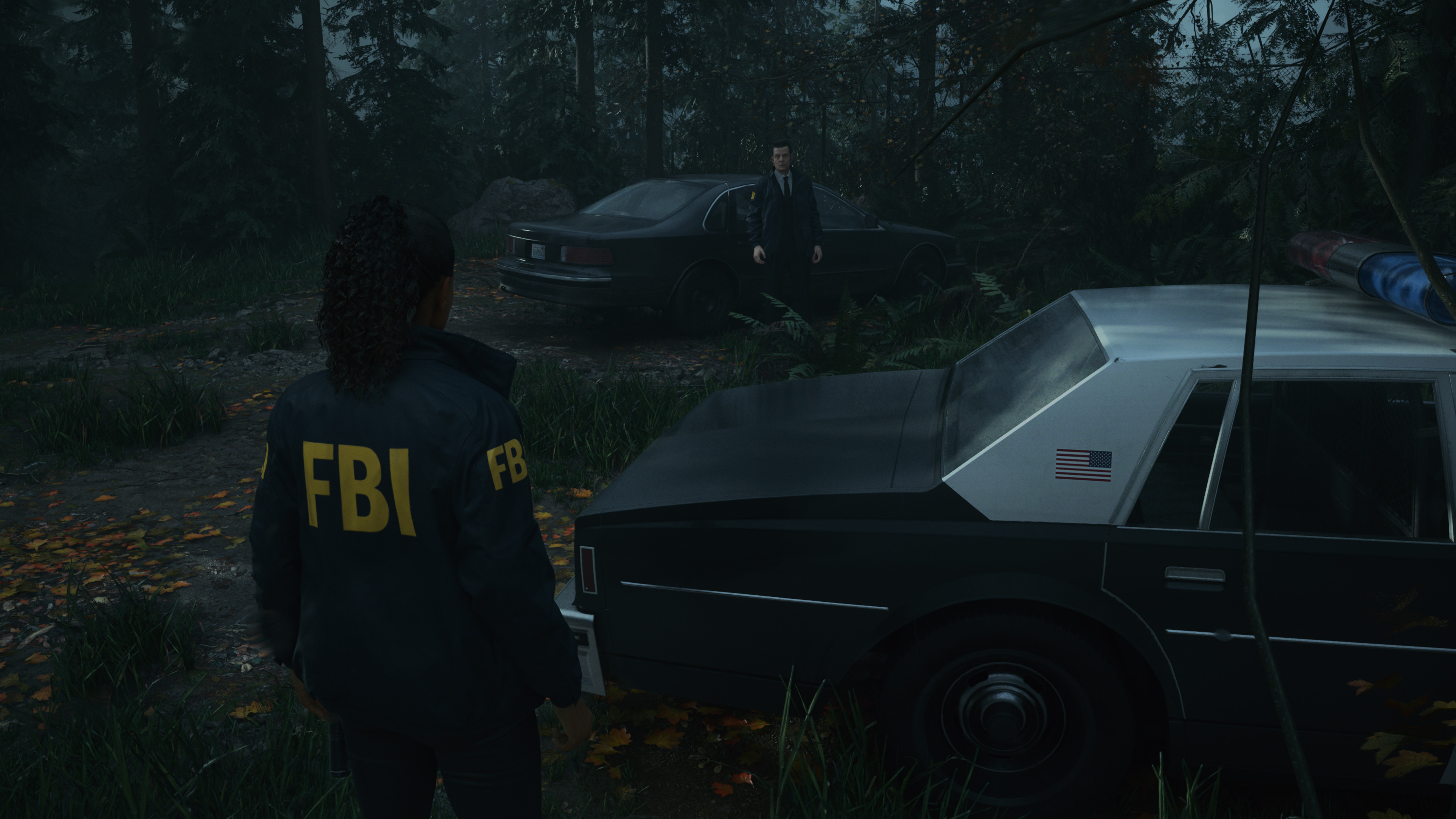
High Quality

Max Quality (no RT)
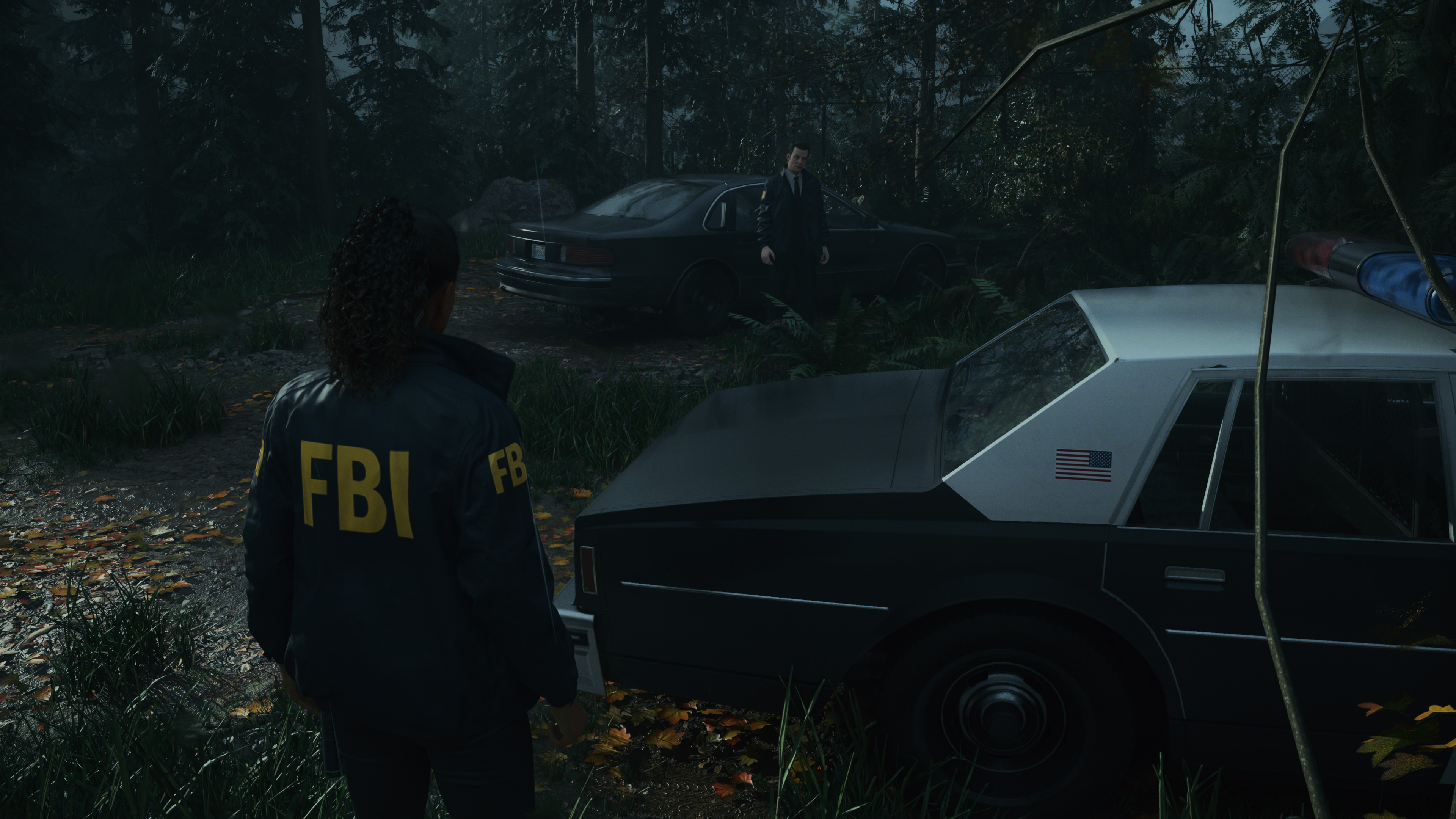
Max Quality plus RT Low and Ray Reconstruction

Max Quality plus RT Low

Max Quality plus RT Medium and Ray Reconstruction

Max Quality plus RT Medium

Max Quality plus RT High and Ray Reconstruction

Max Quality plus RT High
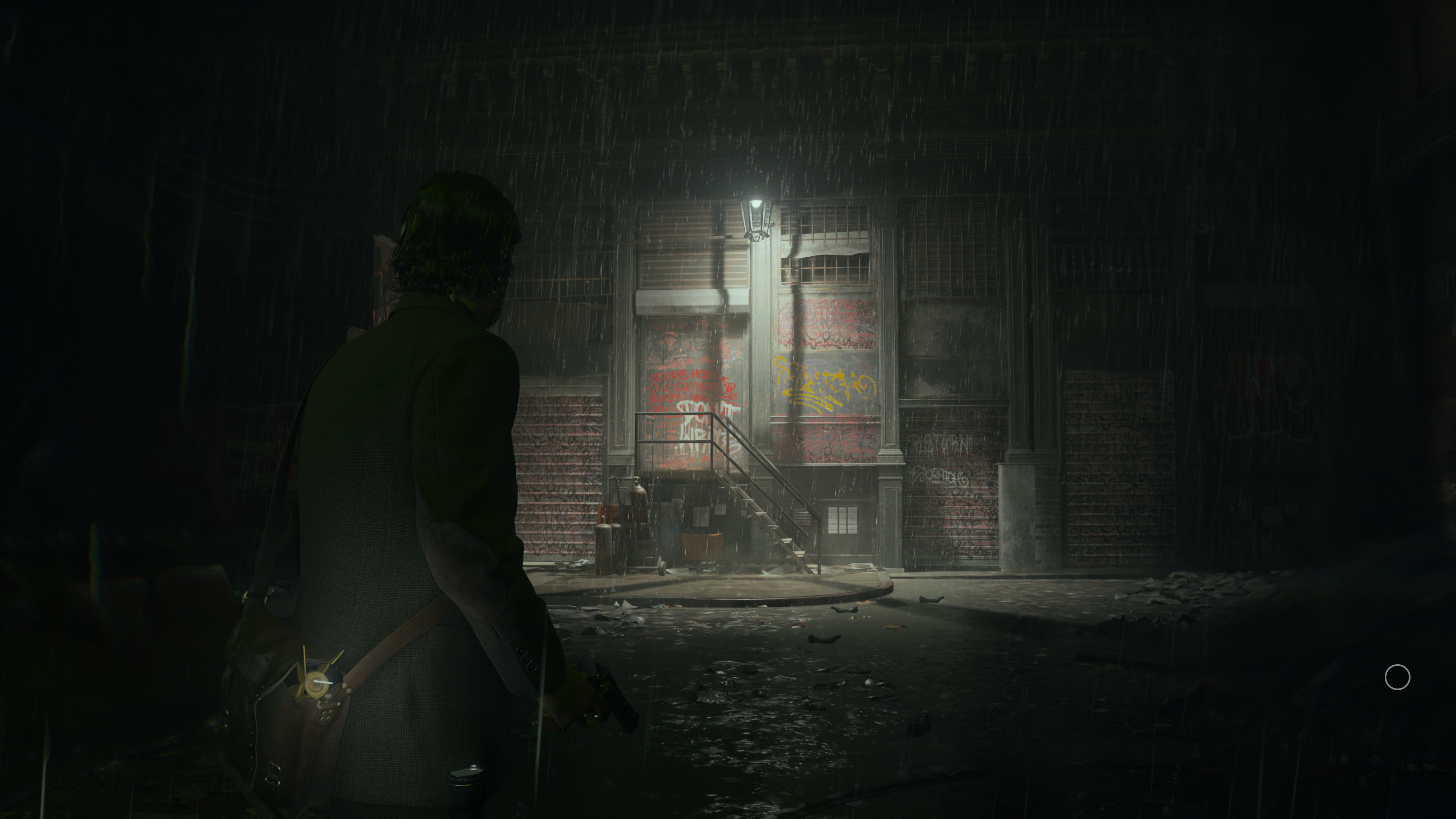
Minimum Quality
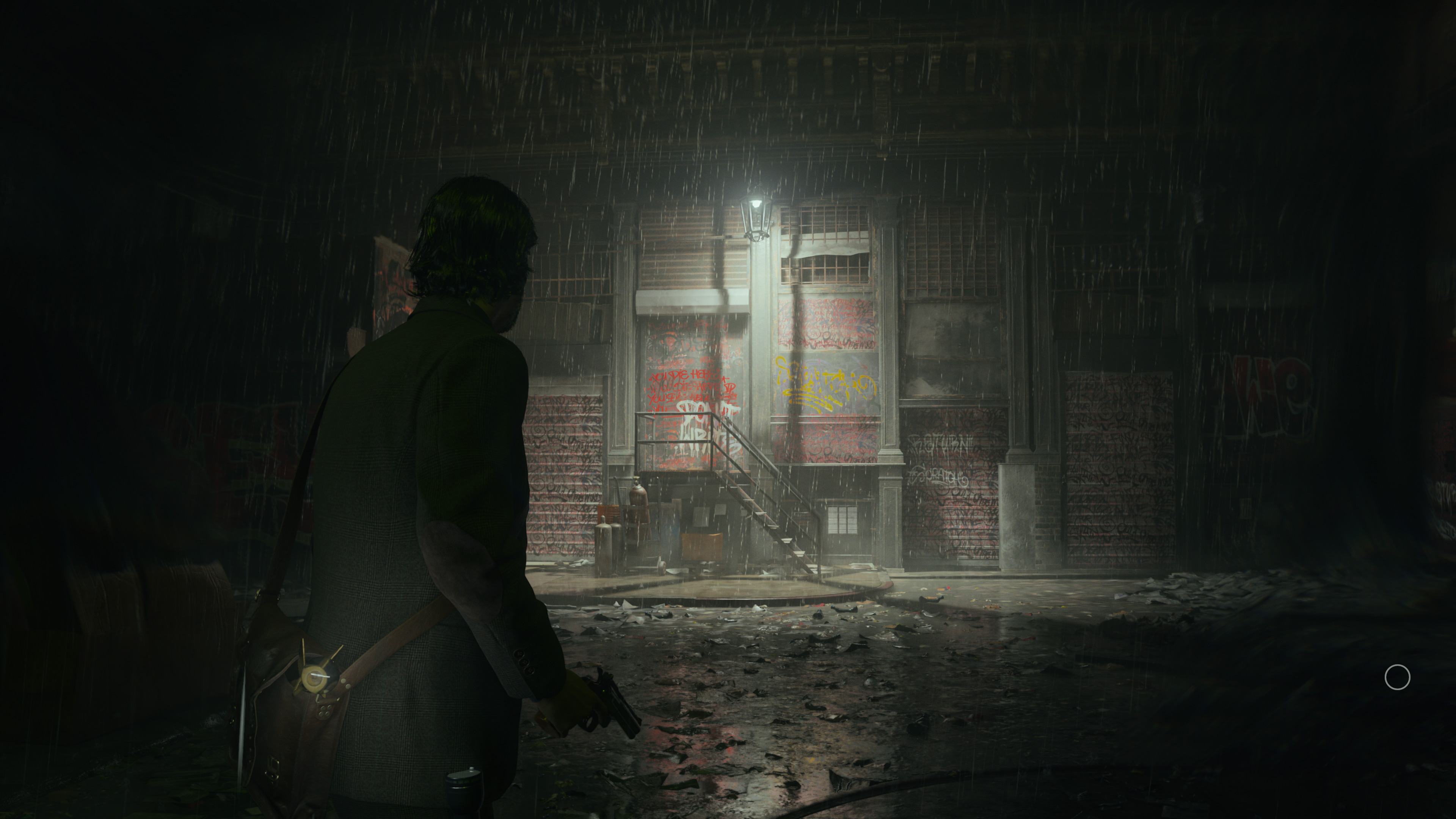
Low Quality

Medium Quality

High Quality
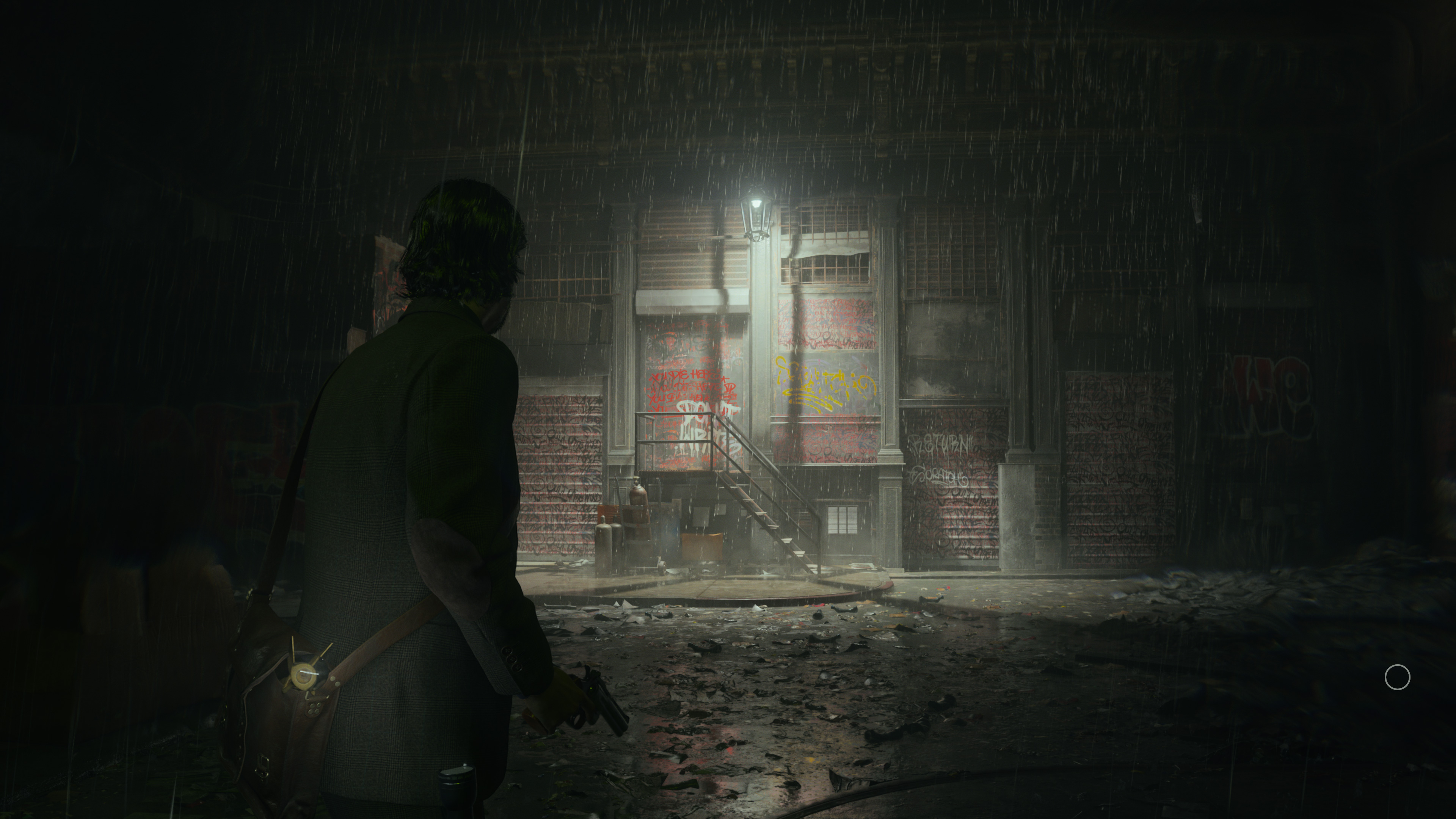
Max Quality (no RT)

Max Quality plus RT Low and Ray Reconstruction
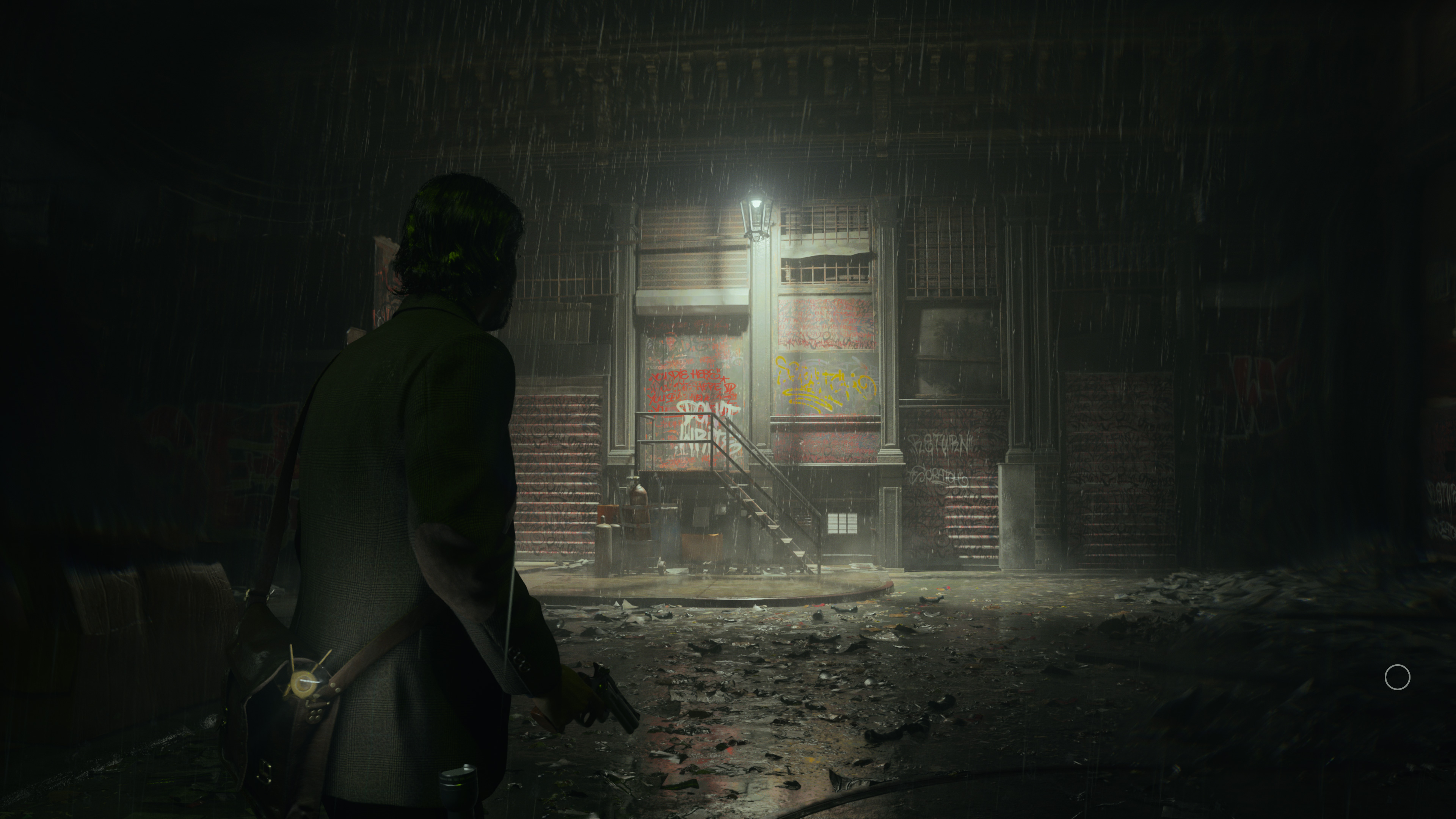
Max Quality plus RT Low

Max Quality plus RT Medium and Ray Reconstruction

Max Quality plus RT Medium
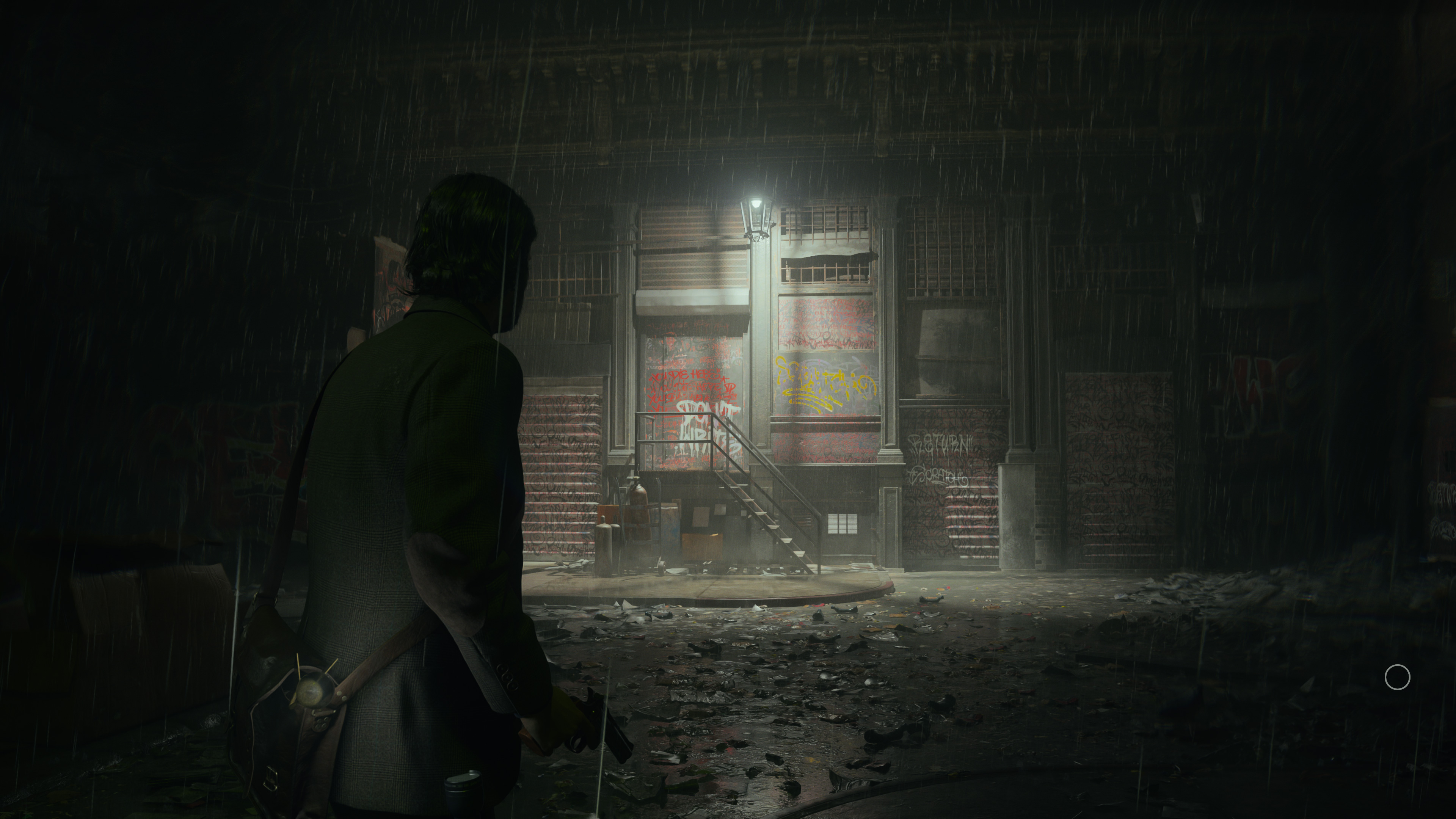
Max Quality plus RT High and Ray Reconstruction
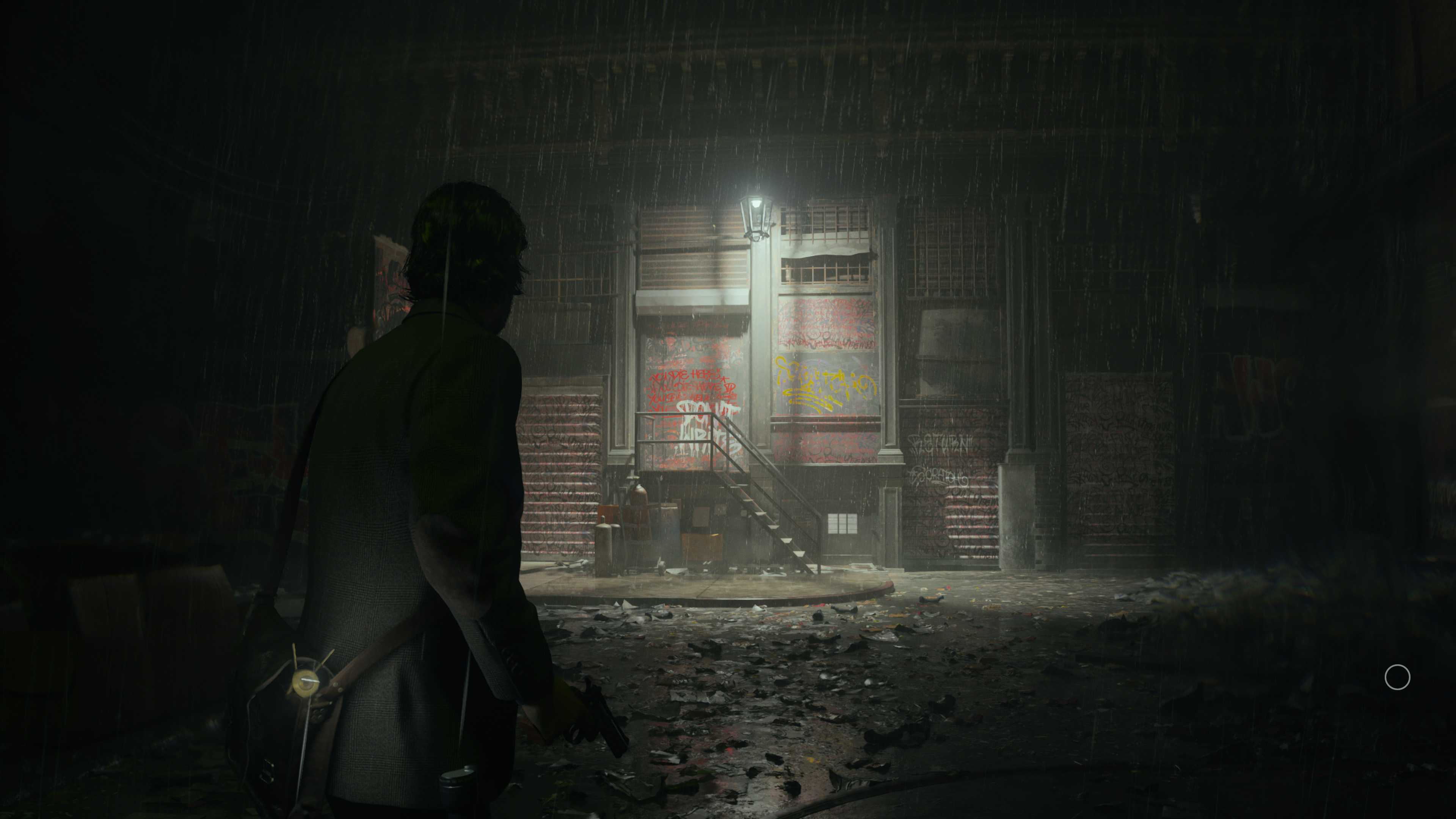
Max Quality plus RT High
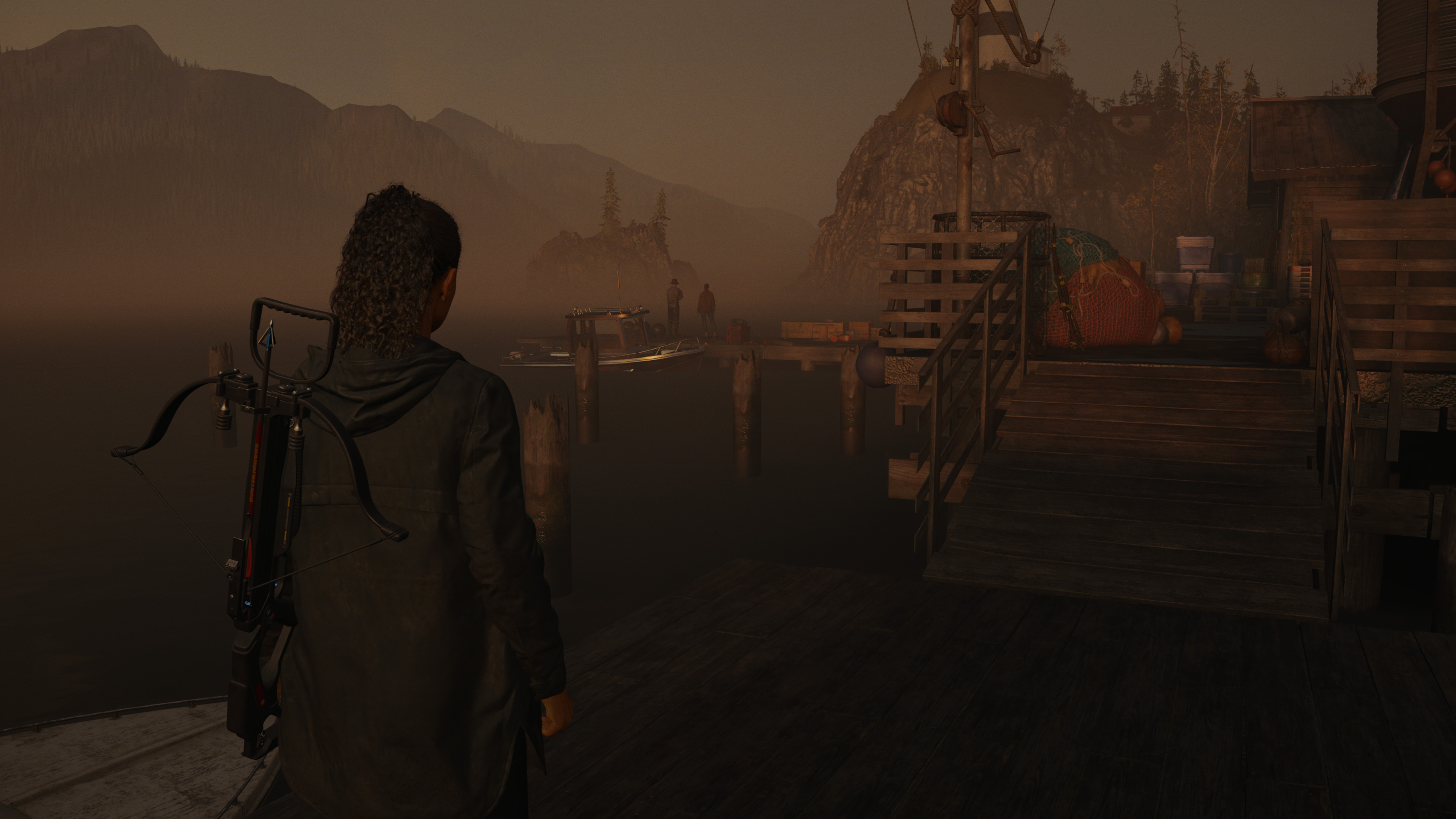
Minimum Quality
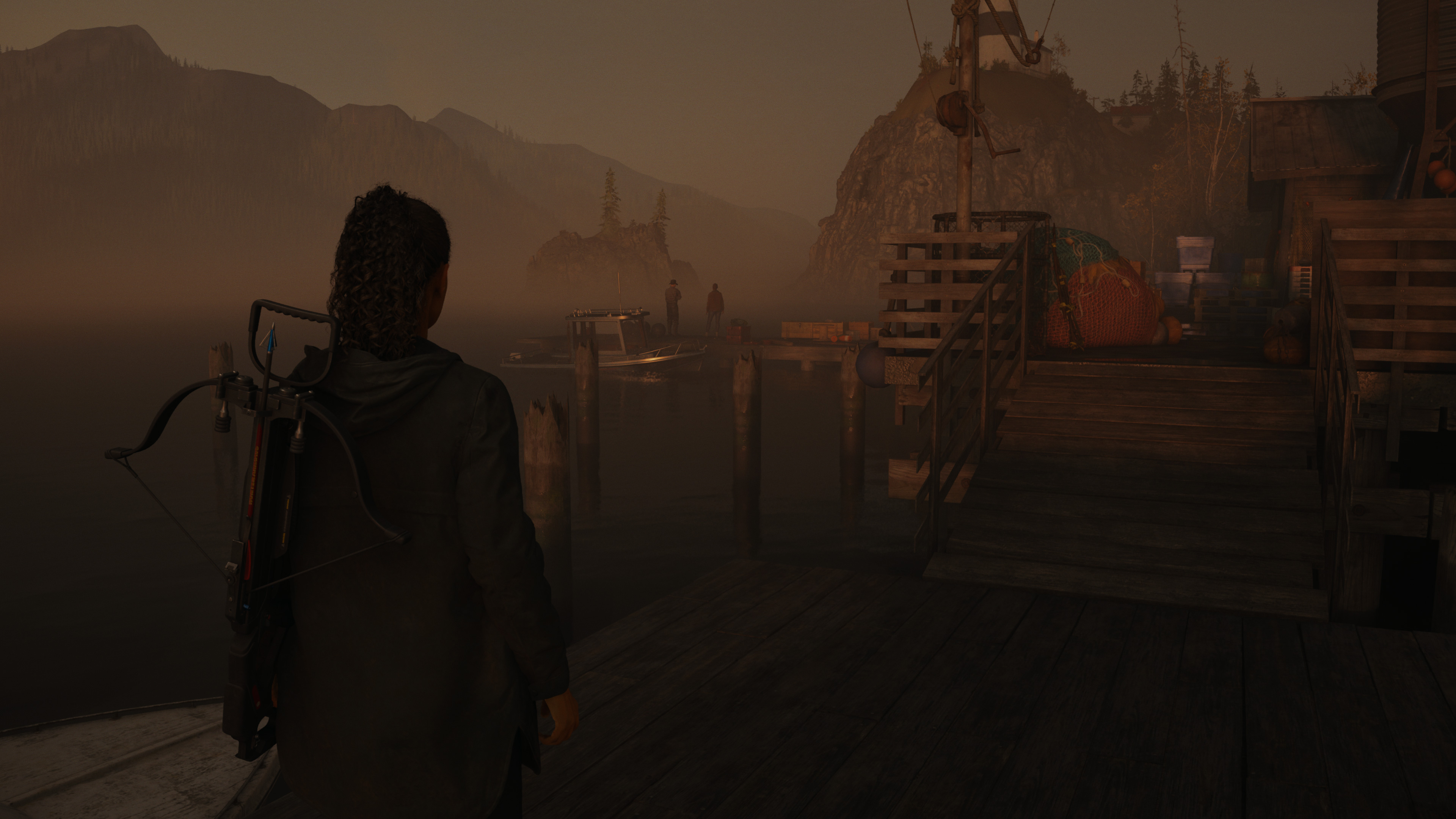
Low Quality
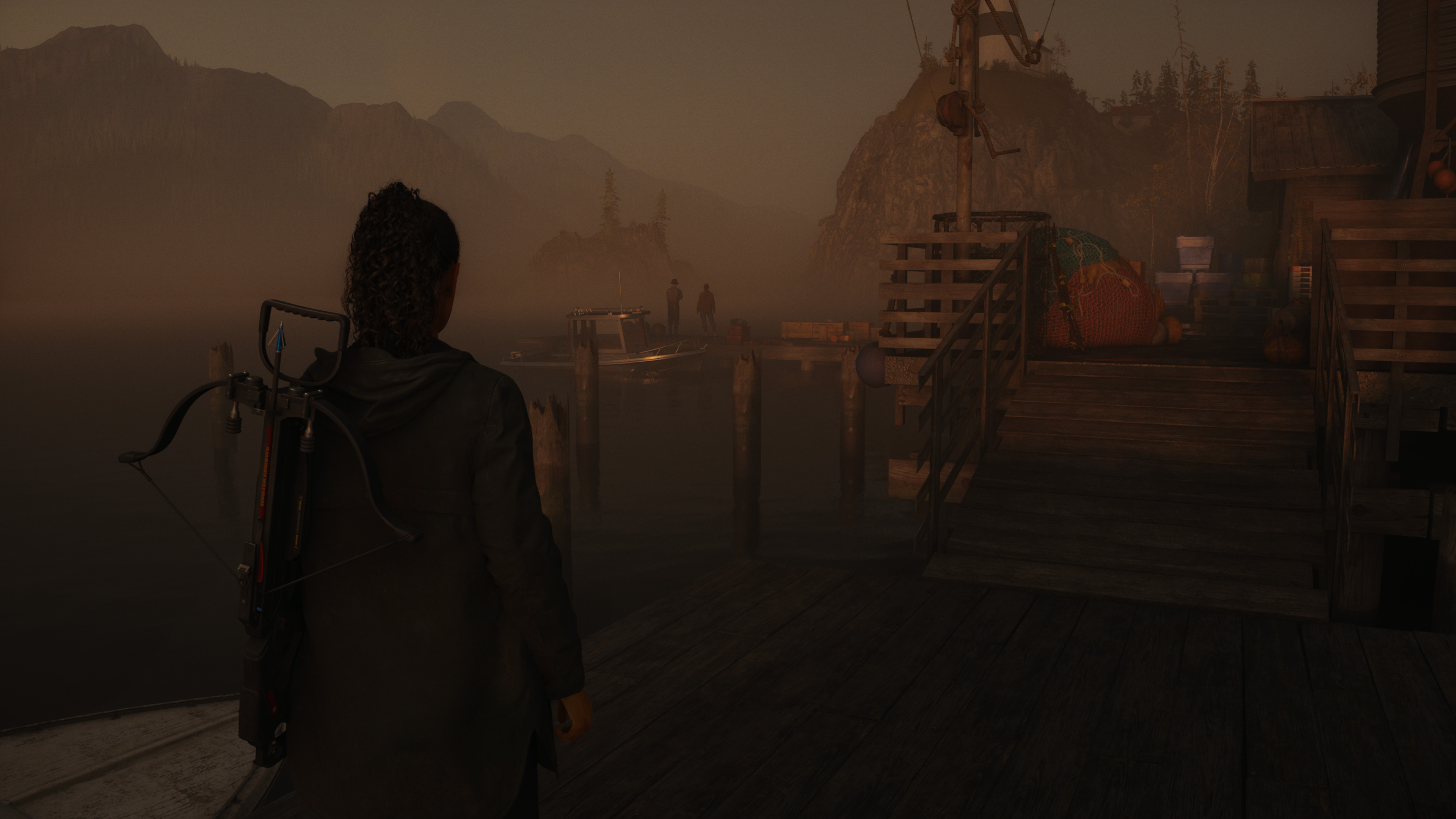
Medium Quality

High Quality

Max Quality (no RT)
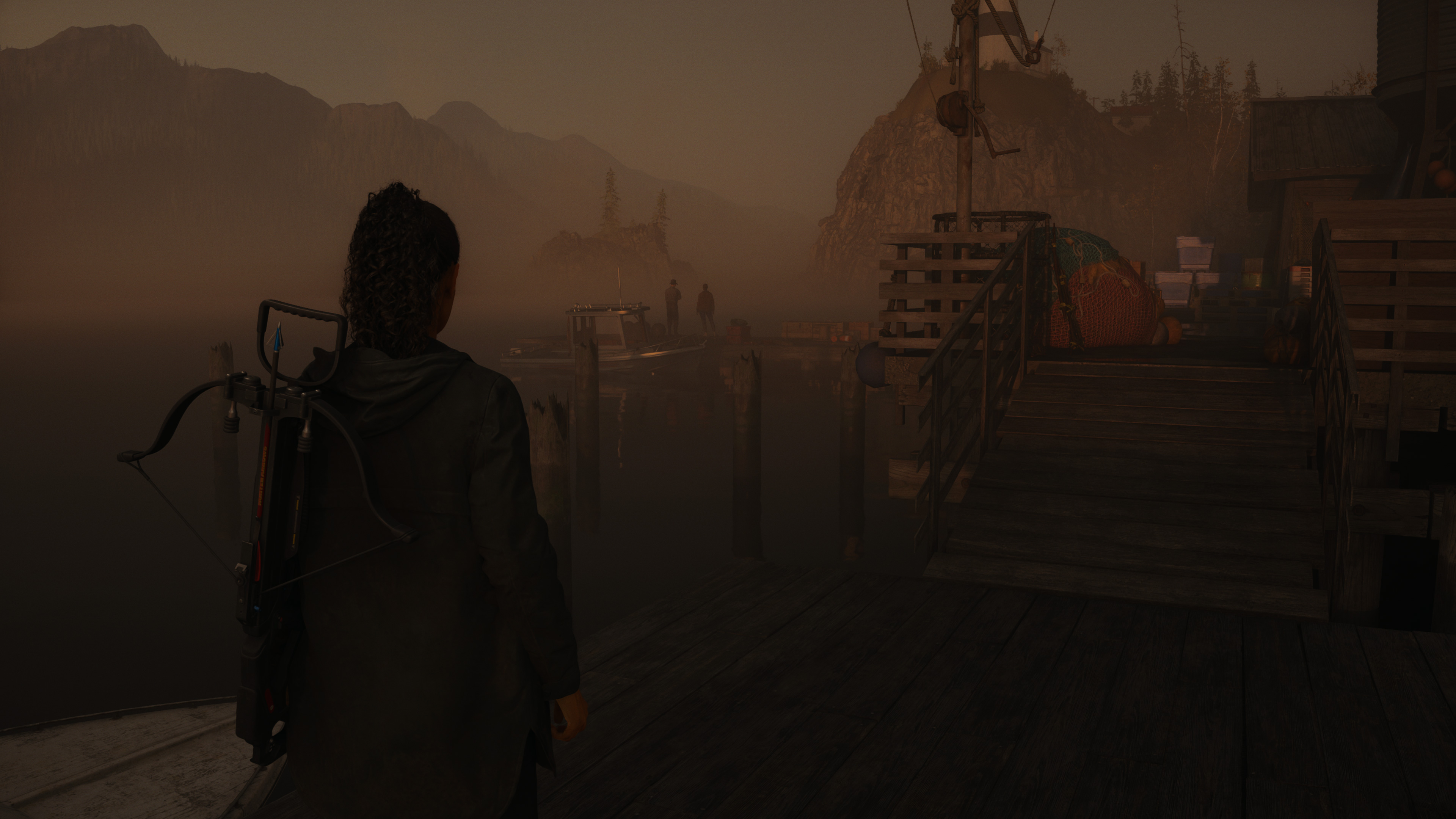
Max Quality plus RT Low and Ray Reconstruction
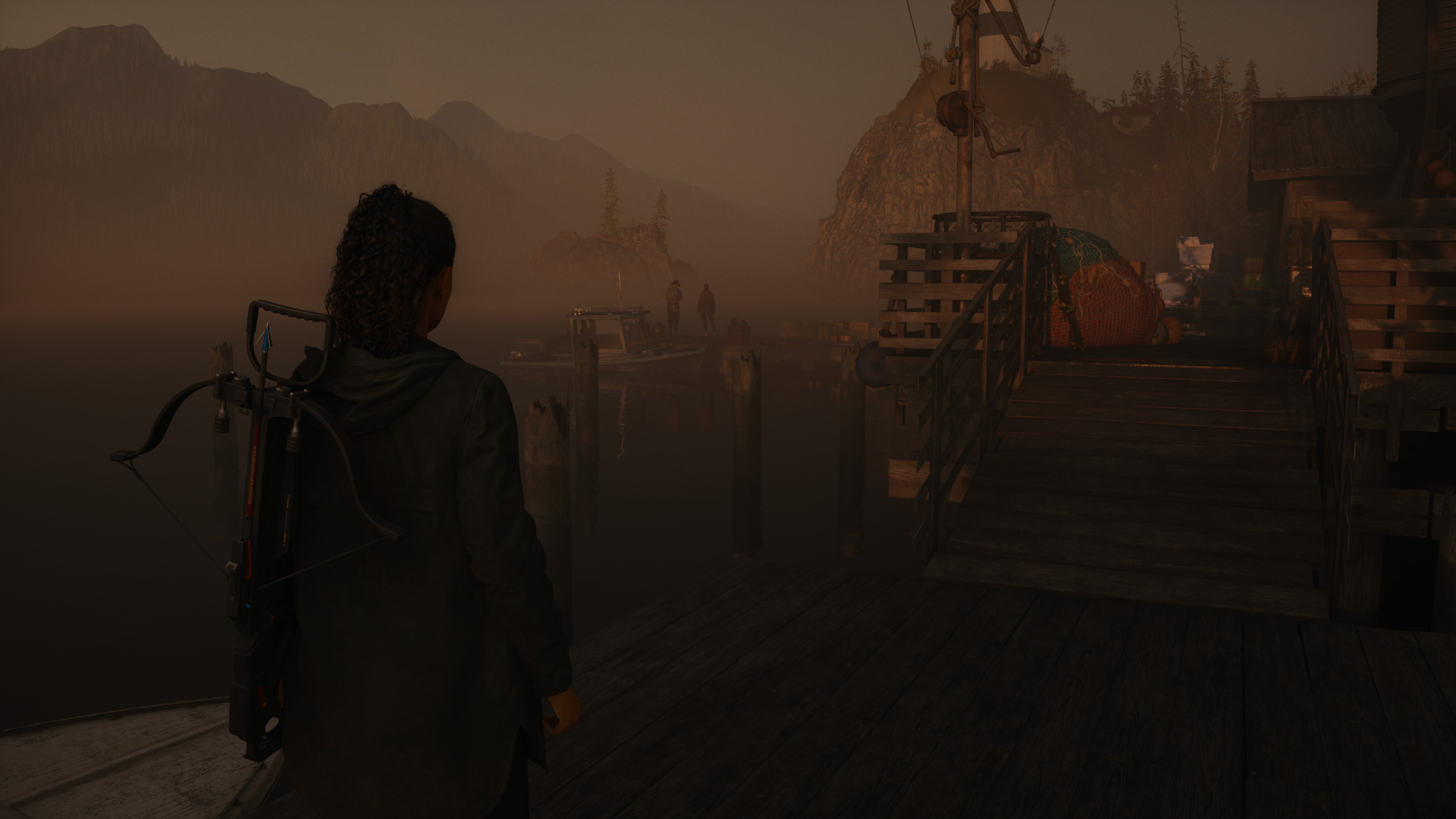
Max Quality plus RT Low
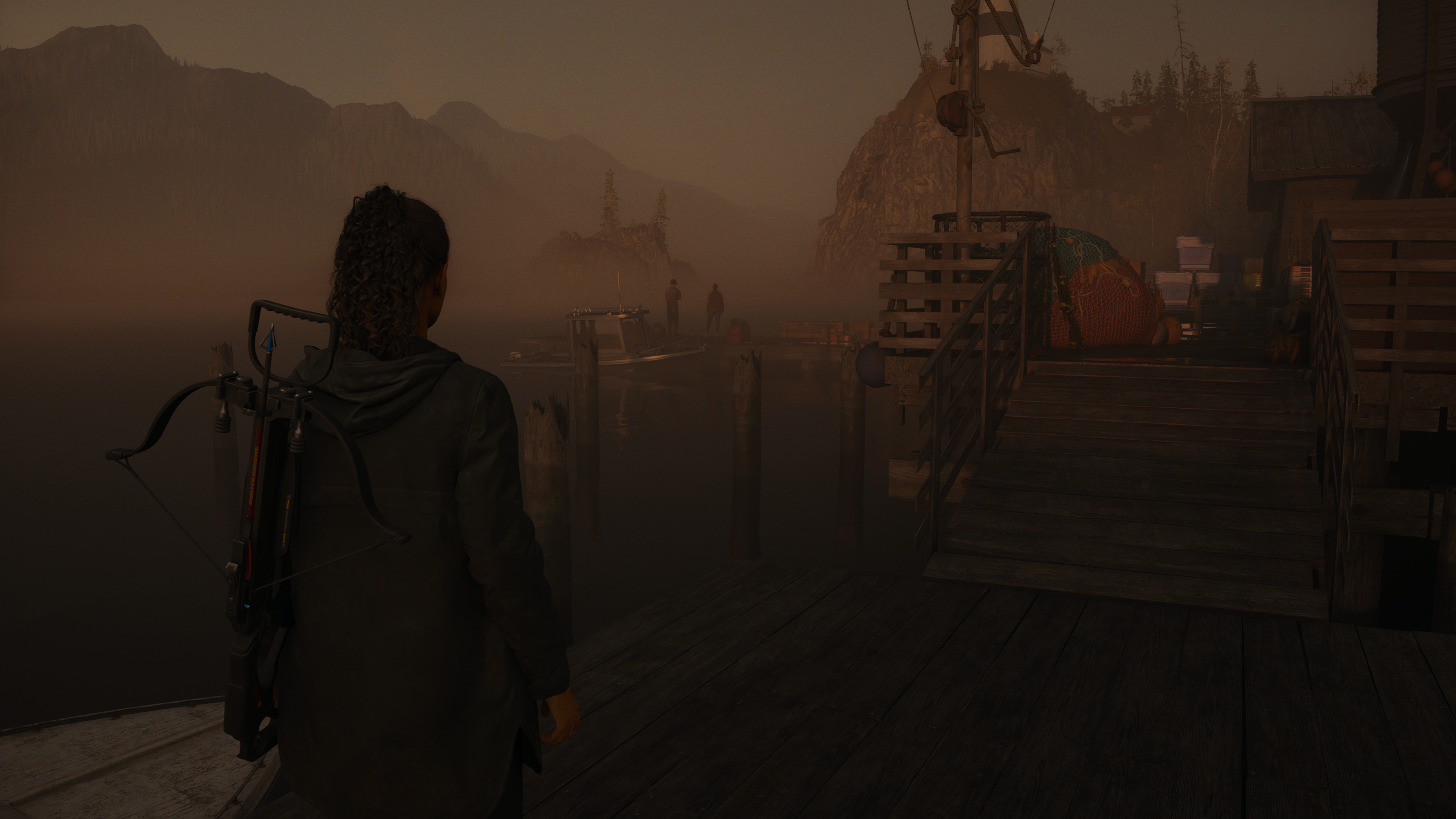
Max Quality plus RT Medium and Ray Reconstruction

Max Quality plus RT Medium
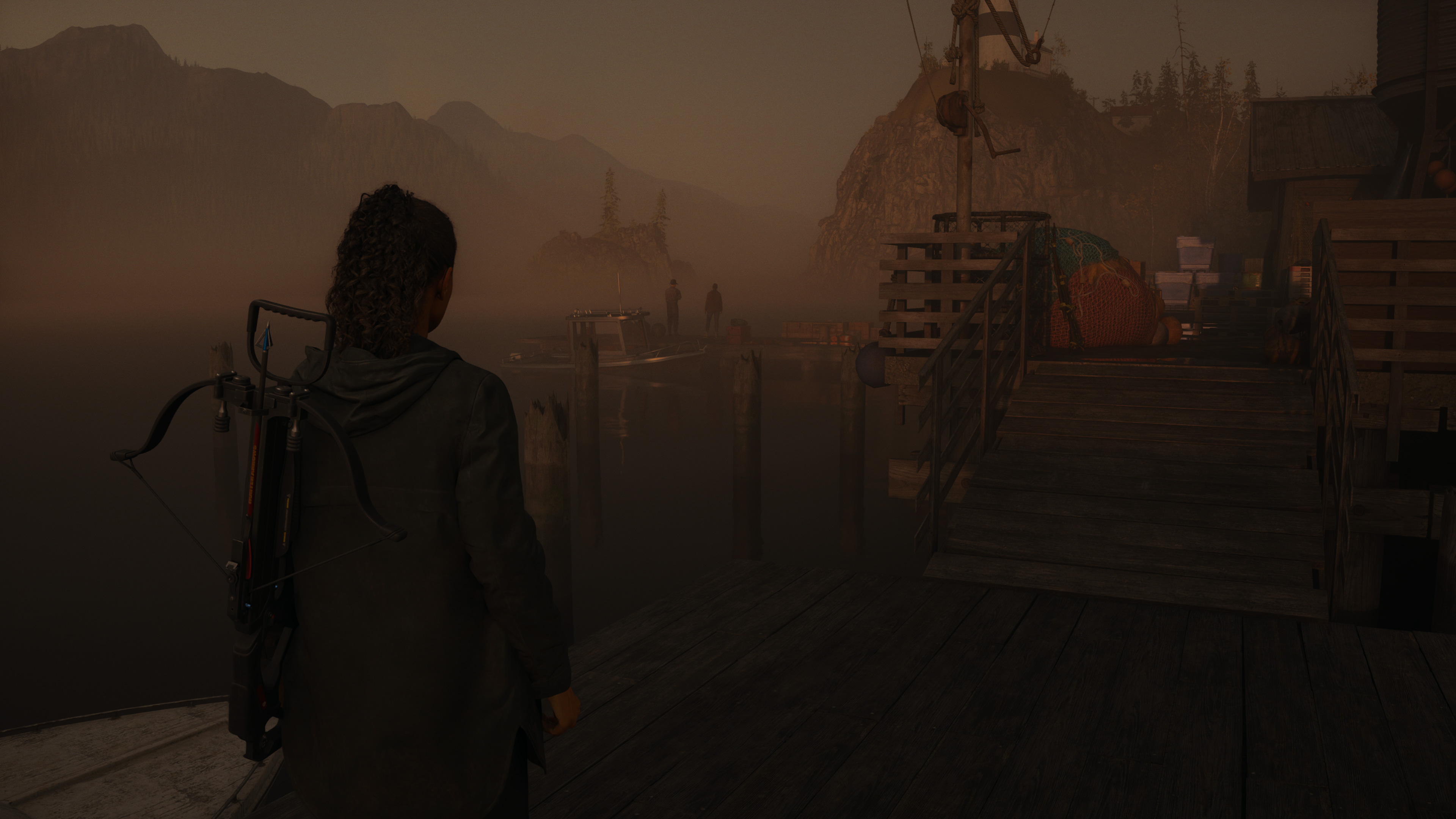
Max Quality plus RT High and Ray Reconstruction
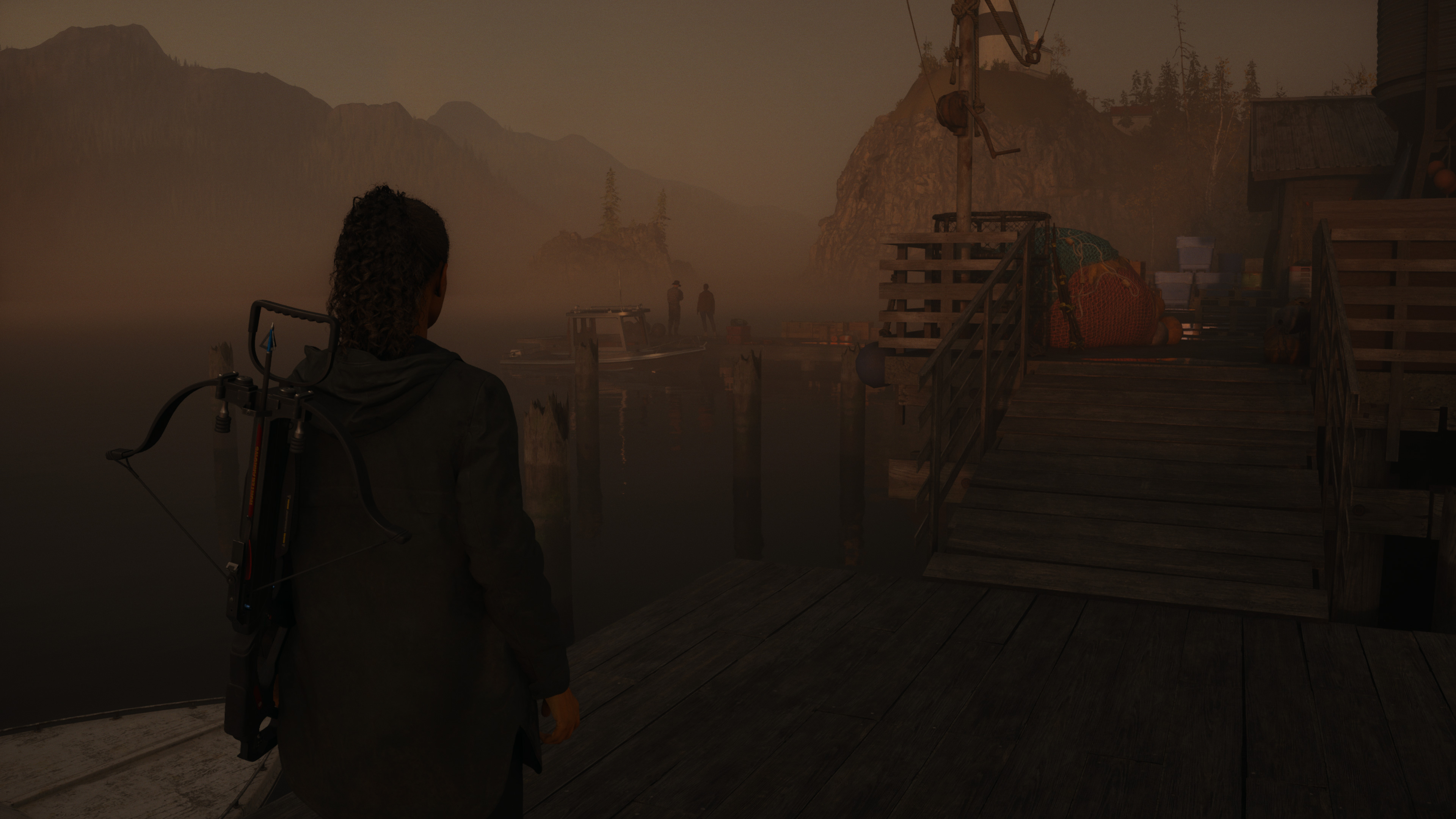
Max Quality plus RT High

Minimum Quality

Low Quality
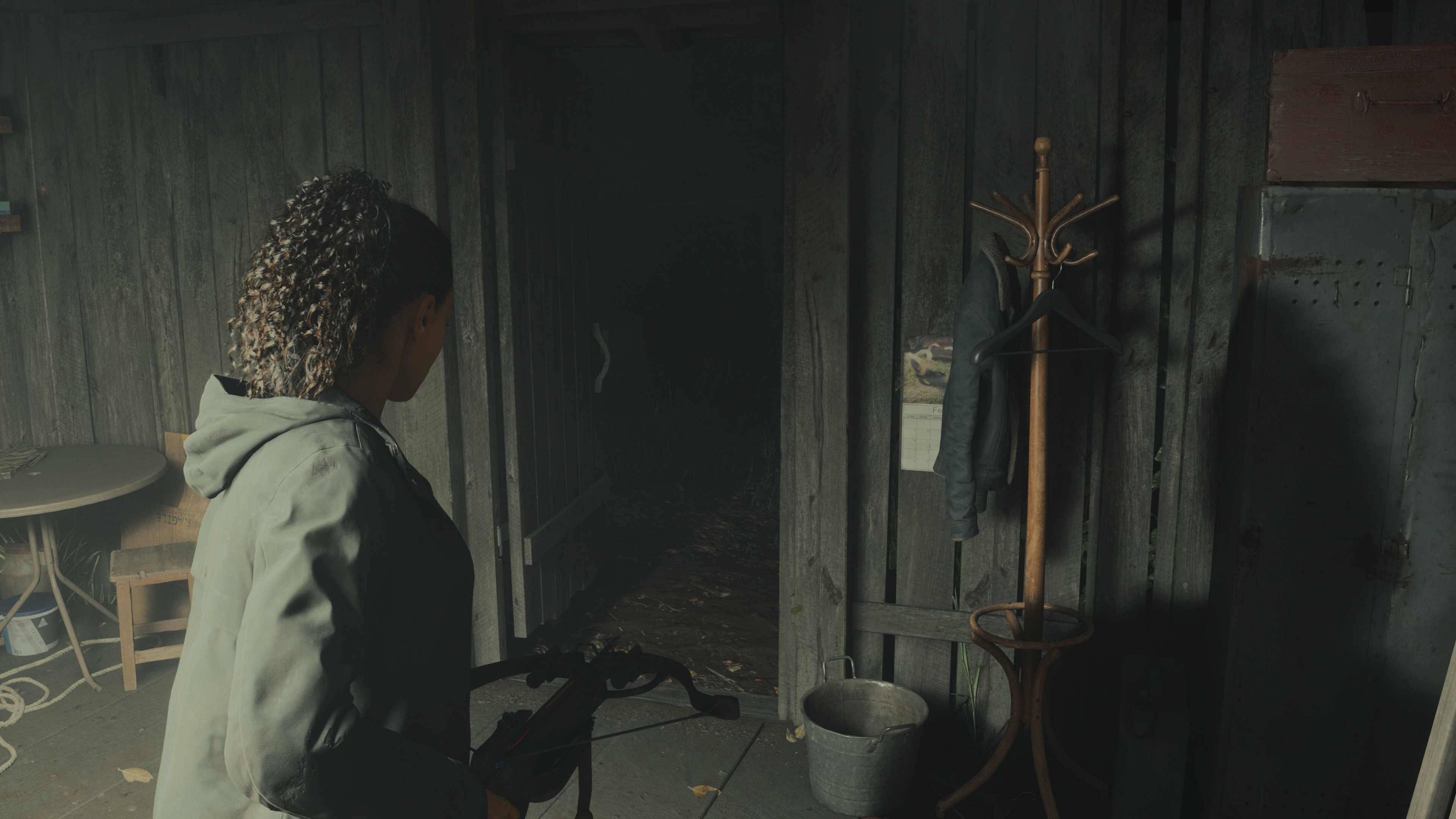
Medium Quality

High Quality
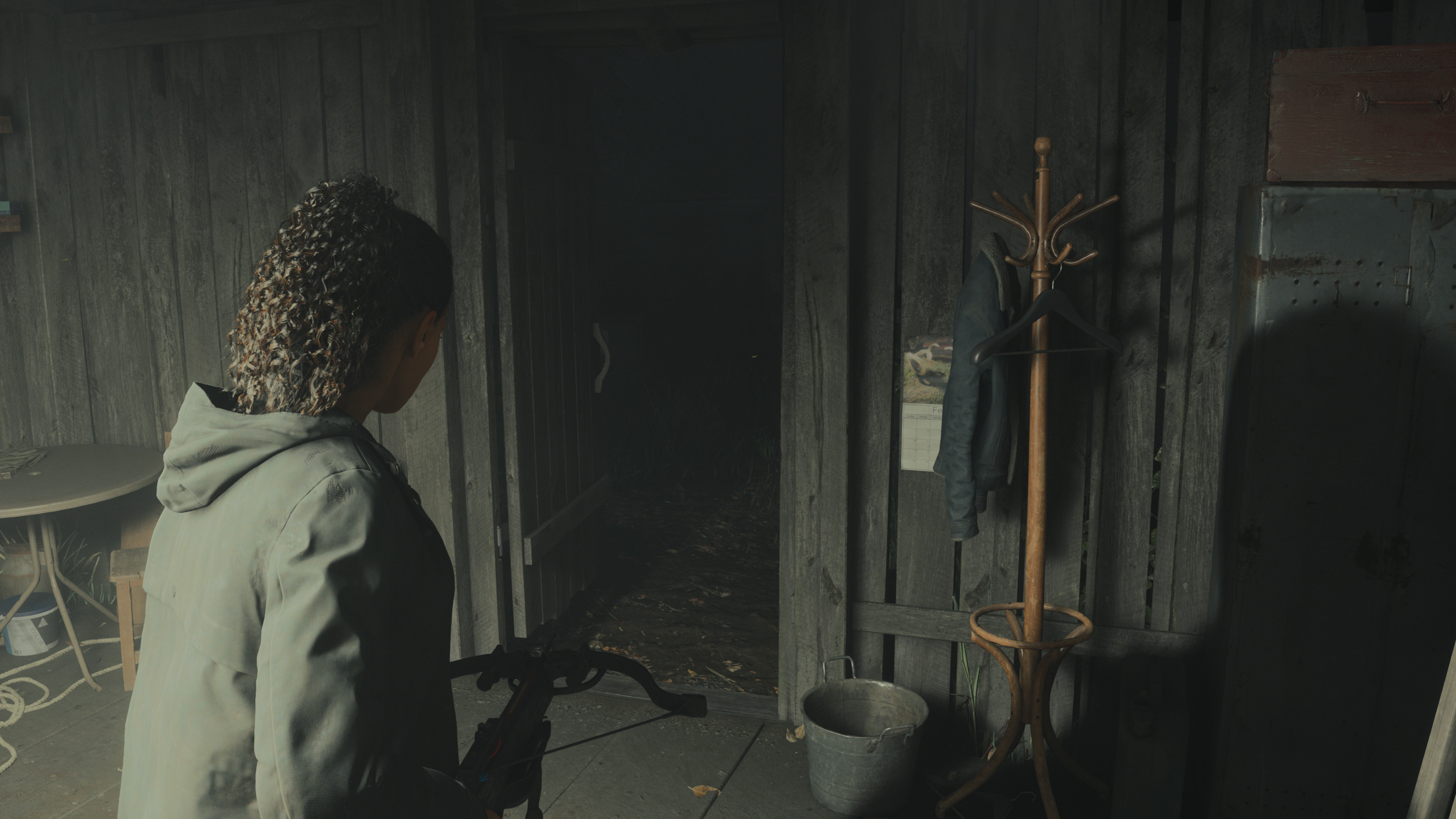
Max Quality (no RT)
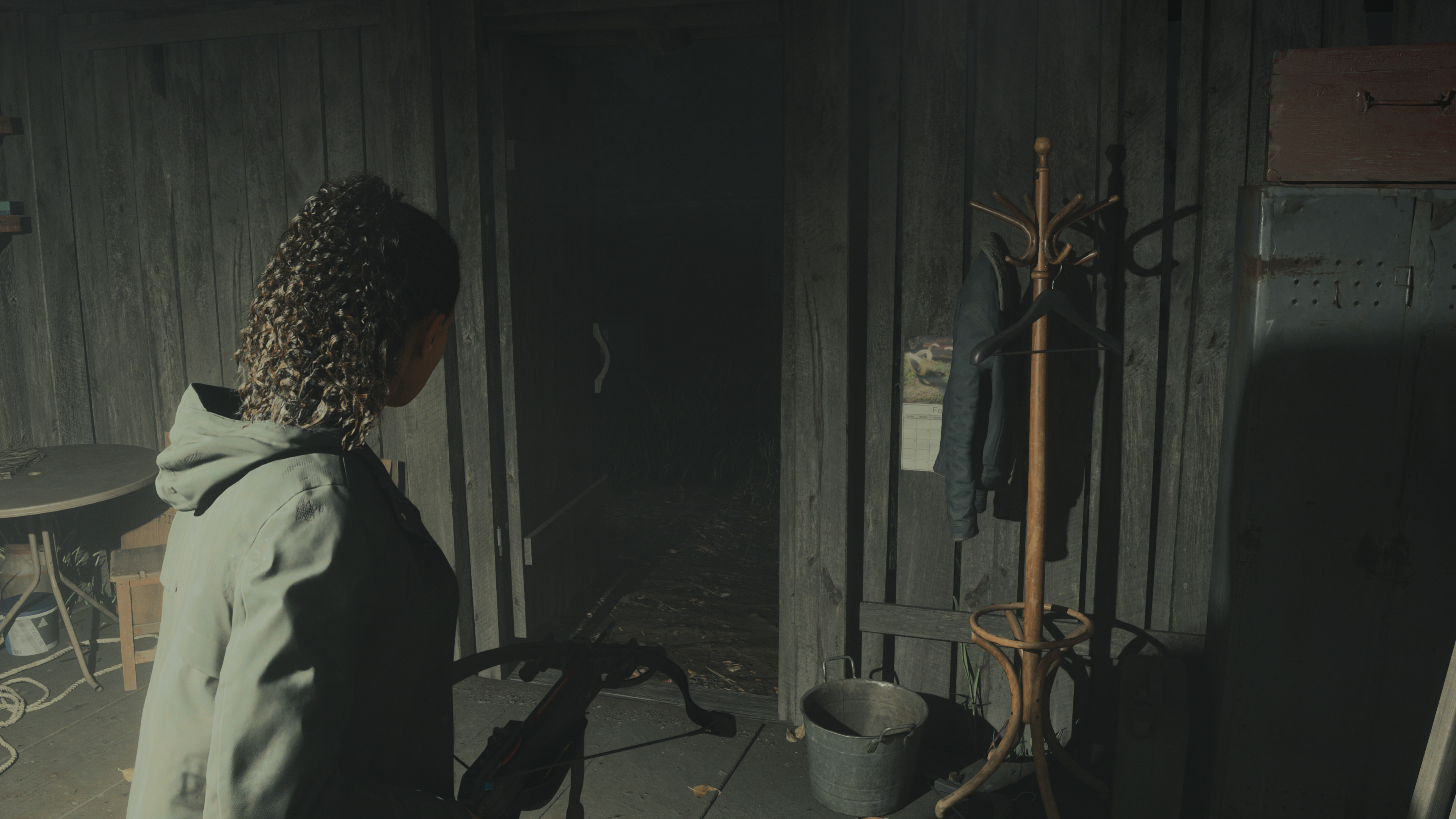
Max Quality plus RT Low and Ray Reconstruction
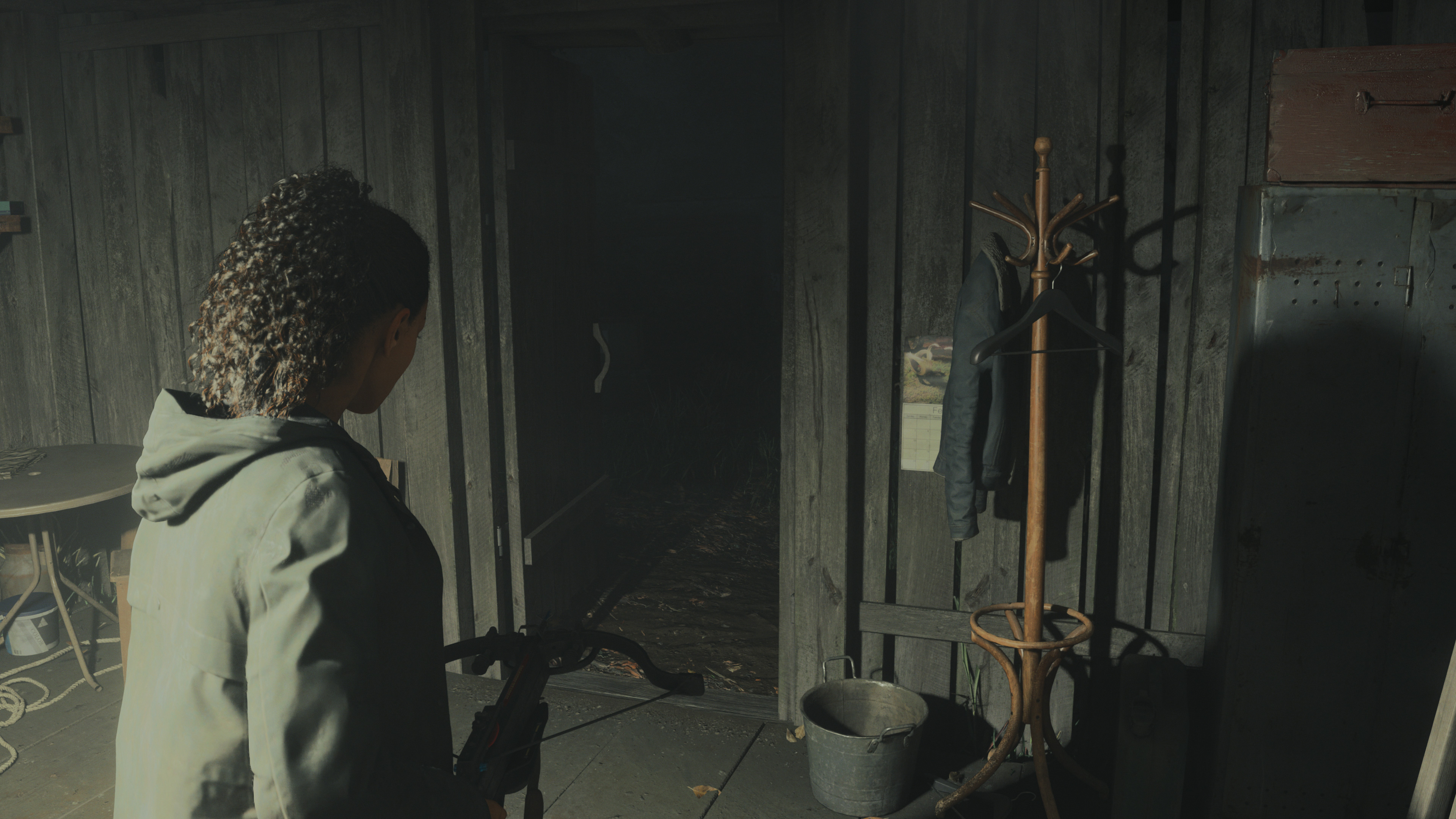
Max Quality plus RT Low
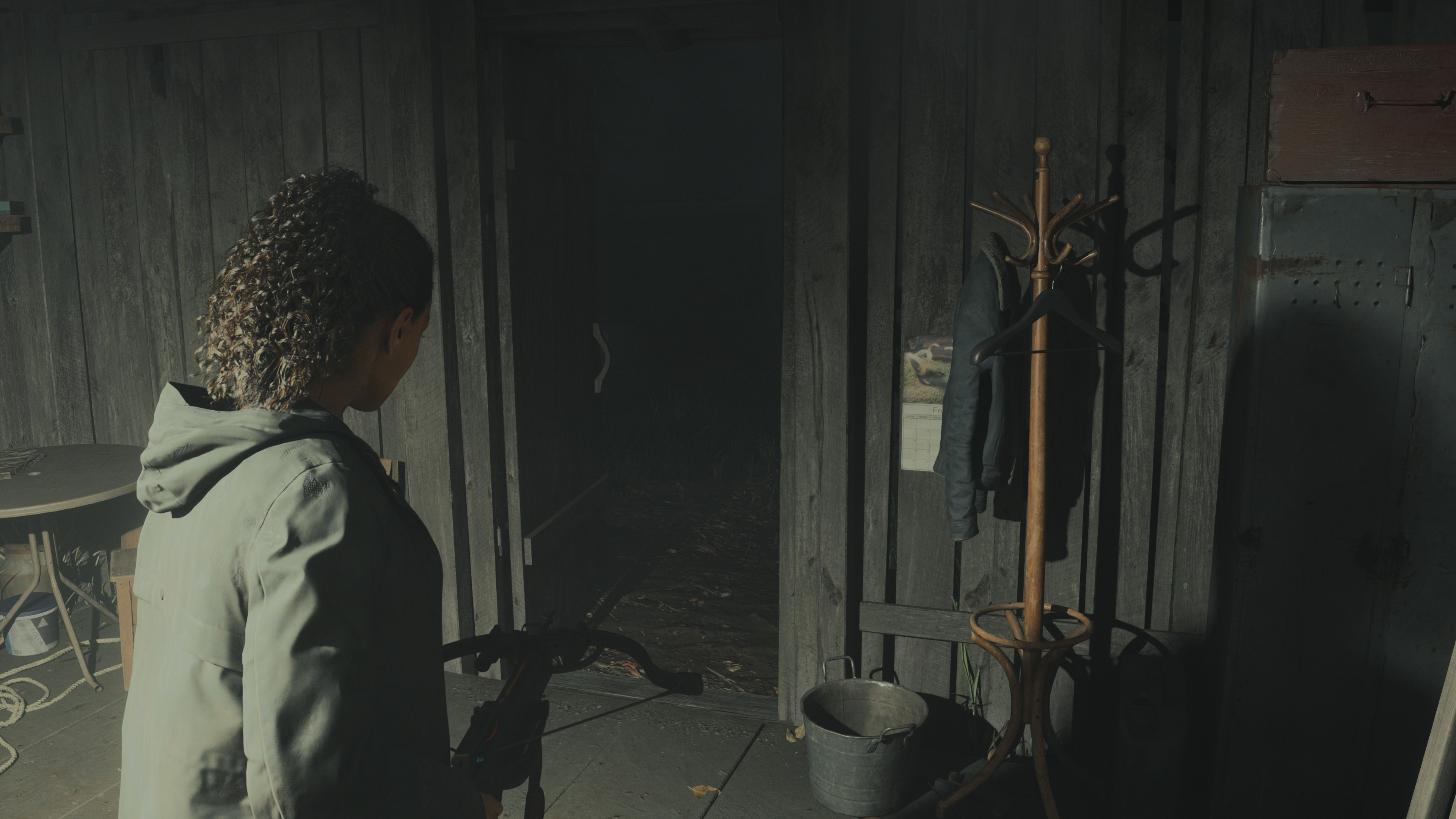
Max Quality plus RT Medium and Ray Reconstruction
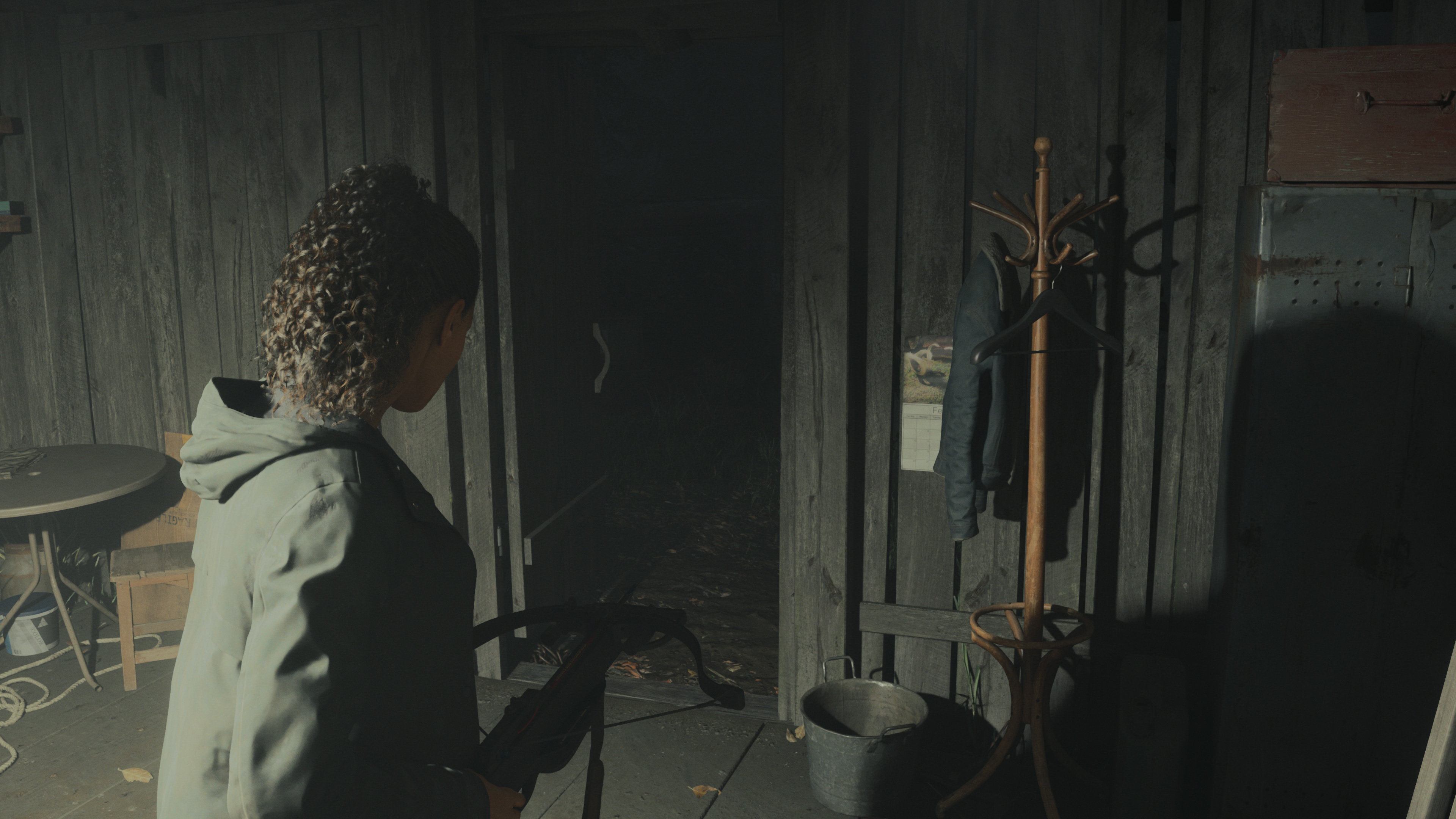
Max Quality plus RT Medium
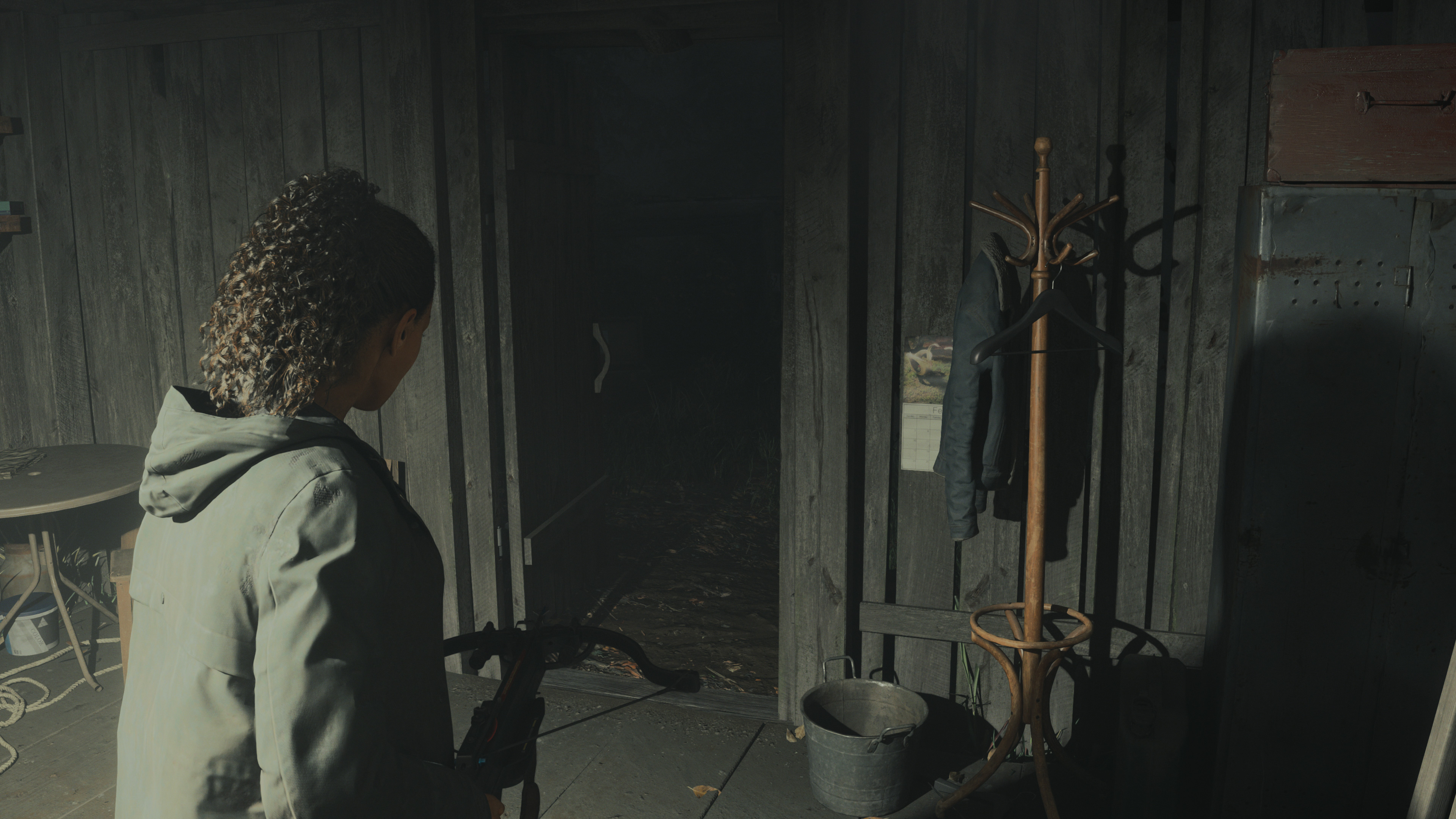
Max Quality plus RT High and Ray Reconstruction

Max Quality plus RT High
There are clear differences in image quality between minimum and low, and from low to medium. Beyond that, at least without ray tracing, the changes aren't as substantial. Basically, even if you want to max out the image quality, you could just start with the medium preset and then add ray tracing. But you can see things with your own eyes in the seven galleries we've included above. They're all 4K images (using DLSS Quality mode upscaling), in the same order each time.
Minimum quality eliminates a lot of extra debris, reflections, and basically anything it can in order to boost performance. Depending on the scene, the difference between minimum and low can range from moderate to severe loss of fidelity. Also, if you get scared easily but still want to play Alan Wake 2, minimum settings will light up the environments more and make them less tense, removing some of the atmosphere from the game.
Medium settings are a good balance of the various settings, and you have to look pretty hard to spot clear differences with the high / max presets. Certain scenes might show a bit more detail on distant objects, but mostly it's just splitting hairs. The difference in performance is more pronounced, dropping fps by around 20%, so if you're trying to balance quality and performance, start with the medium preset.
The ray tracing options mostly show differences in the shadows and reflections, though Ray Reconstruction does cause some other differences. Curiously, the garbage can in the first gallery ends up with whacked out shadows, but that was probably a glitch caused by changing the settings multiple times.
If you view all of the galleries at 100% magnification (or more), the thing you'll notice most is how Ray Reconstruction cleans up a lot of edge blurriness that's otherwise visible. There's also improved lighting, where it seems like the non-RR perhaps cuts off some of the lighting calculations. There are other differences as well, like flickering lights respond more quickly with RR than without — with standard denoising, the results have to accumulate more over time.
Does full RT make Alan Wake 2 look better? Yes, I have no problem stating that. The difficulty is more a case of how much better, and the sizeable performance hit. If you have an RTX 4090, sure, crank up the settings and have fun! If you don't have a beastly GPU, however, it becomes a bit more difficult to decide what settings to run.
With an RTX 4070, at most you can try the RT Medium setting combined with the Medium preset to get a better balance of performance with most of the image fidelity still in tact. That improves performance by 35% compared to maxed out settings with RT High, but it's still only 37 fps at 1440p. Put upscaling at Balanced mode and you get another 15%, and then with Frame Generation you could sort of breach the 60 fps barrier. But that's about the most you can get from a 4070.
AMD's RX 7900 XTX meanwhile ends up slower than the 4070 if you enable path tracing (RT Medium or RT High). There's little doubt that you'll have a better experience with AMD and Intel GPUs if you simply ignore the RT settings, at least with the currently available hardware. Maybe the next generation will significantly boost RT performance, but until then we wait.
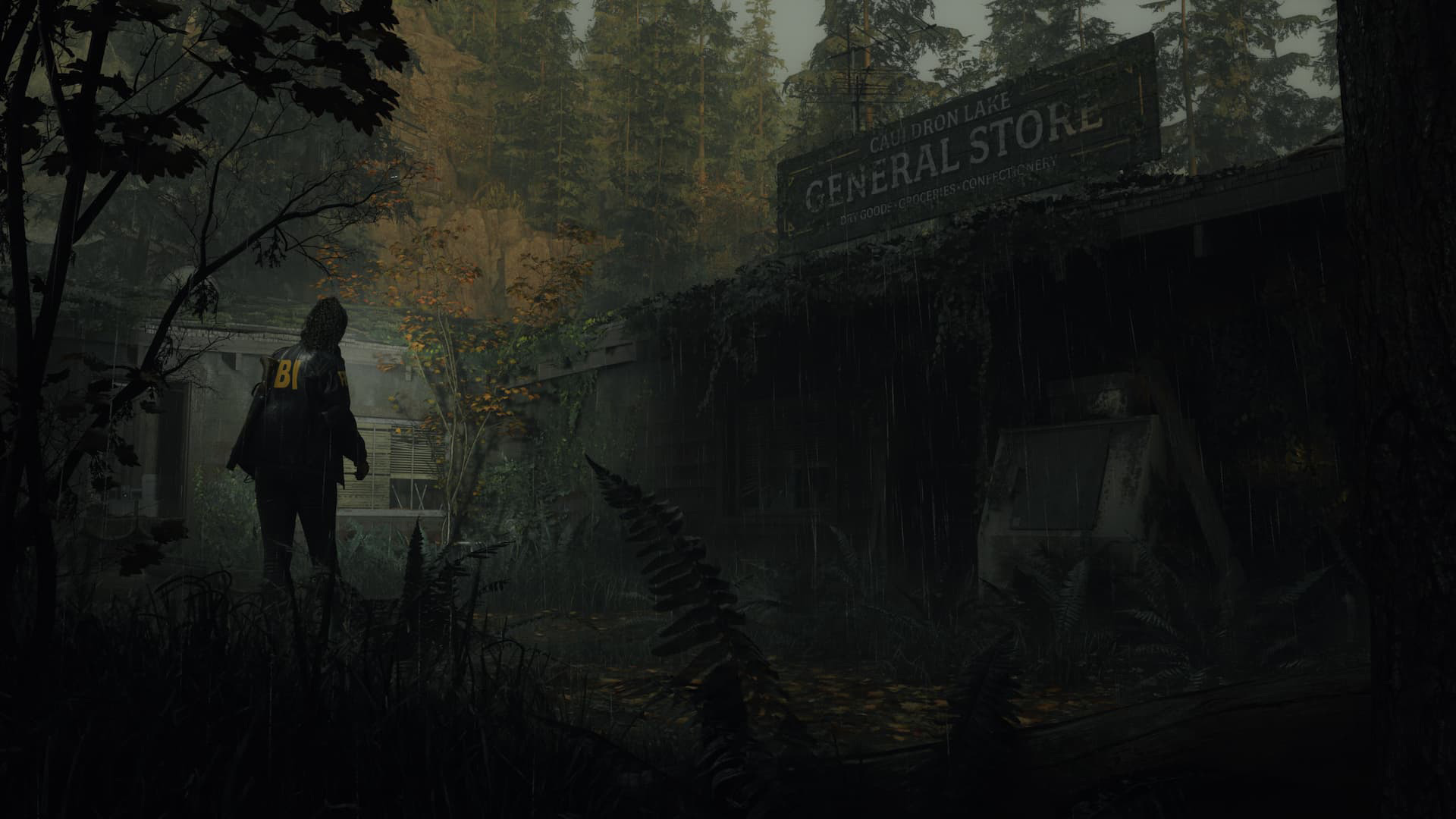
Alan Wake 2 Closing Thoughts
With or without ray tracing and path tracing, Alan Wake 2 is a graphically impressive game. If you have the hardware (basically high-end RTX 40-series), path tracing makes the moody environments even more intense. If you're looking for a good survival horror game, this is certainly one that worth picking up.
On the technical level, though, Alan Wake 2 is a good explanation for why we haven't had full path tracing in most other games yet. Like Cyberpunk 2077 in RT Overdrive mode, it will take everything your GPU can throw at it and then some. If you don't have an Nvidia GPU, you can maybe think about turning on the basic RT effects, but even then you'll need to use upscaling of some form to hit 60 fps or more — and possibly not even then.
The system requirements and recommendations suggest that you need to enable upscaling, but the game does support Native FSR3 and DLAA if you just want the AA and image enhancement without upscaling. As long as you leave off ray tracing, you can even get decent performance on top-shelf GPUs that way. For now, though, this is the most demanding game I can recall seeing.
Because this is the second real implementation of Nvidia's DLSS 3.5 Ray Reconstruction, we can also see where Nvidia's dedication to RT hardware is finally starting to pay off. RR adds detail that is otherwise slightly blurred away, though it still requires that you enable some form of ray tracing. If you're running an RTX 20-series GPU, while it's technically possible to enable RT Low and Ray Reconstruction, even the RTX 2080 Ti will barely break 30 fps, and that's running at 1080p with Quality mode upscaling — 1280x720 upscaling to 1920x1080 to be precise.
We still remember Nvidia talking about the big leap forward that its RTX hardware provided back at the RTX 20-series launch. It would supposedly enable full RT effects ten years before we might otherwise see GPUs fast enough to handle that workload. Five years later, it still feels like we're only about half-way there. RTX 4090 can do path tracing in Alan Wake 2 at 60 fps or more, depending on your upscaling settings and how you want to view Frame Generation, but we're at least two generations of hardware away from that sort of performance hitting the mainstream.
Come 2028 and the RTX 6070, we should finally reach that tipping point. Ten years after the RTX 20-series and apparently right on schedule. But like the Field of Dreams, you have to build it (RT hardware) before they (the game devs) will come. And when that day potentially arrives, Nvidia doesn't seem particularly worried about the competition. It plans to have the one RT ring to rule us all, barring any massive changes.

Jarred Walton is a senior editor at Tom's Hardware focusing on everything GPU. He has been working as a tech journalist since 2004, writing for AnandTech, Maximum PC, and PC Gamer. From the first S3 Virge '3D decelerators' to today's GPUs, Jarred keeps up with all the latest graphics trends and is the one to ask about game performance.
-
JTWrenn Talking about the 3080 as being the bottom for some features then not testing it and instead opting for a 2080 ti is just infuriating. It makes no sense at all especially on a game that is so feature specific. Tomshardware has skipped the 3080 in several tests recently and I just don't get it.Reply -
Amdlova Reply
@JarredWaltonGPU uses the gpu he have... and the 2080ti is good for old hardware compatibility.JTWrenn said:Talking about the 3080 as being the bottom for some features then not testing it and instead opting for a 2080 ti is just infuriating. It makes no sense at all especially on a game that is so feature specific. Tomshardware has skipped the 3080 in several tests recently and I just don't get it. -
emike09 It is quite demanding, for sure. Playing on an overclocked 4090 on liquid with an i9-10920X @ 5Ghz. It's very much GPU bound. FG on, DLSS at quality, max settings, max RT/Pathtracing, and I'm getting about the same results as the benchmark above. However, even though I've gotten used to 120fps gaming on the 4090, I honestly don't mind averaging around 60fps for a game like this. It's slow paced and film-like enough that there's no need to go above 60fps. Even when it dips down to 50fps, I don't mind. It 'kinda' gives it that 24p film experience without having that weird soap-opera feel. VRR, Freesync, or G-Sync are also super handy for a tear-free clean experience.Reply
The game is gorgeous. Watching the shadows of the moon play on the environment from a window blowing in the wind behind me is unworldly. The immersion is amazing. The world lighting is constantly changing as trees sway, a car drives by, something moves through a light, casting shadows, or watching a room slowly fill with light as a character approaches with their flashlight. The GI, reflections, shadows, and lighting are spot on.
They also have properly implemented HGiG. If you have and HDR10+ or Dolby Vision TV/Monitor, especially OLED with HGiG support, you can finally experience gaming the way HDR10+ was meant to be. Dynamically adjusting tone mapping, brightness, contrast, gamma, etc looks so good. No color banding in gradients. Shadows are dark and moody. Bright lights blind you at first. I love that.
I'm about 10 hours in and haven't experienced any bugs of any kind. No shader compilation issues. It just works on day one. This is a rare thing these days.
Now if only Epic Game Store would allow us to disable achievement notifications!!! I'm sitting here scared out of my mind, loving everything about it, then "DING DING DING!!!!! YOU HAS ACHIEVEMENT!!!!". Immersion ruined. Thanks Epic. I hate you for having a terrible launcher and not releasing a game on Steam, where it belongs. -
nitrium I guess I'll be targeting 30 fps on my RTX 2060 6GB. For this type of "cinematic" game that will hopefully be okay. Paying twice as much as my 4 year old GPU cost to get twice the performance is simply a non-starter (i.e. I would have to get an RTX 4070 to get that and it costs twice as much as my RTX 2060 did). I mean if SLI was still a thing I could have gotten twice the performance for twice the money 4 years ago (by buying two RTX 2060's).Reply -
emike09 Reply
Well, far from true. SLI usually gave around 20-60% increased performance, but the tearing and micro-stutters were absolutely terrible. I ran SLI on a couple different generations (GTX 480 and 680), and even though it was faster, the problems SLI had were very annoying. And the game had to support it as well, which many didn't. DX12 Multi-GPU was supposed to be an alternative to SLI that was more forgiving of mixing different card types, didn't require a bridge, but it never took off and kinda died right after it was released back in 2015/2016. It also required support from the game dev. If ever a true multi-gpu alternative was released, I'd pop in another 4090! You know Nvidia wants me to buy another one.nitrium said:I mean if SLI was still a thing I could have gotten twice the performance for twice the money 4 years ago (by buying two RTX 2060's). -
JarredWaltonGPU Reply
You can’t test everything, every time. Look at the 3090 and 4070, extrapolate from there. 3080 usually delivers about the same performance as the 4070. The 2080 Ti was because I wanted to see how the first generation RTX architecture held up.JTWrenn said:Talking about the 3080 as being the bottom for some features then not testing it and instead opting for a 2080 ti is just infuriating. It makes no sense at all especially on a game that is so feature specific. Tomshardware has skipped the 3080 in several tests recently and I just don't get it. -
HyperMatrix I’m going to call this game out for lack of optimization. In one of the first forest scenes after you perform a ritual, where you see the trees lit with red lights, FPS drops to the 40s even on an RTX 4090 with DLSS Quality and Frame Gen on. I don’t think it’s acceptable as there’s not enough going on to justify 43fps or whatever the lowest I got was in that scene. Considering it’s with DLSS Quality and Frame Generation on an overlocked 4090 rocking over 3000MHz with unlocked power limit.Reply
I had to resort to playing the game with a controller on the couch to cover up the low fps issues that become much more noticeable with a mouse. I wasn’t willing to drop settings and lower the visuals. :P Because the game does look great. But in some areas the visuals just don’t justify the cost. -
JTWrenn Reply
Sure but the 3080 is not everything...it was the top end last generation. You mentioned the card, you should test the card. With a game that is so specific about the versions of tech being used, not just the horsepower to do this just seems very odd to me. You tested a whole lot of cards here, not doing the 3080 but doing the 2080 ti and the 4090, and the 3090 seems very strange to me. Get rid of the 4070 and test the 3080 would have fit much better in your scheme considering you didn't test any other 70's.JarredWaltonGPU said:You can’t test everything, every time. Look at the 3090 and 4070, extrapolate from there. 3080 usually delivers about the same performance as the 4070. The 2080 Ti was because I wanted to see how the first generation RTX architecture held up.
Sorry this just seems weird to me (site not you) and you have done it multiple times. To skip over one of the most used cards and then just say meh too much to add that...I just don't get it. Can you test everything? No, but the 3080 is pretty damn main stream...much more so than the 3090 or 4090 at the very least. -
JTWrenn Reply
I get having the 2080ti but not in place of a 3080 and I don't get the 4070...as the only 70 card without a 3080. It's a weird progression that would work better without the 4070 and with the 3080 or without the 2080ti. It muddies the water on how they progress given all the versions of hardware acceleration brought into play here, and just leaves out one of the most popular cards of recent years in favor of a 2 generation old one, or the most recent gen version.Amdlova said:@JarredWaltonGPU uses the gpu he have... and the 2080ti is good for old hardware compatibility.
Hell don't do the 3090 and do the 3080 or don't do the 3060 but do the 3080...there are a lot of things here that seem out of bounds from the comparable systems here. I mean 4090, 4080, 4070, 4060, 3090, 3060? Seems odd to me. -
Thunder64 ReplyJTWrenn said:I get having the 2080ti but not in place of a 3080 and I don't get the 4070...as the only 70 card without a 3080. It's a weird progression that would work better without the 4070 and with the 3080 or without the 2080ti. It muddies the water on how they progress given all the versions of hardware acceleration brought into play here, and just leaves out one of the most popular cards of recent years in favor of a 2 generation old one, or the most recent gen version.
Hell don't do the 3090 and do the 3080 or don't do the 3060 but do the 3080...there are a lot of things here that seem out of bounds from the comparable systems here. I mean 4090, 4080, 4070, 4060, 3090, 3060? Seems odd to me.
Talk about complaining over nothing. Newer hardware always gets benched more. Also, since when has any 80 series card been one of the "most popular"? There are plenty of other sources you can check out for 3080 numbers.
